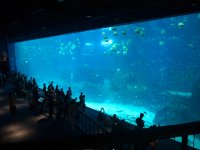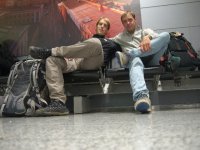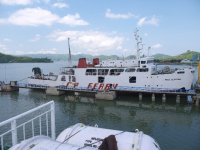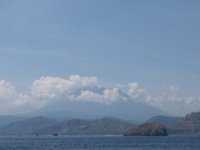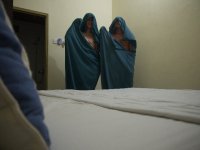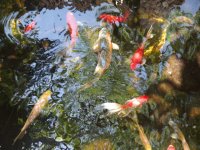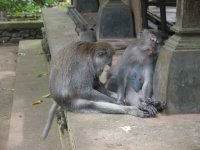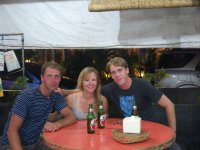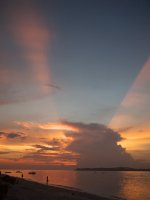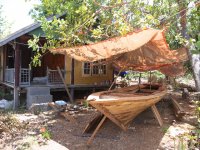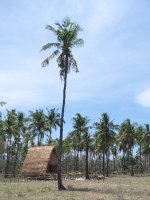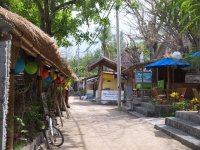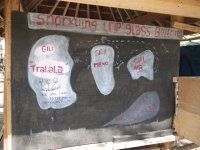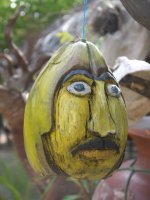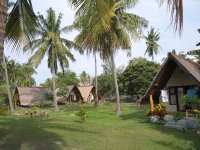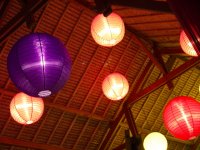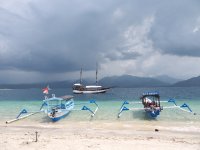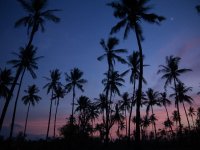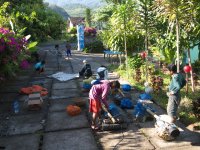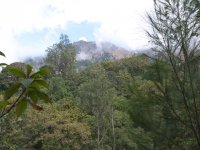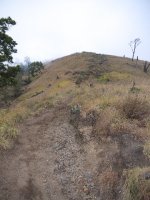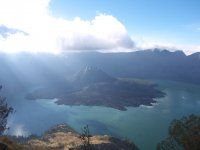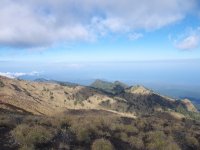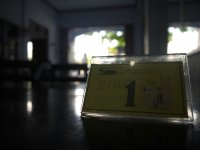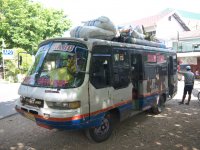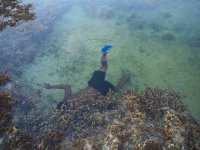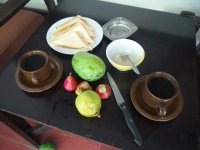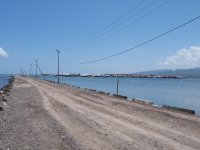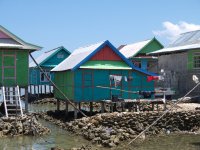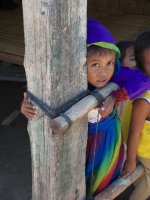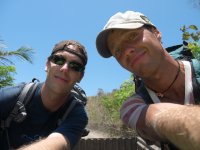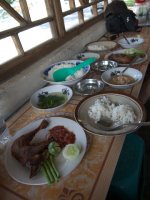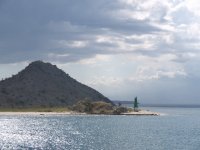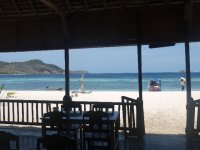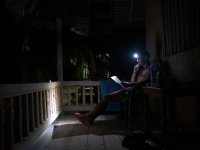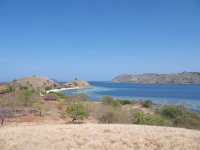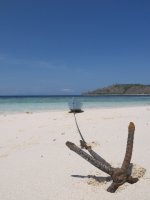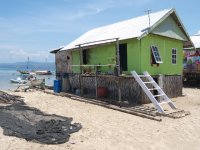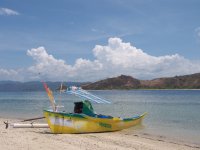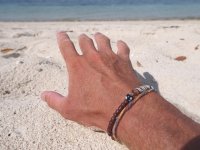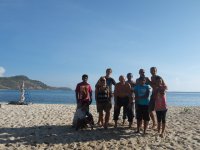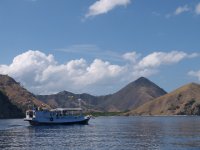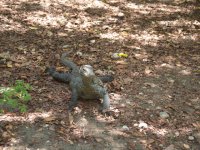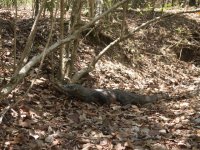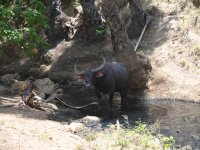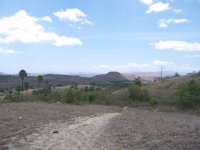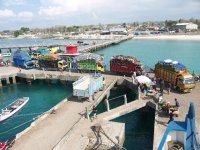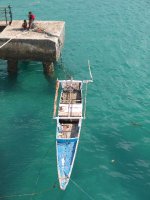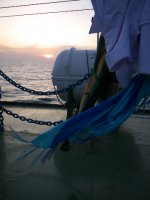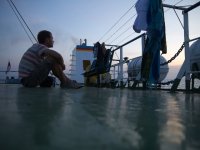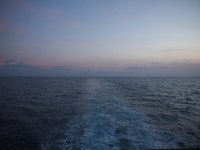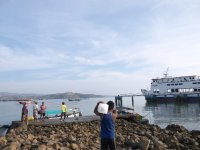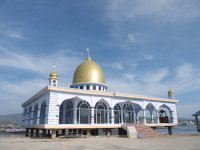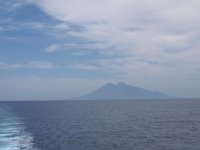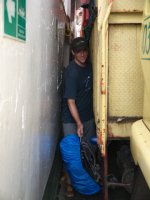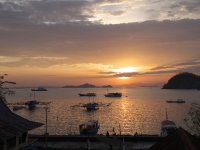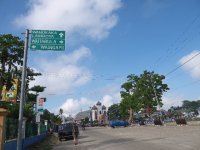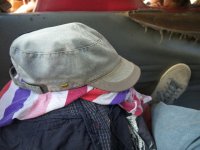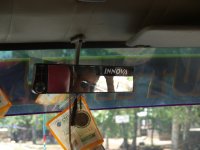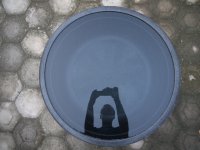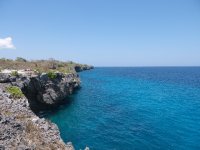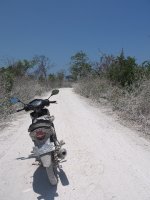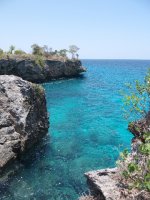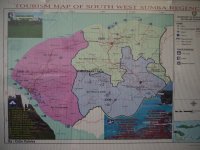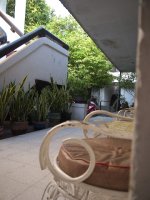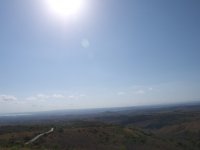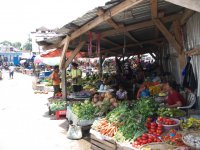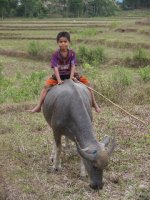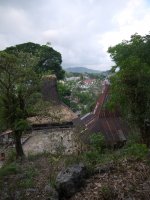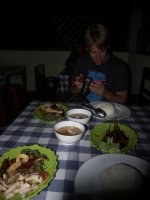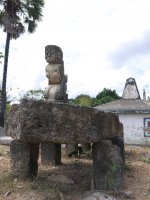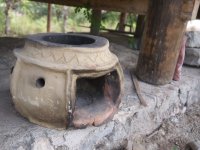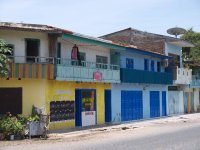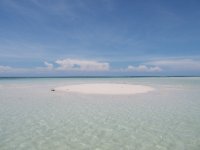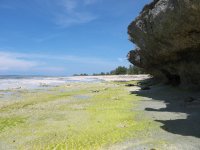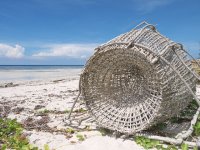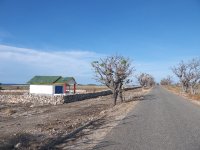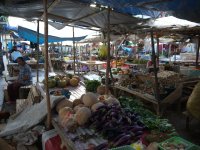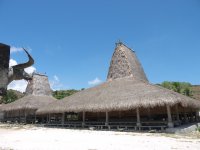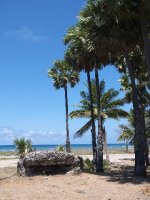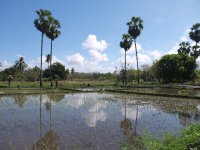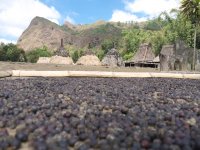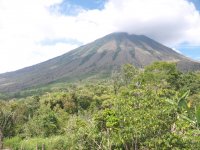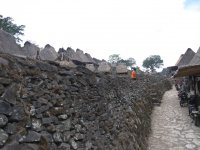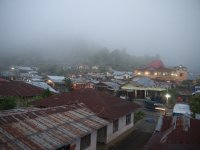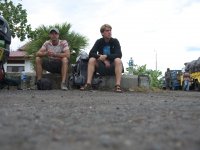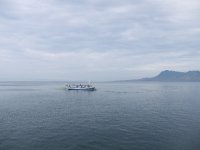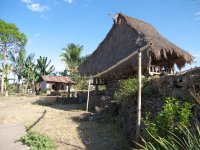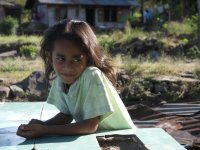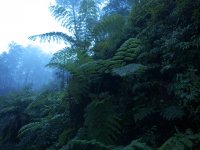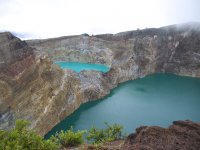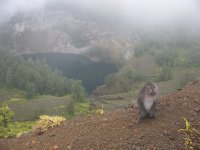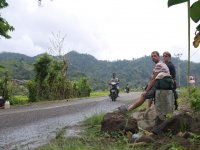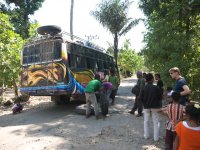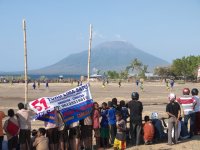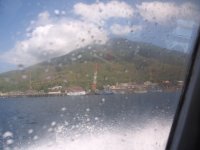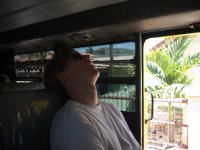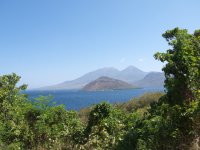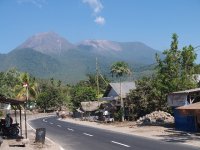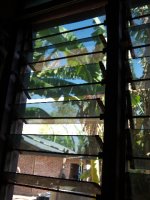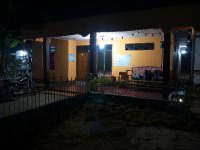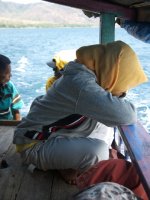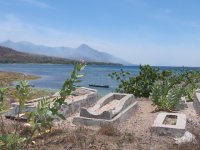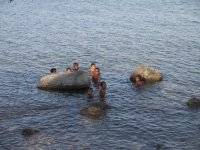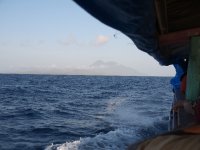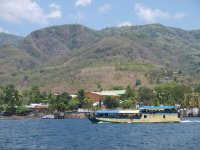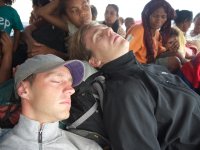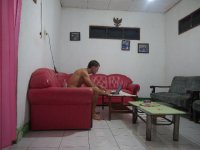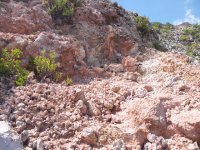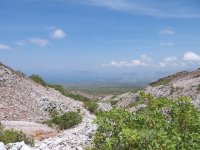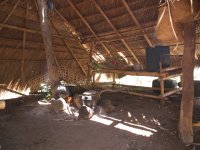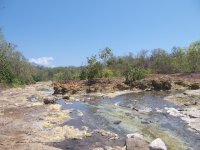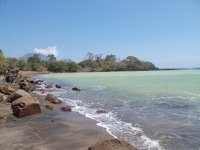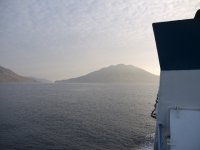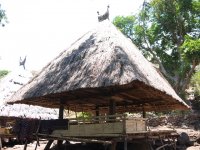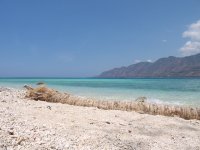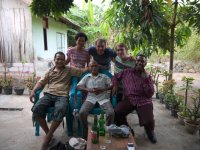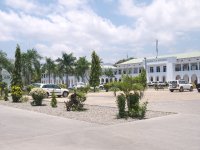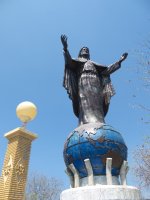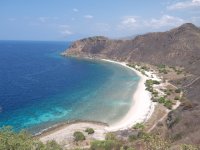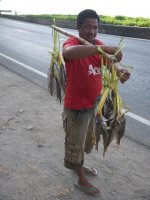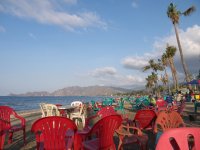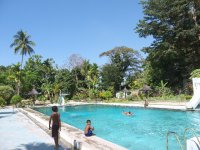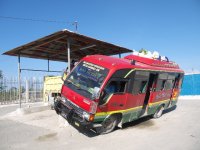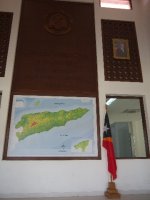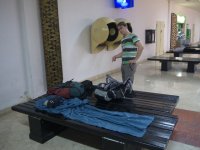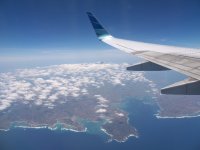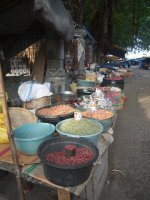20. Svajoti ir ilgėtis | Dream and miss
Saulius , 2013-11-24
LT. Svajoti ir ilgėtis. Du žmogiškieji jausmai, kurie mus verčia: pirmasis – siekti, tikėti ir žengti į priekį, antrasis - gerbti ir mylėti tai, ką jau esame sukūrę, trokštant visa tai perkelti į ateitį. Kad pasaulis niekada nesibaigtų, kad jis žengtų pirmyn, kad būtų tęstinumas. Manau nebijome nieko labiau nei pabaigų, ir niekada nesusitaikysime su tuo, kad tai, kas gera, įvyko paskutinį kartą. Tai žmogiška. Ir todėl svajojame ir ilgimės. Kad nebūtų pabaigų, kad niekada nebūtų paskutinio karto.
Su kelionėmis yra taip pat: galvodamas apie būsimas keliones svajoju, o prisimindamas praėjusias ilgiuosi. Kažkada galvojau, kad keliauti yra tik etapas, gyvenimo tarpsnis, kuris pasibaigia ir tu „užsiimi kažkuo kitu“, tačiau dabar žinau, kad tai yra didelė mano pažinimo kelio dalis, kuri negali baigtis: keliausiu visą likusį gyvenimą savo tikrovėje ir sapnuose. Nes keliauti taip nuostabu, kad net sunku apsakyti, nes kaskart keliaudamas augu ir sustiprėju, kitaip suprantu laiką ir žmones, nurimstu viduje, džiaugiuosi kaip vaikas kiekvienu mažu atradimu, o po kelionių esu... kitoks – geresnis žmogus. Argi galima apie tai nesvajoti ir to nesiilgėti, nemylėti tų buvusių ir būsimų akimirkų? Ir ši kelionė – ne išimtis. Aš jos labai ilgiuosi, ji mano širdyje, ją, kiekvieną momentą, visada prisiminsiu, ji, kaip ir visos buvusios – geriausia. Ir jau svajoju apie kitas keliones. Taip, jos būna išsvajotos.
Pabaigdamas noriu padėkoti savo draugui Gael‘iui už pasirįžimą ir drąsą. Žmogau, be tavęs tai nebūtų įvykę, arba, mažų mažiausiai, nebūtų buvę taip. Mes dar daug nuveiksime kartu. Ir savo kuprinei (dievuliau, jai jau 15 metų, ir ji visur su manimi!). Ir kepurei „Lithuania“, kuri kažkada buvo violetinė, o dabar, po šitiek metų saulės ir prakaito, yra beveik balta. Ir... likimui, kuris mane taip visad myli ir saugo. Iki, mielieji, iki kitų kelionių! Iš visos širdies,
EN. Dream and miss. Two very human senses that make us seek, believe and go forward, and love the past wishing that it, in any form, repeats in the future. For the World never to end, go forward, for continuity. I think what we are afraid most is the end and we simply cannot be comfortable with the thought that something good happened to us for the last time. It is very human. And that is why we dream and miss. For there to be no end, no last times.
Same with journeys. I dream of the future ones and miss when remember the past ones. There was time when I thought that travels is just one stage of my life which has an end and after it you “start with something else” but now I know it is a big part of my cognition and it cannot end: I’ll travel all my remaining life in my dreams and reality. Because to travel is so beautiful that you even cannot find words to tell it. Because every time I travel I grow and get stronger, see time and people in different light, become calmer and happy like child discovering new. Because after travels I am… different, better person. Can you not dream and miss, not love these past and future moments? And this journey was no exception. I miss it very much, it is in my heart, I’ll remember every moment of it, it, like all other journeys, is the best. And dreams of other journeys are already in me. Yes, all of them come out of dreams.
In the end I wanted to thank. My friend Gael for determination and courage. Man, it couldn’t have happened without you or, least to say, it would not have been the same. We still have much to do together. And my bag… it now has been 15 years that we are together! And my hat “Lithuania” which was violet once but after so many years of sun, sweat and salty waters turned almost white. And my fate. For guarding me and taking care of me. See you my dear friends, see you in other adventures! With all my heart,
Saulius
Su kelionėmis yra taip pat: galvodamas apie būsimas keliones svajoju, o prisimindamas praėjusias ilgiuosi. Kažkada galvojau, kad keliauti yra tik etapas, gyvenimo tarpsnis, kuris pasibaigia ir tu „užsiimi kažkuo kitu“, tačiau dabar žinau, kad tai yra didelė mano pažinimo kelio dalis, kuri negali baigtis: keliausiu visą likusį gyvenimą savo tikrovėje ir sapnuose. Nes keliauti taip nuostabu, kad net sunku apsakyti, nes kaskart keliaudamas augu ir sustiprėju, kitaip suprantu laiką ir žmones, nurimstu viduje, džiaugiuosi kaip vaikas kiekvienu mažu atradimu, o po kelionių esu... kitoks – geresnis žmogus. Argi galima apie tai nesvajoti ir to nesiilgėti, nemylėti tų buvusių ir būsimų akimirkų? Ir ši kelionė – ne išimtis. Aš jos labai ilgiuosi, ji mano širdyje, ją, kiekvieną momentą, visada prisiminsiu, ji, kaip ir visos buvusios – geriausia. Ir jau svajoju apie kitas keliones. Taip, jos būna išsvajotos.
Pabaigdamas noriu padėkoti savo draugui Gael‘iui už pasirįžimą ir drąsą. Žmogau, be tavęs tai nebūtų įvykę, arba, mažų mažiausiai, nebūtų buvę taip. Mes dar daug nuveiksime kartu. Ir savo kuprinei (dievuliau, jai jau 15 metų, ir ji visur su manimi!). Ir kepurei „Lithuania“, kuri kažkada buvo violetinė, o dabar, po šitiek metų saulės ir prakaito, yra beveik balta. Ir... likimui, kuris mane taip visad myli ir saugo. Iki, mielieji, iki kitų kelionių! Iš visos širdies,
EN. Dream and miss. Two very human senses that make us seek, believe and go forward, and love the past wishing that it, in any form, repeats in the future. For the World never to end, go forward, for continuity. I think what we are afraid most is the end and we simply cannot be comfortable with the thought that something good happened to us for the last time. It is very human. And that is why we dream and miss. For there to be no end, no last times.
Same with journeys. I dream of the future ones and miss when remember the past ones. There was time when I thought that travels is just one stage of my life which has an end and after it you “start with something else” but now I know it is a big part of my cognition and it cannot end: I’ll travel all my remaining life in my dreams and reality. Because to travel is so beautiful that you even cannot find words to tell it. Because every time I travel I grow and get stronger, see time and people in different light, become calmer and happy like child discovering new. Because after travels I am… different, better person. Can you not dream and miss, not love these past and future moments? And this journey was no exception. I miss it very much, it is in my heart, I’ll remember every moment of it, it, like all other journeys, is the best. And dreams of other journeys are already in me. Yes, all of them come out of dreams.
In the end I wanted to thank. My friend Gael for determination and courage. Man, it couldn’t have happened without you or, least to say, it would not have been the same. We still have much to do together. And my bag… it now has been 15 years that we are together! And my hat “Lithuania” which was violet once but after so many years of sun, sweat and salty waters turned almost white. And my fate. For guarding me and taking care of me. See you my dear friends, see you in other adventures! With all my heart,
Saulius
„Kaip žmonės patirtų pasaulio grožį, jo didybę, jeigu jie nekeliautų?“ | “Would people realize, experience the beauty and glory of the World if they wouldn’t travel?”
Jonas Čerskis
Statistika | Stats:
LT. Trukmė: 45 d.; pagrindinės aplankytos vietos: 45; skirtingos nakvynės: 30; transportas: laivai, keltai, autobusai, automobiliai, motoroleriai, bemo, ojek; ilgiausia kelionė: Weetabula-Waikelo-Sape-Labuan Bajo = 31 h; laikas transporte: 190 h (18% viso kelionės laiko); laivai ir keltai: 16, 1150 km; žeme: 3100 km; skrydžiai: 8, 25000 km; paplūdymiai: 20.
EN. Duration: 45 days; sites visited 45; overnight places: 30; transport: boat, ferry, bus, car, scooter, bemo, ojek; longest journey: Weetabula-Waikelo-Sape-Labuan Bajo = 31 h; time in main transport: 190 h (18% of journey time); boats and ferries: 16, 1150 km; ground: 3100 km; flights: 8, 25000 km; beaches: 20.
LT. Trukmė: 45 d.; pagrindinės aplankytos vietos: 45; skirtingos nakvynės: 30; transportas: laivai, keltai, autobusai, automobiliai, motoroleriai, bemo, ojek; ilgiausia kelionė: Weetabula-Waikelo-Sape-Labuan Bajo = 31 h; laikas transporte: 190 h (18% viso kelionės laiko); laivai ir keltai: 16, 1150 km; žeme: 3100 km; skrydžiai: 8, 25000 km; paplūdymiai: 20.
EN. Duration: 45 days; sites visited 45; overnight places: 30; transport: boat, ferry, bus, car, scooter, bemo, ojek; longest journey: Weetabula-Waikelo-Sape-Labuan Bajo = 31 h; time in main transport: 190 h (18% of journey time); boats and ferries: 16, 1150 km; ground: 3100 km; flights: 8, 25000 km; beaches: 20.
19. Balis. Sugrįžimas | Return to Bali
Saulius , 2013-11-10
LT. Palikti Lombok'ą nebuvo lengva, nes tai reiškė tik viena - paliekame nuostabiąją Indonezijos dalį Nusa Tenggara, arba kitaip, Rytines žemes. Buvo šiek tiek liūdna, nes atsisveikinti paprastai niekada nemokėjau ir tikriausiai esu per senas, kad išmokčiau:), tačiau šie jausmai turėtų būti suprantami tiems, kurie matė, jautė ir suprato, kiek širdies į šią kelionę įdėjome. Ir kiek širdies, šypsenų ir nuostabiausių potyrių bei vaizdų keliaudami gavome. Sėdėjau ant kelto iš Lembar'o į Padang Bai, Balyje, denio, šildydamasis saulėje, ir negalėjau akių atitraukti nuo kiekvieną minutę vis didingiau virš manęs kylančio Agung'o ugnikalnio. Būčiau galėjęs taip sėdėti ištisas dienas.
Balyje jau esu buvęs, tačiau nebuvau atkeliavęs iš kitos pusės. Laiko turėjome per mažai, kad nuvyktume į atokesnes vietas (juk Balis - paprasčiausiai mūsų skrydžio namo pradžios taškas) todėl iškart nukeliavome į Ubud'ą. Keista, praėjo tik pora metų, o viskas pasikeitė, t. y. restoranų, parduotuvių ir viešbučių tikrai padaugėjo. Galima net sakyti, kad Ubud'as dabar sausakimšas. Kas tuomet vyksta „sezono“ metu? Pirmąjį vakarą nebenuėjome niekur, aplankėm tik kelis barus:), tačiau kitądien išlandžiojom visą beždžionių mišką (Monkey Forest) ir apėjome ryžių terasas. Jei kada turėsite progą čia pabūti, pačiame centre galite apsistoti Jl. Gootama keletame nebrangių, bet labai gražių ir ramių viešbutukų su sodais(pvz., Mai Malu), čia rasite ir puikių balinietiškų restoranų.
Pavakary galiausiai patraukėm į Sanur'ą, kur, kaip ir praeitą kartą apsistojome nuostabiame Big Pineapple Backpacker's hostelyje ir susitikome su Gael'io drauge (dabar jau ir mano drauge:)P Karolina. Tiesa, tame pačiame hostelyje vėl netikėtai sutikom lietuvį - Marių, labai linksmą vyruką, su kuriuo smagiai leidom vakarus:) Paskutinędien aplankėm Kuta ir paplūdymiu bent 7-10 km žygiavom iki Pura Tanah Lot, bet jos nepasiekėme (nejau mano matavimai žemėlapyje buvo klaidingi?). Bet užtai pasigėrėjome tikrai milžiniškomis bangomis visai šalia mūsų. O vakare atšventėme ir atsisveikinome su Indonezija - kitądien mūsų laukė skrydis namo per Singapūrą, kuriame taip pat planavome praleisti vakarą ir visą dieną. Ech... kaip keista, kai viskas baigiasi, kai vieną dieną turi sustoti ir niekur nebežygiuoti. Tik ką atsisveikinom ir į lėktuvą palydėjau Gael'į. Buvo kažkaip... liūdna. Gal ne liūdna, bet kažkaip per greitai... Koks svajingas oras Helsinkyje (be perstojo lyja, ir nors žinau, kad lauke šalta, man vistiek atrodo, kad ten +30), kokios padrikos mano mintys... Nepamirškite - bus dar viena žinutė. Iki susitikimo čia,
EN. It was difficult to leave Lombok because leaving it meant only one thing - we were leaving with no doubt most beautiful part of Indonesia, its Eastern lands Nusa Tenggara. I have never really learned how to say goodbye and goodbyes always sadden me, but these feelings should be comprehensible to all those who saw, felt and understood how much heart we have put into this journey. And how much heart, smiles, brilliant experiences and most beautiful views we got. And so I sat on the top deck of ferry Lembar-Padang Bai, in a hot sun, with my eyes glued to this mysterious mountain Agung, growing bigger and bigger in front of me as ferry approached Bali. Could have sat like this forever.
I was in Bali in 2011 if you remember but it was first time to come to it from this side. We had not much time to visit far away places (Bali in this case was our point to leave home), so went directly to Ubud. Strange. Only two years have passed but changes are evident, i.e. there are more shops, restaurants and hotels. You can even say that Ubud is packed with all of it and tourists. What then happens here during the high-season? During first evening, as it was late, we didn't go anywhere, just to few bars:) but on the next day visited Monkey Forest and rice terraces in the North. If there's chance you come here, one good choice could be Jl. Gootama for cheap but layed-back hotels with gardens (like Mai Malu) and good Balinese restaurants.
In the evening on the same day we moved to Sanur, to my old-good place Big Pineapple Backpacker's hostel where we agreed to meet with Gael's friend (now my friend too:)P Karolina. Ah, and to add to this, we met another Lithuanian Marius here. A great and funny guy with whom we have spent our evenings:) On the last day we went out to chill a bit to Kuta, visited town and ran 7-10 km up the main beach to look for Pura Tanah Lot. We didn't manage to reach it (were my measurements on map so wrong?) but it was really a good walk with huge waves in the sea. And in the evening we celebrated a bit to say goodbye to Indonesia - on the next day flight to Singapore, our hub to Asia waited for us. Ah... such strange feelings approach you when everything is over, when one day you have to stop and not go anywhere. I just said goodbye to Gael. It was quite sad. Maybe not sad but... so quick. What a dreamy weather in Helsinki (it rains and I know it is cold but still think it is +30 outside), what a dreamy me... Don't forget that there will be another, last dispatch. See you here,
Saulius
Balyje jau esu buvęs, tačiau nebuvau atkeliavęs iš kitos pusės. Laiko turėjome per mažai, kad nuvyktume į atokesnes vietas (juk Balis - paprasčiausiai mūsų skrydžio namo pradžios taškas) todėl iškart nukeliavome į Ubud'ą. Keista, praėjo tik pora metų, o viskas pasikeitė, t. y. restoranų, parduotuvių ir viešbučių tikrai padaugėjo. Galima net sakyti, kad Ubud'as dabar sausakimšas. Kas tuomet vyksta „sezono“ metu? Pirmąjį vakarą nebenuėjome niekur, aplankėm tik kelis barus:), tačiau kitądien išlandžiojom visą beždžionių mišką (Monkey Forest) ir apėjome ryžių terasas. Jei kada turėsite progą čia pabūti, pačiame centre galite apsistoti Jl. Gootama keletame nebrangių, bet labai gražių ir ramių viešbutukų su sodais(pvz., Mai Malu), čia rasite ir puikių balinietiškų restoranų.
Pavakary galiausiai patraukėm į Sanur'ą, kur, kaip ir praeitą kartą apsistojome nuostabiame Big Pineapple Backpacker's hostelyje ir susitikome su Gael'io drauge (dabar jau ir mano drauge:)P Karolina. Tiesa, tame pačiame hostelyje vėl netikėtai sutikom lietuvį - Marių, labai linksmą vyruką, su kuriuo smagiai leidom vakarus:) Paskutinędien aplankėm Kuta ir paplūdymiu bent 7-10 km žygiavom iki Pura Tanah Lot, bet jos nepasiekėme (nejau mano matavimai žemėlapyje buvo klaidingi?). Bet užtai pasigėrėjome tikrai milžiniškomis bangomis visai šalia mūsų. O vakare atšventėme ir atsisveikinome su Indonezija - kitądien mūsų laukė skrydis namo per Singapūrą, kuriame taip pat planavome praleisti vakarą ir visą dieną. Ech... kaip keista, kai viskas baigiasi, kai vieną dieną turi sustoti ir niekur nebežygiuoti. Tik ką atsisveikinom ir į lėktuvą palydėjau Gael'į. Buvo kažkaip... liūdna. Gal ne liūdna, bet kažkaip per greitai... Koks svajingas oras Helsinkyje (be perstojo lyja, ir nors žinau, kad lauke šalta, man vistiek atrodo, kad ten +30), kokios padrikos mano mintys... Nepamirškite - bus dar viena žinutė. Iki susitikimo čia,
EN. It was difficult to leave Lombok because leaving it meant only one thing - we were leaving with no doubt most beautiful part of Indonesia, its Eastern lands Nusa Tenggara. I have never really learned how to say goodbye and goodbyes always sadden me, but these feelings should be comprehensible to all those who saw, felt and understood how much heart we have put into this journey. And how much heart, smiles, brilliant experiences and most beautiful views we got. And so I sat on the top deck of ferry Lembar-Padang Bai, in a hot sun, with my eyes glued to this mysterious mountain Agung, growing bigger and bigger in front of me as ferry approached Bali. Could have sat like this forever.
I was in Bali in 2011 if you remember but it was first time to come to it from this side. We had not much time to visit far away places (Bali in this case was our point to leave home), so went directly to Ubud. Strange. Only two years have passed but changes are evident, i.e. there are more shops, restaurants and hotels. You can even say that Ubud is packed with all of it and tourists. What then happens here during the high-season? During first evening, as it was late, we didn't go anywhere, just to few bars:) but on the next day visited Monkey Forest and rice terraces in the North. If there's chance you come here, one good choice could be Jl. Gootama for cheap but layed-back hotels with gardens (like Mai Malu) and good Balinese restaurants.
In the evening on the same day we moved to Sanur, to my old-good place Big Pineapple Backpacker's hostel where we agreed to meet with Gael's friend (now my friend too:)P Karolina. Ah, and to add to this, we met another Lithuanian Marius here. A great and funny guy with whom we have spent our evenings:) On the last day we went out to chill a bit to Kuta, visited town and ran 7-10 km up the main beach to look for Pura Tanah Lot. We didn't manage to reach it (were my measurements on map so wrong?) but it was really a good walk with huge waves in the sea. And in the evening we celebrated a bit to say goodbye to Indonesia - on the next day flight to Singapore, our hub to Asia waited for us. Ah... such strange feelings approach you when everything is over, when one day you have to stop and not go anywhere. I just said goodbye to Gael. It was quite sad. Maybe not sad but... so quick. What a dreamy weather in Helsinki (it rains and I know it is cold but still think it is +30 outside), what a dreamy me... Don't forget that there will be another, last dispatch. See you here,
Saulius
18. Giliai | Gilis
Saulius , 2013-11-07
LT. „Gili“ Lomboko kalbomis tiesiog reiškia „sala“, ir tai, kad tris nedideles salas, Air, Meno ir Trawangan'ą visi vadina tiesiog Giliais, nors panašių salų aplinkui pilna, yra vien turizmo nuopelnas. O jos išties gražios. Puikiai žinomos, kaip bohemos rojus jau daug dešimtmečių. Paskutiniąją, pačią didžiausią, juokais kartais vadina „Gili Tralala“, nes ten vien diskotekos ir vakarėliai, pakankamai laisvas gyvenimas:) Mes pasirinkome vidurkį, t. y. pirmą salą matomą nuo Bangsal'io krantinės - Gili Air. Sakė, kad čia ramu, ir tai tiesa. Per 20 minučių perėję salą iš pietų į šiaurę apsistojome ant šiaurės vakarų kranto „Matahari“ kotedžuose, kuriems priklauso puikaus paplūdymio dalis su visokiais bambukų foteliais ir pavėsinėmis. Daug kas čia net neina į namus miegoti, o prisimetę daug pagalvių tiesiog miega tuose foteliuose ant kranto po žvaigždėmis. Puikiai juos suprantu, kai horizonte virš likusių Gilių kyšo milžiniška Gunung Agung'o - vieno iš didžiausių ugnikalnių Indonezijoje, Balyje, piramidė, saulėlydžiai primena pasaką, o bet kurį kokteilį tau staigiai atneša ant padėkliuko. Geras:)
Pirmą vakarą palydėję saulę ir pavalgę vietoje, nes Rinjani paliktos jėgos kitur nušliaužti nebeleido:), griuvome į lovą. Kitas dvi dienas tiesiog ilsėjomės - maudėmės, valgėm, masažavomės ir skersai išilgai išvaikščiojom visą salą. Turistų čia daug, tačiau šiuo metų laiku čia bet kada gausite puikią vietą apsistoti. Gatvytės ir pakrantė su gausybe restoranų, barų ir parduotuvių šiek tiek primena Boracay, tačiau ten eini tiesiai pagal paplūdymį, o čia visada suki, nes sala išties maža. Tiesa, Gili Air (rodos ir kitose taip pat) visiškai uždraustas motorinis transportas, tad tai dar labiau padidina tą idilės jausmą - tylu ir visi išsišiepę iš lėto mina senus ir aprūdijusius hipiškus dviračius:) Taip pat ir pirmuosius lietuvius, labai malonią šeimą iš Jonavos, pagaliau sutikau čia. Tad... jei kada turėsite progą čia atvykti, būtinai tai padarykite. Tačiau čia jau - nebe Indonezija, kurią mes žinome, ir tik laiko klausimas, kada visa tai virs Tailando salomis. Tai jau vyksta. Tad tokia trumpa žinutė, bet užtai kokios nuotraukos:) Iki greit,
EN. “Gili” in Lombok languages simply means “island” and, of course, any island is a Gili here but when people ask you if you went to Gilis, they talk about Air, Meno and Trawangan only. Tourism guilty. But islands are very beautiful. Pretty well known as bohemian paradise since many many years. Locals also sometimes call the last island “Gili Tralala” because of never ending discos and parties, free life so to say:) We chose the middle, i.e. first island that you see from Lombok, Gili Air. People were telling us it is quiet here and that is true. Up on arrival we crossed the island from South to the North in some 20 minutes and found a nice place to stay at “Matahari”. Very good beach, bamboo sofas and arbours. Many even don't leave to sleep to their cottages - they just gather more pillows for the sofa and stay to sleep on the beach under stars. You can understand them easily: huge Gunung Agung pyramid on Bali rising above other Gilis, sunsets reminding fairy-tales, and any cocktail you want in 5 minutes brought to you on a tray directly to the beach. Cool, isn't it?:)
We didn't have enough power (Rinjani!:) to go out to the main street on the first evening and have spent it on one of those sofas:) Next two days were for rest, swimming, eating, massages and exploring the island. Many tourists here but at this time of the year, a so called “low season”, you can easily get a place to stay almost anywhere. Tiny streets with many shops, bars and restaurants, remind of Boracay, just there you always go straight along the beach and here you always turn because the island is really small:) Ah, I almost forgot to mention that any motor transport is forbidden on Air (think on other Gilis too) and that increases the idyllic feeling of being “in paradise” even more – everyone slowly drives their old rusty hippy bicycles:) And on Air I got to meet first Lithuanians during this trip, a really lovely family from Jonava. So... if you ever have a chance to come here, do it. But Gilis are not Indonesia we are used to know and, it is just a matter of time, when they will turn into those well known islands in Thailand. It already happens. A short message but beautiful pictures:) See you soon,
Saulius
Pirmą vakarą palydėję saulę ir pavalgę vietoje, nes Rinjani paliktos jėgos kitur nušliaužti nebeleido:), griuvome į lovą. Kitas dvi dienas tiesiog ilsėjomės - maudėmės, valgėm, masažavomės ir skersai išilgai išvaikščiojom visą salą. Turistų čia daug, tačiau šiuo metų laiku čia bet kada gausite puikią vietą apsistoti. Gatvytės ir pakrantė su gausybe restoranų, barų ir parduotuvių šiek tiek primena Boracay, tačiau ten eini tiesiai pagal paplūdymį, o čia visada suki, nes sala išties maža. Tiesa, Gili Air (rodos ir kitose taip pat) visiškai uždraustas motorinis transportas, tad tai dar labiau padidina tą idilės jausmą - tylu ir visi išsišiepę iš lėto mina senus ir aprūdijusius hipiškus dviračius:) Taip pat ir pirmuosius lietuvius, labai malonią šeimą iš Jonavos, pagaliau sutikau čia. Tad... jei kada turėsite progą čia atvykti, būtinai tai padarykite. Tačiau čia jau - nebe Indonezija, kurią mes žinome, ir tik laiko klausimas, kada visa tai virs Tailando salomis. Tai jau vyksta. Tad tokia trumpa žinutė, bet užtai kokios nuotraukos:) Iki greit,
EN. “Gili” in Lombok languages simply means “island” and, of course, any island is a Gili here but when people ask you if you went to Gilis, they talk about Air, Meno and Trawangan only. Tourism guilty. But islands are very beautiful. Pretty well known as bohemian paradise since many many years. Locals also sometimes call the last island “Gili Tralala” because of never ending discos and parties, free life so to say:) We chose the middle, i.e. first island that you see from Lombok, Gili Air. People were telling us it is quiet here and that is true. Up on arrival we crossed the island from South to the North in some 20 minutes and found a nice place to stay at “Matahari”. Very good beach, bamboo sofas and arbours. Many even don't leave to sleep to their cottages - they just gather more pillows for the sofa and stay to sleep on the beach under stars. You can understand them easily: huge Gunung Agung pyramid on Bali rising above other Gilis, sunsets reminding fairy-tales, and any cocktail you want in 5 minutes brought to you on a tray directly to the beach. Cool, isn't it?:)
We didn't have enough power (Rinjani!:) to go out to the main street on the first evening and have spent it on one of those sofas:) Next two days were for rest, swimming, eating, massages and exploring the island. Many tourists here but at this time of the year, a so called “low season”, you can easily get a place to stay almost anywhere. Tiny streets with many shops, bars and restaurants, remind of Boracay, just there you always go straight along the beach and here you always turn because the island is really small:) Ah, I almost forgot to mention that any motor transport is forbidden on Air (think on other Gilis too) and that increases the idyllic feeling of being “in paradise” even more – everyone slowly drives their old rusty hippy bicycles:) And on Air I got to meet first Lithuanians during this trip, a really lovely family from Jonava. So... if you ever have a chance to come here, do it. But Gilis are not Indonesia we are used to know and, it is just a matter of time, when they will turn into those well known islands in Thailand. It already happens. A short message but beautiful pictures:) See you soon,
Saulius
17. Rinjani
Saulius , 2013-11-04
LT. Taigi kelionė tęsėsi. Išsilaipinę Lombok'o uoste (taip vadinasi tiek pati sala, tiek miestas, į kurį atplaukia keltai iš Poto Tano, Sumbawa), buvome iškart pasitikti vietinės turistų mafijos. Nepasidavėme:) Per valandą nužygiavome į miestą ir ten, visgi įsitikinę, kad šiandien autobuso į Bayan'ą šiaurėje jau nebebus, susiderėjome ojek'us iki pat Senaru už rp100.000 vienam (~100 km). Ir nuskriejom. Kelias geras, tačiau siauras, ir kai tamsoje tave veža 80 km/h vingiuotu keliuku, nevisada jauku būdavo. Mūsų vairuotojai be perstojo kramtė betel'į, kad budrumas nedingtų:) Ir taip po geros 1,5 h buvome Senaru, kalnų miestelyje, iš kurio visi turistai lipa į įžymųjį Rinjani. Nedelsdami susiradome vietą apsistoti (Emy Cafe and GH) ir susiderėjome neblogą kainą lipti į Rinjani iki kraterio su viena nakvyne (neturėjome pakankamai laiko užlipti į patį viršų, nes tai įmanoma tik su dviem nakvynėm) ir galiausiai nusileidus dar gauti kelionę automobiliu į Bangsal'į Lombok'o vakaruose. Tiesa, daug čia nepasiderėsi, kainos jau nustatytos „rinkos“, ir yra tikrai didelės:) Puiku. Po vakarienės griuvome miegoti, aš dar parašiau žinutę.
Atsikėlėme anksti ryte, nešikai lauke jau viską ruošė. Mus turėjo lydėti jaunas vaikinukas, studijuojantis Mataram'e turizmą, vardu Parman Hadi. Per pusryčius susipažinome ir su savo pakeleiviais: Leo ir Rachel iš Anglijos bei Jesse iš, kaip jis sako, iš „Miami, Florida, USA“:) Visi tikrai puikūs žmogeliukai. Trekas prasidėjo iš Taman Rinjani nacionalinio parko biuro dalyvių regitracija. Tądien turėjome pakilti nuo 600 m (Senaru) iki 2640 m (kraterio ketera), taigi daugiau nei 2000 m, o tai yra ne juokas:) Ir, patikėkite, nejuokas tai buvo. Visas pakilimas suskirstytas pozicijomis nuo 1 iki 4, kiekvienai pasiekti reikia 1,5-2 h labai stačiai lipant. Iš pradžių džiunglėmis ir medžių šaknimis, po to šiokiu tokiu takeliu per žvyrą ir akmenis. Žinoma, karštis nepadeda. Maikes gali kas pusvalandį išsunkti. Įspūdingiausia, kaip į viršų lipa nešikai, mano sudėjimo, bet 150-160 cm ūgio vaikinukai su 20 kg krepšiais. Pabandykite juos pavyti - norėčiau tai pamatyti:) Vieną vijausi gerą valandą, kol sugebėjau aplenkti. Apie 4 valandą popiet, taigi po 8 valandų kopimo (tiesa, buvome sustoję pietums), aš, Leo ir Gael'is buvome ant kraterio keteros. Uau. Bet nejaučiau, kaip sako „nei kojyčių, nei rankyčių“:) Ir dar prasidėjo lietus. Prastovėjome viename tualete šalia palapinių miestelio bent pora valandų susigrūdę su keliais nešikais ir šuniuku, kuris labai supratingai šildė mano blauzdą:) Galiausiai išsigandęs Parman'as mus surado ir pasakė, kad mūsų palapinės kitoje šlaito pusėje:) Pamokėlė: „neskubėk ir būsi pirmas“ arba neskubėkite užlipti pirmi:) Buvom sušalę, vis dar lijo, bet palapinė sušildė.
Dar dieną prie mūsų prisijungė kita 4 žmonių grupelė, kuri atvyko šiek tiek pavėluotai, todėl ir užlipo šiek tiek vėliau. Vakare buvo linksma, vaikinai „nukirto“ vieną iš neštų vištų ir išvirė mums skanią vakarienę. Dangus pagaliau buvo giedras, apačioje matėsi visos Lombok'o šviesos ir Gili salos tolumoje. Visi buvo sušalę, todėl lauke ilgai neužsibuvo. Naktis buvo sudėtinga - pakilo stiprus vėjas, sulaužė mūsų palapinę, tad Gael'is miegojo nedaug:) Ryto saulę pasitikome kaip ženklą, kad viskas bus gerai:) Užlipom likusius keletą metrų iki kraterio ir grožėjomės... O tada, atsisveikinę su visais, pasileidome žemyn. Tai buvo tikriausiai pirmas kartas kalnuose, kai aš lipau žemyn tuomet, kai kiti išėjo aukštyn. Na nesvarbu, juk negali gyvenime turėti visko. Ryte kažkodėl pradėjo skaudėti dešinės kojos kelio sąnarį (lipdamas į viršų tikriausiai perkroviau sausgysles), ir skausmas vis didėjo, tad nusileidimas buvo sunkus ir atrodė begalinis. Galiu tik įsivaizduoti, kas laukė mūsų draugužių, kurie turėjo dar dvi dienas kilti ir galiausiai per dieną nusileisti VISĄ atstumą:) Jei lipsite Rinjani, nusiteikite - tai ne Elbrusas, bet tikrai nėra lengva. Nemažai žmonių neužlipę niekur pasuka atgal.
Nusileidę į Senaru buvom pasitikti gerų savo viešbutuko žmonių. Gavom vandens, alaus, dušą. Atsisveikinom su nešiku ir Parman'u, kuris mums buvo tikrai labai geras. O tada šokom į automobilį ir po poros valandų laaabai lėto vairavimo (20 km/h, nejuokauju) jau buvome Bangsal'yje, pakeliui į „žymiąsias“ Gili salas. Rinjani - nepaprastai gražus ugnikalnis. Ir mums jis liks vienu įdomiausių prisiminimų. Iki greit,
EN. And so, our trip continued. After landing in Lombok harbor (that is the name of the island and the city that has a harbor where ferries from Poto Tano, Sumbawa, arrive) we were met by local turist mafia but managed to resist:) In an hour we walked to town and there got to know that last bus to Bayan has already left. Negotiations started and we got ojeks for rp100.000 p.p. (~100 km). Hopped on and in 1,5 h were in Senaru, the hill-town and gateway to climb Rinjani volcano. Actually driving in the dark at 80 km/h on that narrow (but good) road was quite exciting, and our drivers were chewing betel all the way to be awake:) It didn't took us long to find a place to stay - Emy Cafe and GH, where we got good price for 2 day 1 night trek to the crater rim (we had no time to spend 2 nights to climb to the top) and drop off to Bangsal in the Western part of Lombok. Of course, you cannot bargain here too much, prices are already defined by the „market“, and they are really high:) Great. After the dinner we went to sleep, I still managed to write a dispatch.
We woke up early in the morning, porters were preparing. Got a guide, a young cool guy called Parman Hadi who studies tourism in Mataram. During breakfast we got to know our companions: Leo and Rachel from England and Jesse, how he says it, from “Miami, Florida, USA”:) All of them really nice people. Our trek started just outside the hotel, in the office of Taman Rinjani national park where everyone has to register before the climb. We had to go up from 600 to 2640 m (crater rim) that day, means more than 2000 m, not a joke at all:) And believe me, it was not a joke. Whole accent is divided into 4 camps (positions), 1,5-2 h between each. Slope is quite steep. First part over jungle and tree roots, the rest over gravel and stones. Of course, heat didn't help and you had to squeeze your t-shirt every half an hour to get rid of sweat:) But the most impressive thing is those porters, skinny guys 150-160 cm tall with their 20 kg loads. Just try to catch them, I'd like to see it:) It took me to overtake one more than half an hour. At around 4 o'clock in the afternoon finnaly me, Gael and Leo were on the rim. Uau. But like we joke, “I didn't feel nor my hands, nor my legs” anymore:) And also hard rain started. Three of us with several porters and one clever dog that was warming my legs sitting close to them, have spent round 2 hours in one toilet booth:) In the end our Parman found us and told us that our camp is just right behind one small hill:) And here comes the lesson: “don't hurry and you'll be first” or simply don't try too hard to be first on Rinjani:) We were tired and cold but warmed up in a tent. During the day our group got bigger with 4 other people who arrived a bit later and reached the rim later too. It was kind of fun in the evening under stars so high up. Our porters killed one of two chickens and we got a good dinner. All Lombok with all its lights was beneath us. With Gili islands in the West. Everyone was cold and fun didn't last long as everyone went to tents. The night was complicated - fierce winds were blowing and our tent was broken, so Gael didn't sleep much:) We met morning sun as sign that everything will be fine and went back to the crater to enjoy views. Then came back, said bye to everyone and went down. It was probably the first time in mountains when I was going down when everyone else was going up:) Okay, nevermind, you cannot get everything all the time. In the morning my right knee joint started hurting (maybe I overstressed it yesterday) and pain increased during descent, so going down was difficult and seemed endless. I can only imagine what awaited our friends back there on the mountain, who had to climb down from the VERY top the last day, including the accent to the top:) Guys, if you are about to climb Rinjani, be prepared - it is not Elbrus but it is really not easy. There were many who turned back halfway or even earlier.
Back in Senaru we were met by friendly GH guys, got water, beer and shower. Said goodbye to our porter and guide Parman. They were really good to us and did a great job. Then we sat into a car and after two hours of terribly slow driving (20 km/h, no kiddin') were in Bangsal, on the way to “famous” Gili islands. Rinjani is a very beautiful volcano. And for sure it will remain as one of the best memories. See you soon,
Saulius:)
Atsikėlėme anksti ryte, nešikai lauke jau viską ruošė. Mus turėjo lydėti jaunas vaikinukas, studijuojantis Mataram'e turizmą, vardu Parman Hadi. Per pusryčius susipažinome ir su savo pakeleiviais: Leo ir Rachel iš Anglijos bei Jesse iš, kaip jis sako, iš „Miami, Florida, USA“:) Visi tikrai puikūs žmogeliukai. Trekas prasidėjo iš Taman Rinjani nacionalinio parko biuro dalyvių regitracija. Tądien turėjome pakilti nuo 600 m (Senaru) iki 2640 m (kraterio ketera), taigi daugiau nei 2000 m, o tai yra ne juokas:) Ir, patikėkite, nejuokas tai buvo. Visas pakilimas suskirstytas pozicijomis nuo 1 iki 4, kiekvienai pasiekti reikia 1,5-2 h labai stačiai lipant. Iš pradžių džiunglėmis ir medžių šaknimis, po to šiokiu tokiu takeliu per žvyrą ir akmenis. Žinoma, karštis nepadeda. Maikes gali kas pusvalandį išsunkti. Įspūdingiausia, kaip į viršų lipa nešikai, mano sudėjimo, bet 150-160 cm ūgio vaikinukai su 20 kg krepšiais. Pabandykite juos pavyti - norėčiau tai pamatyti:) Vieną vijausi gerą valandą, kol sugebėjau aplenkti. Apie 4 valandą popiet, taigi po 8 valandų kopimo (tiesa, buvome sustoję pietums), aš, Leo ir Gael'is buvome ant kraterio keteros. Uau. Bet nejaučiau, kaip sako „nei kojyčių, nei rankyčių“:) Ir dar prasidėjo lietus. Prastovėjome viename tualete šalia palapinių miestelio bent pora valandų susigrūdę su keliais nešikais ir šuniuku, kuris labai supratingai šildė mano blauzdą:) Galiausiai išsigandęs Parman'as mus surado ir pasakė, kad mūsų palapinės kitoje šlaito pusėje:) Pamokėlė: „neskubėk ir būsi pirmas“ arba neskubėkite užlipti pirmi:) Buvom sušalę, vis dar lijo, bet palapinė sušildė.
Dar dieną prie mūsų prisijungė kita 4 žmonių grupelė, kuri atvyko šiek tiek pavėluotai, todėl ir užlipo šiek tiek vėliau. Vakare buvo linksma, vaikinai „nukirto“ vieną iš neštų vištų ir išvirė mums skanią vakarienę. Dangus pagaliau buvo giedras, apačioje matėsi visos Lombok'o šviesos ir Gili salos tolumoje. Visi buvo sušalę, todėl lauke ilgai neužsibuvo. Naktis buvo sudėtinga - pakilo stiprus vėjas, sulaužė mūsų palapinę, tad Gael'is miegojo nedaug:) Ryto saulę pasitikome kaip ženklą, kad viskas bus gerai:) Užlipom likusius keletą metrų iki kraterio ir grožėjomės... O tada, atsisveikinę su visais, pasileidome žemyn. Tai buvo tikriausiai pirmas kartas kalnuose, kai aš lipau žemyn tuomet, kai kiti išėjo aukštyn. Na nesvarbu, juk negali gyvenime turėti visko. Ryte kažkodėl pradėjo skaudėti dešinės kojos kelio sąnarį (lipdamas į viršų tikriausiai perkroviau sausgysles), ir skausmas vis didėjo, tad nusileidimas buvo sunkus ir atrodė begalinis. Galiu tik įsivaizduoti, kas laukė mūsų draugužių, kurie turėjo dar dvi dienas kilti ir galiausiai per dieną nusileisti VISĄ atstumą:) Jei lipsite Rinjani, nusiteikite - tai ne Elbrusas, bet tikrai nėra lengva. Nemažai žmonių neužlipę niekur pasuka atgal.
Nusileidę į Senaru buvom pasitikti gerų savo viešbutuko žmonių. Gavom vandens, alaus, dušą. Atsisveikinom su nešiku ir Parman'u, kuris mums buvo tikrai labai geras. O tada šokom į automobilį ir po poros valandų laaabai lėto vairavimo (20 km/h, nejuokauju) jau buvome Bangsal'yje, pakeliui į „žymiąsias“ Gili salas. Rinjani - nepaprastai gražus ugnikalnis. Ir mums jis liks vienu įdomiausių prisiminimų. Iki greit,
EN. And so, our trip continued. After landing in Lombok harbor (that is the name of the island and the city that has a harbor where ferries from Poto Tano, Sumbawa, arrive) we were met by local turist mafia but managed to resist:) In an hour we walked to town and there got to know that last bus to Bayan has already left. Negotiations started and we got ojeks for rp100.000 p.p. (~100 km). Hopped on and in 1,5 h were in Senaru, the hill-town and gateway to climb Rinjani volcano. Actually driving in the dark at 80 km/h on that narrow (but good) road was quite exciting, and our drivers were chewing betel all the way to be awake:) It didn't took us long to find a place to stay - Emy Cafe and GH, where we got good price for 2 day 1 night trek to the crater rim (we had no time to spend 2 nights to climb to the top) and drop off to Bangsal in the Western part of Lombok. Of course, you cannot bargain here too much, prices are already defined by the „market“, and they are really high:) Great. After the dinner we went to sleep, I still managed to write a dispatch.
We woke up early in the morning, porters were preparing. Got a guide, a young cool guy called Parman Hadi who studies tourism in Mataram. During breakfast we got to know our companions: Leo and Rachel from England and Jesse, how he says it, from “Miami, Florida, USA”:) All of them really nice people. Our trek started just outside the hotel, in the office of Taman Rinjani national park where everyone has to register before the climb. We had to go up from 600 to 2640 m (crater rim) that day, means more than 2000 m, not a joke at all:) And believe me, it was not a joke. Whole accent is divided into 4 camps (positions), 1,5-2 h between each. Slope is quite steep. First part over jungle and tree roots, the rest over gravel and stones. Of course, heat didn't help and you had to squeeze your t-shirt every half an hour to get rid of sweat:) But the most impressive thing is those porters, skinny guys 150-160 cm tall with their 20 kg loads. Just try to catch them, I'd like to see it:) It took me to overtake one more than half an hour. At around 4 o'clock in the afternoon finnaly me, Gael and Leo were on the rim. Uau. But like we joke, “I didn't feel nor my hands, nor my legs” anymore:) And also hard rain started. Three of us with several porters and one clever dog that was warming my legs sitting close to them, have spent round 2 hours in one toilet booth:) In the end our Parman found us and told us that our camp is just right behind one small hill:) And here comes the lesson: “don't hurry and you'll be first” or simply don't try too hard to be first on Rinjani:) We were tired and cold but warmed up in a tent. During the day our group got bigger with 4 other people who arrived a bit later and reached the rim later too. It was kind of fun in the evening under stars so high up. Our porters killed one of two chickens and we got a good dinner. All Lombok with all its lights was beneath us. With Gili islands in the West. Everyone was cold and fun didn't last long as everyone went to tents. The night was complicated - fierce winds were blowing and our tent was broken, so Gael didn't sleep much:) We met morning sun as sign that everything will be fine and went back to the crater to enjoy views. Then came back, said bye to everyone and went down. It was probably the first time in mountains when I was going down when everyone else was going up:) Okay, nevermind, you cannot get everything all the time. In the morning my right knee joint started hurting (maybe I overstressed it yesterday) and pain increased during descent, so going down was difficult and seemed endless. I can only imagine what awaited our friends back there on the mountain, who had to climb down from the VERY top the last day, including the accent to the top:) Guys, if you are about to climb Rinjani, be prepared - it is not Elbrus but it is really not easy. There were many who turned back halfway or even earlier.
Back in Senaru we were met by friendly GH guys, got water, beer and shower. Said goodbye to our porter and guide Parman. They were really good to us and did a great job. Then we sat into a car and after two hours of terribly slow driving (20 km/h, no kiddin') were in Bangsal, on the way to “famous” Gili islands. Rinjani is a very beautiful volcano. And for sure it will remain as one of the best memories. See you soon,
Saulius:)
16. Šuoliukais per Sumbawa | Hopping over Sumbawa
Saulius , 2013-11-02
LT. Sumbawa įveikėme per 3 paras. Visai ne todėl, kad tai maža sala, o todėl, kad labai stengėmės:) Laivas iš Labian Bajo išvykti vėlavo. Na gerai, indonezietiškai sakant, neskubėjo:) Į Sape atvykome tik prieš 5, jau saulei leidžiantis. Laive sutikom prancūzą Gurvan'ą ir vokietę Monique, gyvenančius Frankfurte (nieko sau pora:), ir kartu patraukėm į Hu'u. Bet tai nebuvo taip paprasta. Po geros valandos atsidūrę Bima, o dar po kelių - Dompu, besiartinant vidurnakčiui toliau traukti nebegalėjome, tad Dompu tapo mūsų nakvynės vieta. Visai mielas miestukas. Mūsų vokiečiai-prancūzai apsinakvojo viešbutuke Rinjani-1, o mes - Rinjani-2, nes pirmajame nebebuvo vietų, tačiau vakarieniavom mažučiame gatvės warung'e (vieninteliame tą valandą?), ir kitą rytą pusryčiavome Rinjani-1 kartu. O tada nukakom į pusiau keistą autobusų „terminalą“ Lepardi, iš kurio mažučiu surūdijusiu autobusiuku 9:00, kurio vairuotojas tikrai labai malonus žmogus, nuriedėjome į Hu'u, Sumbawa pietuose. Ten, valandėlę užsižaidę su vietine ojek'ų mafija (vadinasi - jie pasiūlo kainą, ir tu turi imti, nes kito pasirinkimo nėra:), sėdom ant motociklų ir nudūmėm į Lakey Beach Inn, šalia visų banglentininkų žinomo (?) Lakey paplūdymio. Na, viskas čia išties labai gražu, tačiau visi čia kalba tik apie važinėjimąsi bangomis, o mes - diletantai keliautojai, tad po puokaus pokalbio su savo prancokiečiais:), patraukėm į paplūdymio kairę, kur išgyvenome vienas iš nuostabiausių akimirkų per šią kelionę. O istorija labai paprasta: per atoslūgį tarp daugybės akmenų lieka daug vandens balų, ir kartu jūros gyvūnų, kurie nespėja bangoms atslūgstant atsitraukti, todėl jie ten žūva, o žmonės atėję viską susirenka. Pilna pakrantė vaikų ir moterų su kibirėliais. Buvom apakę, kai pamatėm, kad vienas mažius eina su kibiru ir traukia tai žuvį, tai aštuonkojį, tai jūrų ežį vieną po kito:) Prisijungėm ir mes. Aš ištraukiau 9 aštuonkojus, kelis krabus ir keletą žuvų, ir atidaviau vietiniams. Gael'is sako, kad jis irgi tiek pat, bet man atrodo, kad jis meluoja:) Na nesvarbu, tidak apa apa. Vakarą praleidome tiesiog to viešbutuko restorane su alumi ir nuostabiais raudonosios kardžuvės pjaustiniais (keptais ir žaliais:)
Kitąryt atsisveikinome su visais ir visądien keliavom atgal į Hu'u, tada Dompu, tada į Sumbawa Besar, Sumbawa sostinę, kurią pasiekėm tik vėlai vakare. Taigi Sumbawa 5 vakarus nuo Dompu labai graži. Krevečių auginimo baseinai, šokoladinės kalvos, kokosų palmės, jūros ir žali ryžių laukai. Sumbawa Besar apsistojome tikrai nuostabiame viešbutyje „Tambora“ (rp135.000 nakčiai, ir dar kokia kokybė!). Dar šbėgome į miestą pavalgyti (čia išties viskas pigiausia per visą mūsų kelionę, o kokybė – puiki, taip pat nepamir6kite paragauti Roti Bakar), ir griuvome miegoti. O ar gali būti kas geriau, kai pusryčiams pats nusiskini mangą, granatą ir keletą vaisių, kurių pavadinimo neprisimenu?:) Beje, Sumbawa paragavom ir dar vieno vaisiaus „Salak“, kurio nuotrauką matote, ir kurį tiesiog įsimylėjau. Lyg obuolys, lyg Jack'o vaisius...
Paskutinė diena klojosi lyg iš pypkės. Iš viešbučio pasigavo Bemo į terminalą, iš terminalo - autobusą į Alas, iš Alas mus vienas vyrukas motoroleriu nemokamai pavežė iki tankiausiai pasaulyje apgyvendintos salos Bungin, kurioje ožkos ėda pinigus (na, apie tai papasakosiu, kai ateisite į kelionės pristatymą:), o iš ten pasigavom sunkvežimį ir jo priekaboje grįžome į Alas, iš kurio pasistvėrėm autobusą į Poto Tano. Ir sėdome į keltą į Lombok'ą (keltai čia kelia kas 45 minutes). Palikdami laukinius rytus ir vykdami į „civilizuotus“ vakarus. Papasakočiau gal ir daugiau, bet labai noriu miego:) Rašau tamsoje (elektra dingo) Rinjani ugnikalnio šlaite. Ak, jei žinotumėte, kur mes dabar esame! Neįtikėtina...
EN. We covered wole Sumbawa in 3 days. Not that Sumbawa is a small island. Simply we tried very hard:) And so, ship from Labuan Bajo was late. Ok, in Indonesian terms, ir was not hurrying to leave the port:), and therefore we came to Sape just before sunset. We met a French Gurvan and German Monique who live in Frankfurt (strange combination, have you heard of anything like this:) and decided to go on together to Hu'u. But it was not that easy. After an hour in the bus we were in Bima, and after other two - in Dompu but that was it. We couldn't go on because midnight was just here and Dompu became our unplanned overnight place. A cute town. Our French-German stayed at hotel Rinjani-1, and we at Rinjani-2 because there were no more rooms in the first one. But then we had dinner together in a very small but nice warung (the only at that hour, I think:), and breakfast in the morning together too! Then we checked out and went to a very strange bus “terminal” Lepardi, where we got a small rusted bus to Hu'u in Southern Sumbawa. BTW, the driver of this bus that left at 9:00, is a very nice man. We were pushed to play a bit with local ojek-mafia in Hu'u (means they offer you whatever price and you take it because there are no other options:), got ojeks and went to Lakey Beach Inn on the shores of very well known to all surfers Lakey beach. Everything is really beautiful but as focus is surfing here, and we are only travellers:), after a nice chat with our Frenchermans we went to the left ofF the main beach and lived some most interesting moments of this journey. Story is very simple but beautiful: at low tide the rocky shore gets many small ponds and lagoons with sea-creatures that haven't managed to escape to the sea in them. Of course, they simply die there because of lack of oxygen or alike, so locals come here with buckets to gather them, so to say come for „easy food“. Mostly children and women with buckets. We were really stunned when saw one kid with a bucket taking out of these ponds fish, octopus, sea-hedgehogs simply one after another:) What else could we do, we joined them!:) I got 9 octopus, few crabs and fish, and gave them to kids. Gael says he also got the same but I think he lies:) Nevermind, tidak apa apa:) We have spent the evening in Lakey Beach Inn restaurant with beer and brilliant barbequed and raw red marlin.
We said a long goodbye to our Frenchermans (thanks guys for everything!) and others and went all the way back to Hu'u, then on to Dompu, then on to Sumbawa Besar, a capital of Sumbawa. We got there only late in the evening after a looong day. Sumbawa is very beautiful to the West from Dompu. Shrimp pools, chocolate hills, coconut forests, seas and green rice fields. We stayed in Tambora Hotel in Sumbawa Besar, and if you are anytime there, I highly recommend it (rp135.000 for a double, what a price and quality!). We got out to the city just for a few hours, just to eat something (best prices ever for everything, don't forget to try Roti Bakar) and went to bed. And can it be better when additionally to breakfast you can get fresh fruit from trees yourself? We also tried a new fruit called “Salak” in Sumbawa for the first time (photo attached). I fell in love with it. Something between the apple and Jack fruit.
The last day went “like in a song”. We went out of the hotel and got a bemo to bus terminal, there - a bus to Alas. From Alas one nice guy took us for free to Bungin island on his scooter. Bungin is oficially the most populated island in the world, where goats eat money (for more info you have to come to my presentation later:). From Bungin we got a truck back to Alas and hopped into trunk of it. What a ride! There we had a meal and in 5 minutes on the street caught a bus to Poto Tano. Ferries from Tano leave to Lombok (every 45 minutes!). That's how we finally left wild wild east for civilized West. I'd tell you more about everything but want to sleep so much:) I sit and write in the darkness (electricity gone), on the slopes of Mt. Rinjani. Ah, if you only knew where we are now! Mindblowing...
Saulius:)
Kitąryt atsisveikinome su visais ir visądien keliavom atgal į Hu'u, tada Dompu, tada į Sumbawa Besar, Sumbawa sostinę, kurią pasiekėm tik vėlai vakare. Taigi Sumbawa 5 vakarus nuo Dompu labai graži. Krevečių auginimo baseinai, šokoladinės kalvos, kokosų palmės, jūros ir žali ryžių laukai. Sumbawa Besar apsistojome tikrai nuostabiame viešbutyje „Tambora“ (rp135.000 nakčiai, ir dar kokia kokybė!). Dar šbėgome į miestą pavalgyti (čia išties viskas pigiausia per visą mūsų kelionę, o kokybė – puiki, taip pat nepamir6kite paragauti Roti Bakar), ir griuvome miegoti. O ar gali būti kas geriau, kai pusryčiams pats nusiskini mangą, granatą ir keletą vaisių, kurių pavadinimo neprisimenu?:) Beje, Sumbawa paragavom ir dar vieno vaisiaus „Salak“, kurio nuotrauką matote, ir kurį tiesiog įsimylėjau. Lyg obuolys, lyg Jack'o vaisius...
Paskutinė diena klojosi lyg iš pypkės. Iš viešbučio pasigavo Bemo į terminalą, iš terminalo - autobusą į Alas, iš Alas mus vienas vyrukas motoroleriu nemokamai pavežė iki tankiausiai pasaulyje apgyvendintos salos Bungin, kurioje ožkos ėda pinigus (na, apie tai papasakosiu, kai ateisite į kelionės pristatymą:), o iš ten pasigavom sunkvežimį ir jo priekaboje grįžome į Alas, iš kurio pasistvėrėm autobusą į Poto Tano. Ir sėdome į keltą į Lombok'ą (keltai čia kelia kas 45 minutes). Palikdami laukinius rytus ir vykdami į „civilizuotus“ vakarus. Papasakočiau gal ir daugiau, bet labai noriu miego:) Rašau tamsoje (elektra dingo) Rinjani ugnikalnio šlaite. Ak, jei žinotumėte, kur mes dabar esame! Neįtikėtina...
EN. We covered wole Sumbawa in 3 days. Not that Sumbawa is a small island. Simply we tried very hard:) And so, ship from Labuan Bajo was late. Ok, in Indonesian terms, ir was not hurrying to leave the port:), and therefore we came to Sape just before sunset. We met a French Gurvan and German Monique who live in Frankfurt (strange combination, have you heard of anything like this:) and decided to go on together to Hu'u. But it was not that easy. After an hour in the bus we were in Bima, and after other two - in Dompu but that was it. We couldn't go on because midnight was just here and Dompu became our unplanned overnight place. A cute town. Our French-German stayed at hotel Rinjani-1, and we at Rinjani-2 because there were no more rooms in the first one. But then we had dinner together in a very small but nice warung (the only at that hour, I think:), and breakfast in the morning together too! Then we checked out and went to a very strange bus “terminal” Lepardi, where we got a small rusted bus to Hu'u in Southern Sumbawa. BTW, the driver of this bus that left at 9:00, is a very nice man. We were pushed to play a bit with local ojek-mafia in Hu'u (means they offer you whatever price and you take it because there are no other options:), got ojeks and went to Lakey Beach Inn on the shores of very well known to all surfers Lakey beach. Everything is really beautiful but as focus is surfing here, and we are only travellers:), after a nice chat with our Frenchermans we went to the left ofF the main beach and lived some most interesting moments of this journey. Story is very simple but beautiful: at low tide the rocky shore gets many small ponds and lagoons with sea-creatures that haven't managed to escape to the sea in them. Of course, they simply die there because of lack of oxygen or alike, so locals come here with buckets to gather them, so to say come for „easy food“. Mostly children and women with buckets. We were really stunned when saw one kid with a bucket taking out of these ponds fish, octopus, sea-hedgehogs simply one after another:) What else could we do, we joined them!:) I got 9 octopus, few crabs and fish, and gave them to kids. Gael says he also got the same but I think he lies:) Nevermind, tidak apa apa:) We have spent the evening in Lakey Beach Inn restaurant with beer and brilliant barbequed and raw red marlin.
We said a long goodbye to our Frenchermans (thanks guys for everything!) and others and went all the way back to Hu'u, then on to Dompu, then on to Sumbawa Besar, a capital of Sumbawa. We got there only late in the evening after a looong day. Sumbawa is very beautiful to the West from Dompu. Shrimp pools, chocolate hills, coconut forests, seas and green rice fields. We stayed in Tambora Hotel in Sumbawa Besar, and if you are anytime there, I highly recommend it (rp135.000 for a double, what a price and quality!). We got out to the city just for a few hours, just to eat something (best prices ever for everything, don't forget to try Roti Bakar) and went to bed. And can it be better when additionally to breakfast you can get fresh fruit from trees yourself? We also tried a new fruit called “Salak” in Sumbawa for the first time (photo attached). I fell in love with it. Something between the apple and Jack fruit.
The last day went “like in a song”. We went out of the hotel and got a bemo to bus terminal, there - a bus to Alas. From Alas one nice guy took us for free to Bungin island on his scooter. Bungin is oficially the most populated island in the world, where goats eat money (for more info you have to come to my presentation later:). From Bungin we got a truck back to Alas and hopped into trunk of it. What a ride! There we had a meal and in 5 minutes on the street caught a bus to Poto Tano. Ferries from Tano leave to Lombok (every 45 minutes!). That's how we finally left wild wild east for civilized West. I'd tell you more about everything but want to sleep so much:) I sit and write in the darkness (electricity gone), on the slopes of Mt. Rinjani. Ah, if you only knew where we are now! Mindblowing...
Saulius:)
15. Sutikti drakoną | Meeting the dragon
Saulius , 2013-10-29
LT. Labuan Bajo įlanka nuo kalvos ryte - vaizdas, vertas milijono, o vaizdai šiaurėje esančioje salelėje Seraya Kecil (Mažoji Seraya), kur joje benueitum - bent jau milijardo:) Iki „Gardena Bungalows Resort“ čia arba į kitas salas, kurių čia - dešimtys, nusigauti nesunku. Labian Bajo, dar prieš 10 metų buvęs tik mažas žvejų kaimelis, dabar klesti ir pasiūla čia kaip Balyje. Taigi užtruksite tik valandą-kitą, tačiau ką gausite neturistinio sezono metu... praktiškai salą su neregėtais vandenimis sau. Atplaukę ir apsistoję viename iš namukų, kokias pora valandų negalėjom atsigauti nuo vaizdų:) Vėliau išplaukėm panardyti. Matėm rają, kelias žuvis-liūtus. Koralai čia beveik nepaliesti, žuvų be proto daug. O vakare, kai užlipom ant kalvos pasitikti saulėlydžio, ties viena žolėta vieta apačioje plaukiojo trys rykliai. Ką čia ir bepasakyti. Prieš vakarienę dar pažaidėme darydami šviesos nuotraukas. Maistas - šviežia pagauta žuvis, jei tik norite. Viskas panašu kaip Togean'uose.
Kitąryt įšokome į medinę iš vieno kamieno skobtą kanoją ir su vienu irklu nusiyrėm į mažytę salelę už kelių kilometrų. Kokie vandenys, koks smėlis, kokie paplūdymiai! Nardėme, fotografavome šalia mūsų kojų besiįdomaujančius pusmetrinius rifų ryklius. Vėliau nusiįrėme ir į kitą salą - Seraya Besar (Didžiąją Seraya). Nardėme ir ten, šalia ilgo nuostabaus paplūdymio. Grįžti buvo sunkiau, nes popiet visad padidėja bangavimas, tačiau „laužti“ laivelį per bangas buvo puiki pamoka ir patirtis man, jaunam jūreiviui:) Pavakarę vėl nardėm. Pirmą kartą gyvenime mačiau ryklį (na gerai, rykliuką:). Susidraugavom su nuo 1997 m čia paatostogauti atvažiuojančiais vokiečiais Karin'a ir Werner'iu, nuotaiką praskaidrino atvykusi tik ką susituokusi nuoširdžių anglų pora.
Paskutinędien nardydami apkeliavom salą aplink, aplankėm kitame jos gale esantį žvejų kaimelį. O vakare nardydami pagaliau pamatėme didelį, beveik metrinį vėžlį. Uau... Vakarais viso viešbučio vadybininkas Elias mus linksmino kortų ir kitais triukais. Paskutinę naktį dar išplaukėme naktinei žvejybai į jūrą trise, ir, nors nieko nepagavome, tai buvo puiki patirtis:) Taigi, kaip suprantate, pasiilsėjom kaip reikiant. Tiesa, jei įdomu, mobilusis ryšys čia yra tik ant vienos kalvos arba restorane vienoje vietoje ant turėklų:) O vandens nusiprausti kartais galite ir neturėti, nes yra visokių faktorių, tai lemenčių sausuoju sezonu. Vieną dieną tai darėme surinkę lietaus (mums pasisekė) vandenį:)
Išvykti iš Seraya Kecil tikrai nebuvo lengva, ir, nors ir neilgai čia buvom, ta mūsų maža saujelė ir personalas tikrai susidraugavom. Bet, Elijui padedant sutarus laivą iš Labuan Bajo, mūsų laukė Rinca salos ir Komodo varanai („komodo” arba „ora“ vietinėmis kalbomis). Pasakėm visiems sudie ir nėrėm į archipelagą. Kaip gražu čia tarp tų salų salelių! Su reindžeriu Anton'u apėjome didžiausią leidžiamą taką turistams ir matėme bent 8 komodus, šernų šeimą, daug laukinių jaučių ir beždžionių. Ar žinote, kaip beždžionės žvejoja čia? Jos įkiša uodegą į krabu urvelį, ir kai jis gindamasis tą uodegą sugriebia, jos kiaukteli ir ją su krabu ištraukia, jį užmuša ir suėda. Neblogai, ar ne?:) Per visą kelią su Anton'u labai linksmai prasišnekėjome, išmokome vietinę patarlę „geriau akmenų lietus namuose nei auksinis lietus svetur“. Taigi visos tautos visame pasaulyje vadovaujasi tom pačiom išmintim. Grįždami dar sustojome salelėje Kelor ir panardėme, o vakarą praleidome pas Eliją namuose, į kuriuos jis mus pakvietė, vaišino sausainiais, kava ir labai skaniais žmonos darytais ledais (ak, ačiū jam už viską!), ir viename įš jūros gėrybių warung'ų krantinėje. O naktį gėrėjomės dideliu krantinėje prisišvartavusiu Pelni laineriu, kuris ruošėsi išplaukti į Ujung Padang'ą.
Patikėkite, Komodo ir Rinca archipelagas - viena iš gražiausių vietų šioje planetoje. Tai sugalvojau ne aš, o žmonės, kurie yra apkeliavę visą pasaulį. Papasakoti sunku, net nuotraukos viso to niekada neparodys - reikia pamatyti:) Dabar esame kelte atgal į Sape, mūsų vartus į Sumbawa. Iki,
EN. Labuan Bajo bay from the hill in the morning - the view worth a million, and views in the North on Seraya Kecil (Small Seraya) island, wherever you go, worth at least a billion:) It is quite easy to get to „Gardena Bungalows Resort“ there, or to other resorts on many other islands around. Labuan Bajo, a small fishermen village just 10 years ago, is flourishing. Everything for tourists, everything more expensive than anywhere else on Flores, bit like in Bali. And so, you need just 1-2 hours by boat to get out but what you get there in low-season... is an empty island with most beautiful waters. Just for you:) After arrival and accomodation in one of nice bungalows, we took some 2 hours to sit and simply enjoy the view that simply takes your breath away. You simply cannot believe you are here and that is it:) Later we went out to snorkle and got to see few lion-fish and stingray. Corals are in good condition, full of different fish. And in the evening, when we climbed the nearest hill to meet the sunset, down from it we got to see three sharks slowly turning rounds in crystal waters. What else could you add? We played a bit with light and photos in the dark before dinner and went for barbequed baracuda. Food here is brilliant, if you wish, fresh fish for the evening. A bit like on Togeans.
On the next morning we jumped to a wooden canoe (made out of trunk of the tree) and with only one row rowed to a small island few kilometers away. Ah, those waters, that sand, these beaches! We snorkled and took photos of small reef sharks that were interested and came to us. Later on we rowed forward to Seraya Besar (Big Seraya) and snorkled there too near looong beautiful beach. It was a bit more difficult to comeback because waves in open seas become bigger after midday but for me, as a young sailor:), it was a great experience. You start to understand many things once you have to row, like what is it “to brake into waves”. In the evening we snorkled again. Saw a small shark (for the first time in my life!:) and morena. On the island we really got along well with German pair Karin and Werner who keep coming here since 1997, and one very sincere English couple who married just recently.
During our last day here we walked around the island, visited fishermen village on the other side of it and while snorkling in the afternoon saw huge (1 m long) sea turtle. Also first in my life:) Wow... during evenings Elias, the manager, showed us many card and other tricks and during last night we went out to the sea with our little canoe (with Elias) to fish. Got nothing but, believe me, it is a nice experience. Yes, it was really a “recharge” in Seraya. And if you are interested, mobile connection here - only on one hill and in the restaurant in one very specific place:) And the water... it is not easy to get it here during the dry season. On one rare occasion, when we got rain, we showered in collected rain water:)
It was difficult to leave Seraya Kecil. We were here not for long but became really good friends with few people staying here and the staff. But Elias was once again big help for us and arranged boat to Rinca and Komodo dragons (“komodo” or “ora” in local languages). We said goodbye to everyone in Labuan Bajo and dived straight into archipelago. How beautiful it is here between all of these islands! When we got to Rinca, ranger Anton took us around longest (red) route that is allowed for tourists in this National Park. We saw 8 komodos, a family of wildboars, many wild buffalos and monkeys. Do you know what „monkey fishing“ is? Well, it is a very unique thing: monkey puts its tail into crab-hole and when the crab grabs the tail to defend itself, monkey screems and quickly takes out its tail with the crab, and eats it. Amazing, isn't it? Throughout whole trek we had a great chat with Anton. Learned one local saying “better rock-rain at home than golden rain somewhere else”. Nice. Seems whole world has same wisdoms. On our way back we stopped on Kelor island for a short snorkle and spent the afternoon in Elias' home where he kindly invited us and server cookies with coffee and his wife's made ice-cream (thank you Elias for all of that!). We finnished the evening with brilliant sea-food warung and sitting in one restaurant, enjoying the night and big Pelni ship heading for Ujung Padang in the harbor.
Trust me, Komodo and Rinca archipelago is one of the most beautiful places on this planet. And those are not my thoughts. People who have been all over the world tell this. It is too difficult to tell what you experience here, photos will never show it too. You simply have to see it:) We're on the ferry back to Sape now, our gateway to Sumbawa. See you,
Saulius
14. Po laiminga žvaigžde | Under the lucky star
Saulius , 2013-10-27
LT. Atrodo, jog apie tokius dalykus gal ir neverta būtų rašyti, bet kelionė į Labuan Bajo ir Komodo salas prasidėjo ne taip, kaip planavome. Valgydami prabangius pusryčius Sinar Lombok viešbutyje kažkaip nusprendėme, kad gal dar šiek tiek ir per anksti atgal į Waingapu, į kurį seniau planavome grįžti per dvi dienas, o pasirodė, kad galime per vieną. Taigi pusryčiaudami nutarėme, kad pirmiausia nuvažiuosime ir aplankysime Waikelo (uostamiestis, 5 km nuo Weetabula) paplūdymius, išsimaudysime, o po to patrauksime atgal, pirmiausia į Waikabubak'ą. Nulėkę ojek'u į Waikelo uoste pamatėm stovintį keltą. Iš karto kilo klausimas, kur jis plaukia ir kada?:) Jis plaukė į Sape Sumbawa'oje. Turėjo išplaukti 12 valandą. Protas suskato veikti:), stvėrėm dar vieną ojek'ą atgal į viešbutį pasiimti daiktų - juk taip sutaupysime vieną dieną Komodo saloms! Keltai, kaip žinia, čia vėluoja ne po vieną valandą, tad grįžę dar nusprendėm paeiti į dešinę paplūdymiu ir pasimaudyti. Kad jūs būtumėte matę tą paplūdymį... į keltą, aišku, nuskubėjom, kad nepavėluotume, bet pats keltas išplaukti pavėlavo... 4 valandas:) Karšta buvo be proto, o mūsų kūnai sūrūs, nes jūros vanduo čia labai sūrus, tad spėjom ir išsimaudyti tualete, ir nelegaliai užlipti į viršutinį denį, kur niekam negalima. Pasakėm „panas“ (karšta), ir laivo komanda mums leido likti viršuje:)
Kelionė į Sape turėjo trukti 9 valandas. Tiek ir truko, tačiau, kad ir kokius gerus santykius palaikėme su laivo komanda, į VIP kajutę mūsų neįleido (juokauju - joi tiesiog buvo pilna:), tad bandėm miegoti ant paprastų, bet labai siaurų medinių suoliukų denyje. Vėliau, kai atplaukėm į Sape, apie 11 valandą vakaro, komanda mums patarė nebeiti į miestą ir pernakvoti toje VIP kajutėje. Joje miegantį Gael'į ir matote. Miegojome tikrai labai neblogai, net dantis prieš miegą išsivalėme „Indonesian style“:) Iš ryto mus pakėlė ir parodė keltą, kuris plauks į Labuan Bajo. Tikrai ačiū tiems vaikinukams, kurie mus priglaudė ir buvo tokie draugiški. Jie taip pat išmokė mus naktį pasikalbėti su delfinais. Suploji garsiai kelis kartus ir tolumoje tau atsiliepia „ki-ki-ki-ki“. Neįtikėtina. Ir atsakymą gauni beveik kiekvieną kartą. Taigi delfinams patinka aplodismentai:) Vienu žodžiu, tas dienas mums švietė laiminga žvaigždė ir tai jautėme. Išėjom iš kelto šiek tiek patinusiais veidais, bet išsišiepę, pavalgėm pusrytį ir šokom į Komodo. Tai trunka 6-7 valandas. Bet kaip gražu! Buvom labai nustebę (nesakyčiau, kad maloniai), nes turėjom tik ekonominės klasės bilietą, bet mus pakvietė, net įprašė į VIP klasę, kuri buvo pustuštė, tačiau su kondicionieriumi ir patogiomis kėdėmis. Galbūt nenorima, kad užsieniečiai ir pasiturintys būtų kartu su visais? Tačiau buvome išties šiek tiek pavargę, ir tos 7 valandos tikrai galėjo prailgti. Iš kelto išbėgome vos ne pirmi, nes po beveik 28 valandų jūroje laivų mums tikrai užteko - norėjome žeeemės:) Ir ją gavome. Su nuostabiu vakaru Labuan Bajo. Nuostabiu saulėlydžiu ir kepta ant žarijų žuvimi su kalmaru pakrantėję berniukų-mergaičių (žiūrėkite anglišką tekstą, bus aiškiau:) restorane. Tad tokia buvo ta mūsų kelionė susitikimui su komodais:) Ačiū, kad skaitėte, ir iki greit,
EN. Seems there's no big need to write about transfers from one point to another but there are those epic ones:) And so, the trip to Labuan Bajo and Komodo started not as planned. While having really fancy breakfast at Sinar Lombok we discussed our trip back and decided that Waingapu could wait a bit. In the beginning we planned that our comeback would take 2 days but with these roads, transport and timetables known, it was only 1. So, first we have decided to go and visit Waikelo beach (a harbor town 5 km away from Weetabula), swim there and then take a bus to Waikabubak. We grabbed the first met ojek in the street and after 10 minutes were in the port where a ferry was standing docked. Questions arose, where to and when it is heading?:) We got to know it went for Sape on Sumbawa at noon. Brain started to work:), we got ojek back to our hotel and grabbed our packs - if like this we might save one day for Komodos! Ferries are late here, as you know, sometimes many hours and so we headed for the beach. If you only saw that beach... of course, we rushed back to the ferry, in case it leaves on time, but it left 4 hours later:) It was very hot, Sumba is very hot, our bodies were salty, so we went to toilets and took small “Indonesian style” shower. Then we got onto the top deck, where passengers are not allowed but we just said to the crew “panas” (hot) and the crew let us stay here:)
Trip to Sape had to last 9 hours and it was the case. We tried to get into good relationship with the crew but still they didn't let us use VIP room (kidding - it simply was full:), so we tried to sleep on these narrow benches on the deck. Later, when we docked at Sape, around 11 pm, and crew told us not to go to the hotel and let us sleep in the VIP class. You see Gael sleeping like a baby there in the photo:) We had a really good night there and even brushed our teeth before going to sleep, once again “Indo-style”:) In the morning guys woke us up and showed the ferry that had to go Labuan Bajo. Thanks a lot to those guys who were so friendly and took us to sleep for free. They also tought us to talk to dolphins at night. You clap with your hands a few times loudly and they answer from the sea “ki-ki-ki-ki”. Unbelievible. And you get the answer almost every time. See, dolphins like applauses!:) We were for sure under the lucky star those days and we could feel it. We got off the boat with our faces a bit swoolen but with big smiles on them, had a breakfast at the harbor and jumped on the ferry to Komodo. That lasts 6-7 hours but is sooo beautiful! We were really surprised (not in a very good way) to get invitation to the VIP class which was half empty, although had only economy tickets. Maybe crew didn't want us to be with everyone where it is really noisy and much litter? But we were a bit tired and 7 hours were easier like that. We got off the ferry almost first because after 29 hours at sea we felt it was enough, we wanted earth and land:) And got it. With wonderful evening in Labuan Bajo, incredible sunset and fish with squid barbequed on the sea shore in kind of “lady-boy” restaurant:) So, that was our trip to meet Komodos:) Thanks for reading and see you soon,
Saulius
Kelionė į Sape turėjo trukti 9 valandas. Tiek ir truko, tačiau, kad ir kokius gerus santykius palaikėme su laivo komanda, į VIP kajutę mūsų neįleido (juokauju - joi tiesiog buvo pilna:), tad bandėm miegoti ant paprastų, bet labai siaurų medinių suoliukų denyje. Vėliau, kai atplaukėm į Sape, apie 11 valandą vakaro, komanda mums patarė nebeiti į miestą ir pernakvoti toje VIP kajutėje. Joje miegantį Gael'į ir matote. Miegojome tikrai labai neblogai, net dantis prieš miegą išsivalėme „Indonesian style“:) Iš ryto mus pakėlė ir parodė keltą, kuris plauks į Labuan Bajo. Tikrai ačiū tiems vaikinukams, kurie mus priglaudė ir buvo tokie draugiški. Jie taip pat išmokė mus naktį pasikalbėti su delfinais. Suploji garsiai kelis kartus ir tolumoje tau atsiliepia „ki-ki-ki-ki“. Neįtikėtina. Ir atsakymą gauni beveik kiekvieną kartą. Taigi delfinams patinka aplodismentai:) Vienu žodžiu, tas dienas mums švietė laiminga žvaigždė ir tai jautėme. Išėjom iš kelto šiek tiek patinusiais veidais, bet išsišiepę, pavalgėm pusrytį ir šokom į Komodo. Tai trunka 6-7 valandas. Bet kaip gražu! Buvom labai nustebę (nesakyčiau, kad maloniai), nes turėjom tik ekonominės klasės bilietą, bet mus pakvietė, net įprašė į VIP klasę, kuri buvo pustuštė, tačiau su kondicionieriumi ir patogiomis kėdėmis. Galbūt nenorima, kad užsieniečiai ir pasiturintys būtų kartu su visais? Tačiau buvome išties šiek tiek pavargę, ir tos 7 valandos tikrai galėjo prailgti. Iš kelto išbėgome vos ne pirmi, nes po beveik 28 valandų jūroje laivų mums tikrai užteko - norėjome žeeemės:) Ir ją gavome. Su nuostabiu vakaru Labuan Bajo. Nuostabiu saulėlydžiu ir kepta ant žarijų žuvimi su kalmaru pakrantėję berniukų-mergaičių (žiūrėkite anglišką tekstą, bus aiškiau:) restorane. Tad tokia buvo ta mūsų kelionė susitikimui su komodais:) Ačiū, kad skaitėte, ir iki greit,
EN. Seems there's no big need to write about transfers from one point to another but there are those epic ones:) And so, the trip to Labuan Bajo and Komodo started not as planned. While having really fancy breakfast at Sinar Lombok we discussed our trip back and decided that Waingapu could wait a bit. In the beginning we planned that our comeback would take 2 days but with these roads, transport and timetables known, it was only 1. So, first we have decided to go and visit Waikelo beach (a harbor town 5 km away from Weetabula), swim there and then take a bus to Waikabubak. We grabbed the first met ojek in the street and after 10 minutes were in the port where a ferry was standing docked. Questions arose, where to and when it is heading?:) We got to know it went for Sape on Sumbawa at noon. Brain started to work:), we got ojek back to our hotel and grabbed our packs - if like this we might save one day for Komodos! Ferries are late here, as you know, sometimes many hours and so we headed for the beach. If you only saw that beach... of course, we rushed back to the ferry, in case it leaves on time, but it left 4 hours later:) It was very hot, Sumba is very hot, our bodies were salty, so we went to toilets and took small “Indonesian style” shower. Then we got onto the top deck, where passengers are not allowed but we just said to the crew “panas” (hot) and the crew let us stay here:)
Trip to Sape had to last 9 hours and it was the case. We tried to get into good relationship with the crew but still they didn't let us use VIP room (kidding - it simply was full:), so we tried to sleep on these narrow benches on the deck. Later, when we docked at Sape, around 11 pm, and crew told us not to go to the hotel and let us sleep in the VIP class. You see Gael sleeping like a baby there in the photo:) We had a really good night there and even brushed our teeth before going to sleep, once again “Indo-style”:) In the morning guys woke us up and showed the ferry that had to go Labuan Bajo. Thanks a lot to those guys who were so friendly and took us to sleep for free. They also tought us to talk to dolphins at night. You clap with your hands a few times loudly and they answer from the sea “ki-ki-ki-ki”. Unbelievible. And you get the answer almost every time. See, dolphins like applauses!:) We were for sure under the lucky star those days and we could feel it. We got off the boat with our faces a bit swoolen but with big smiles on them, had a breakfast at the harbor and jumped on the ferry to Komodo. That lasts 6-7 hours but is sooo beautiful! We were really surprised (not in a very good way) to get invitation to the VIP class which was half empty, although had only economy tickets. Maybe crew didn't want us to be with everyone where it is really noisy and much litter? But we were a bit tired and 7 hours were easier like that. We got off the ferry almost first because after 29 hours at sea we felt it was enough, we wanted earth and land:) And got it. With wonderful evening in Labuan Bajo, incredible sunset and fish with squid barbequed on the sea shore in kind of “lady-boy” restaurant:) So, that was our trip to meet Komodos:) Thanks for reading and see you soon,
Saulius
13. Tai - apie gamtą | It's all about nature
Saulius , 2013-10-23
LT. Vakarų Sumba - tai gamta, beribiai neliesti paplūdymiai ir labai nuoširdūs žmonės! Waikabubak'ą palikome anksti ryte, tačiau neblogai išsimiegoję ir po geros valandos jau bovome Weetabula (Waitabula). Kadangi buvo dar labai anksti, nutarėme šiek tiek suardyti planus ir patraukti dar toliau, į Bondokodi ir Pero, pačioje vakarinėje Sumbos dalyje, prie jūros. Pero viešbučių nebuvo, todėl mus autobusas paleido prie vieno namo, kur galim apsistoti. Pasak šeimininko, gerai šnekančio angliškai, jame buvo apsistojęs ir anglas, jis parodė mums jo motociklą. Viskas būtų gerai, jei ne lubos viename kambaryje - jose vėl išimta viena plokštė, o ant sienos buvo matyti pėdų žymės. Įtarimų kėlė ir šeimininko pasakojimai, kad turistus čia apvagia paplūdymį, atseit, nieko niekur nesineškite, geriau palikite čia. Įtarimų kėlė ir tai, kad kai paklausėm, kur čia užsiregistruoti (o Indonezijoje tai privaloma), jis kažką tik numykė, bet nedavė jokių popierių. Padiskutavom tarpusavyje valgydami pietus ir nusprendėm, kad vieno karto, vienos vagystės mums jau užteko, o visi požymiai, vieta ir visa kita čia buvo perdaug jau panašūs:) Parodėme šeimininkui lubas, pasakėm, kad vienąkart jau taip nukentėjom, atsiprašėm, sumokėjom už pietus ir išdūmėm atgal į Weetabula. Jis nesiteisino, kažkaip keista, ar ne? Nuotaikos buvo šiek tiek pabjurę, nes Pero, Bondokodi ir Tossi - tai gražiausi Sumbos apleisti paplūdymiai. Ir kelionė atgal, nors neilga, buvo sunki, nes buvo labai karšta, o autobusas buvo sausakimšas. Susiradę rekomenduotą Melati viešbutuką, apsistojome jame vienai nakčiai (kitąnakt jis buvo visas rezervuotas), o po to susėdome pasikalbėti. Aptarėm susidariusią situaciją, padėkojom vienas kitam už supratingumą ir nutarėm paspausti „reset“ mygtuką, nuvyti tas keistas nuotaikas, kurios galbūt kartais mus dar persiokiojo nuo Pantar'o, šalin. Ir vakaras buvo išties puikus:) Po galais, juk šventėm Gael'io gimtadienį!:) Melati turėjo net bevielį internet'ą, tad aš dar parašiau žinutę, o Gael'is bandė pora valandų vienai viešbučio darbininkei, 13-metei mergaitei, sukurti elektroninį paštą:)
Kitąryt, pirmadienį, išsikraustėm iš Melati ir apsistojom dar viename Sinar Lombok, labai gerame, ir, kaip pasirodo, populiariame viešbutyje. Ten išsinuomavom pusiau automatinį motociklą (vietiniai jį čia vadina „supra“) ir pasileidom asfaltuotais ir kitokiais vakarų Sumbos keliais! Uau... Pravažiavome visu pajūriu dulkėtais keliais ieškodami, kaip aš galvojau, Manorak'o ežero (dabar jau žinau, kad jis vadinasi kitaip - Wee Kuri), tačiau nors ir jo neradome, aplankėme fantastiškus paplūdymius, nepaprasto grožio uolingas pakrantes, pasiekėme net vakarykščius Bondokodi ir Tossi paplūdymius, visiškai nuošalius kaimus. 120 km tądien. Kiekviena nuotrauka, kurią matote, daryta skirtinguose paplūdymiuose. Keliai pustuščiai, transporto nedaug, vairavimas - tikras malonumas, o galmta tiesiog užburia. Ar dar ko gali reikėti? Dabar mes jau antrą parą keltuose, kelyje į LabuanBajo, Flores, ir Komodo. Kaip tai atsitiko, kad negrįžome į Waingapu?:) Šiek tiek žinių, improvizacijos ir laimės, žinoma... Ak, apie tai, žinoma, kitą kartą! Abu esam pilni gerų emocijų, laimingi ir siunčiam kuo nuoširdžiausius linkėjimus visiems, kurie mus skaito ir palaiko:)
EN. West Sumba - it is all about nature, endless untouched beaches and very kind people! We left Waikabubak early in the morning after quite a good sleep and after an hour or so were already in Weetabula (Waitabula). It was still early and we decided to skip our plan to stay here moving forward on to Bondokodi and Pero, at the very Western-tip of Sumba. Pero doesn't have hotels and bus let us out at one homestay. According to the host, who was really good in English, there also was an English guy staying there, he even showed us his bike. Everything would have been alright but while choosing a room we got into one that hat one plate removed from the ceiling, there also were some footprints on the wall as if someone has clombed it. What the hell? And the host was telling us stories that we never heard before, that tourists sometimes got things stolen on the beach and that if we go there we'd better leave all valuables here. We got even more suspicious when asked for a registration book (it is compulsory for any official place accepting tourists in Indonesia) but the old guy just said something like “yeah, there's that book but...”. We discussed the situation between us with Gael and decided that one time on Pantar was enough for us. Simply all the evidence showed that something like this can happen here. Even the place, the room, and the circumstances were 99% same:) We showed the ceiling to the host and said we suffered like this once already, said sorry, payed for dinner, took things and went for a bus back to Weetabula. The host hadn't even tried to say anything against us or testify his home which was very strange, wasn't it? Our mood on the way back deteiorated because Kodi, Pero and Tossi have most beautiful beaches on Sumba. And the trip back, although not so long, seemed endless because it was very hot and the bus was totally packed. In Weetabula we found a recommended Melati hostel and got a room for one night there (was completely out-booked for the second night). And then we really sat down to talk about the situation that we were in. We really thanked each other for understanding and decided to press that “reset” button in order to get rid of those moods that sometimes chased us after Pantar. And the evening was really great because we celebrated Gael's birthday!:) Melati even had free Wi-Fi and I managed to load a message while Gael has spent at least two hours trying to create an e-mail account for one girl that works at the hostel:)
Next morning, that was Monday, we got out of Melati and found a place in brilliant Sinar Lombok, a very popular place (locally). We rented a semi-automatic bike (called “supra” here by locals) and got onto well-asphalted and others not West Sumba's roads! Wow... We drove along whole seaside on white dusty roads looking for Manorak lake (now I know that it is called Wee Kuri:). We didn't find it but got to fantastic beaches and cliffs to ocean, and later, when got back on the main road, we even reached Kodi and Tossi beaches, with villages that are totally off-road! 120 km in total. And every photo that you see in the collection was taken on a different beach. Roads quite empty, driving is a simple pleasure, nature simply takes your breath away. Can you wish for something more? Now it is second day that we are on ferries to Labuan Bajo, Flores, a gateway to Komodo. How did it happen that we hadn't returned to Waingapu?:) Some knowledge, improvization and luck, of course... But about this, like always, the next time! We both are really happy now, full of best emotions and sending our best wishes to all of those who read and support us:)
Saulius
Kitąryt, pirmadienį, išsikraustėm iš Melati ir apsistojom dar viename Sinar Lombok, labai gerame, ir, kaip pasirodo, populiariame viešbutyje. Ten išsinuomavom pusiau automatinį motociklą (vietiniai jį čia vadina „supra“) ir pasileidom asfaltuotais ir kitokiais vakarų Sumbos keliais! Uau... Pravažiavome visu pajūriu dulkėtais keliais ieškodami, kaip aš galvojau, Manorak'o ežero (dabar jau žinau, kad jis vadinasi kitaip - Wee Kuri), tačiau nors ir jo neradome, aplankėme fantastiškus paplūdymius, nepaprasto grožio uolingas pakrantes, pasiekėme net vakarykščius Bondokodi ir Tossi paplūdymius, visiškai nuošalius kaimus. 120 km tądien. Kiekviena nuotrauka, kurią matote, daryta skirtinguose paplūdymiuose. Keliai pustuščiai, transporto nedaug, vairavimas - tikras malonumas, o galmta tiesiog užburia. Ar dar ko gali reikėti? Dabar mes jau antrą parą keltuose, kelyje į LabuanBajo, Flores, ir Komodo. Kaip tai atsitiko, kad negrįžome į Waingapu?:) Šiek tiek žinių, improvizacijos ir laimės, žinoma... Ak, apie tai, žinoma, kitą kartą! Abu esam pilni gerų emocijų, laimingi ir siunčiam kuo nuoširdžiausius linkėjimus visiems, kurie mus skaito ir palaiko:)
EN. West Sumba - it is all about nature, endless untouched beaches and very kind people! We left Waikabubak early in the morning after quite a good sleep and after an hour or so were already in Weetabula (Waitabula). It was still early and we decided to skip our plan to stay here moving forward on to Bondokodi and Pero, at the very Western-tip of Sumba. Pero doesn't have hotels and bus let us out at one homestay. According to the host, who was really good in English, there also was an English guy staying there, he even showed us his bike. Everything would have been alright but while choosing a room we got into one that hat one plate removed from the ceiling, there also were some footprints on the wall as if someone has clombed it. What the hell? And the host was telling us stories that we never heard before, that tourists sometimes got things stolen on the beach and that if we go there we'd better leave all valuables here. We got even more suspicious when asked for a registration book (it is compulsory for any official place accepting tourists in Indonesia) but the old guy just said something like “yeah, there's that book but...”. We discussed the situation between us with Gael and decided that one time on Pantar was enough for us. Simply all the evidence showed that something like this can happen here. Even the place, the room, and the circumstances were 99% same:) We showed the ceiling to the host and said we suffered like this once already, said sorry, payed for dinner, took things and went for a bus back to Weetabula. The host hadn't even tried to say anything against us or testify his home which was very strange, wasn't it? Our mood on the way back deteiorated because Kodi, Pero and Tossi have most beautiful beaches on Sumba. And the trip back, although not so long, seemed endless because it was very hot and the bus was totally packed. In Weetabula we found a recommended Melati hostel and got a room for one night there (was completely out-booked for the second night). And then we really sat down to talk about the situation that we were in. We really thanked each other for understanding and decided to press that “reset” button in order to get rid of those moods that sometimes chased us after Pantar. And the evening was really great because we celebrated Gael's birthday!:) Melati even had free Wi-Fi and I managed to load a message while Gael has spent at least two hours trying to create an e-mail account for one girl that works at the hostel:)
Next morning, that was Monday, we got out of Melati and found a place in brilliant Sinar Lombok, a very popular place (locally). We rented a semi-automatic bike (called “supra” here by locals) and got onto well-asphalted and others not West Sumba's roads! Wow... We drove along whole seaside on white dusty roads looking for Manorak lake (now I know that it is called Wee Kuri:). We didn't find it but got to fantastic beaches and cliffs to ocean, and later, when got back on the main road, we even reached Kodi and Tossi beaches, with villages that are totally off-road! 120 km in total. And every photo that you see in the collection was taken on a different beach. Roads quite empty, driving is a simple pleasure, nature simply takes your breath away. Can you wish for something more? Now it is second day that we are on ferries to Labuan Bajo, Flores, a gateway to Komodo. How did it happen that we hadn't returned to Waingapu?:) Some knowledge, improvization and luck, of course... But about this, like always, the next time! We both are really happy now, full of best emotions and sending our best wishes to all of those who read and support us:)
Saulius
12. Į vakarus | Going West
Saulius , 2013-10-23
LT. Kelionė į vakarus, į Waikabubak'ą (nežinau, kodėl daug kur jis buvo vadinamas Waikakubak'u) trunka neilgai - tik 4 valandas. Viskas būtų puiku, tačiau kai anksti ryte motociklais nulėkėm į stotį, esančią už 5 km nuo miesto centro, ir sėdom į autobusą, jis dar pusantros valandos važinėjo po miestą rinkdamas žmones (kaip ir visur čia Indonezijoje), ir tikrai pora kartų buvo sustojęs prie mūsų viešbučio:) Kraštovaizdis vakaruose - ne be savana, kaip rytuose, o kalvos, slėniai su ryžių laukais ir džiunglėmis, kaip ir Waikabubak'as, miestelis, kur tradiciniai drabužiai, kardai, arkliai ir senoviniai kaimai ant visų kalvų miestely ir aplinkui yra dažnesni už bet kurią naujovę, nors ir jų čia netrūksta. Ir tai yra labai gražu, patikėkite.
Ilgai ieškoję viešbučio (vieno, kurį žinojome, jau nebėra:), padedami vieno žmogaus, kuris mus palydėjo, apsistojoma gražiame nuošaliame Hotel Artha. Waikabubak'as turi gražų stadioną, bankomatus, keliai puikiai asfaltuoti. Po galais, kur mes?:) Užvalgę viename iš daugybės Warung'ų pasileidome po kalveles miesto centre, ir ant jų esančius kaimus. Aplankėme vieną nediduką ir kitą didesnį kaimą, kuriame buvome vienos šeimos labai draugiškai sutikti. Jie (na gerai, jos:) mus pakvietė į vidų, aprodė tą senovinį namą, gerai kalbėjo angliškai ir daug visko papasakojo. To kaimo pavadinimas labai gražus: Paletelolu. Būkite geri, nepamirškite jo:) Nepatikėsite, kokie tie namai viduje dideli. Kartais jie perstatomi iš naujo, tačiau centrinės senovinės iš milžiniškų medžių kamienų padarytos ir raižiniais, simbolizuojančiais šeimą, išmargintos kolonos lieka. Gražu. Kaip ir kalba - Loli - kuria kalbama šiame regione. Skamba gražiai, visiškai kitaip nei Bahasa Indonesia.
Popiet blūdijom gatvėmis, išgėrėm po bokalą alaus ir pasikalbėjom su vienu vietiniu fermeriu bei aukštesniu policijos pareigūnu. Visi čia tave patys užkalbina, pačiam kontaktų ieškoti tikrai nereikia. Beje, po pokalbio nevisai likau įsitikinęs, kad čia žinoma, jog Sovietų Sąjungos jau nebėra:) Vakare aplankėm vieną iš didžiausių - Tarung'o kaimą, kur vyko pasiruošimas aukojimo ceremonijai. Buvom pakviesti kavos ir vienas gerai angliškai kalbantis lolis daug mums papasakojo apie Loli kultūrą. Jau dieną stebėjomės keliu iš džiunglių grįžtančiomis didelėmis grupėmis vyrų tradiciniais drabužiais, su kardais, ant karčių nešančiais mažą kiaulytę. Tik vėliau išsiaiškinom, kad dabar - aukų mėnesis, ir vyrai eina medžioti šernų (kodėl jie tokie maži?:), kuriuos vakare paaukoja ir suvalgo. Kaip ir šunis, kurie čia yra delikatesas. Marli, tau labai pasisekė:) Pagaliau gavau rankose palaikyti ir tradicinį kardą. Rimtas ginklas. Tai va, į ceremoniją nepapuolėme, bet vakare sėdėdami viešbutyje ir gėrėdamiesi vakaro tyla tolumose girdėjom ceremoniją vykdančius kaimus. Vieni džiaugsmingai sušunka viename gale, kiti kitam, ir taip viskas sukasi ratu. Labai gražu ir mistiška. Ir pagalvok tu man, kai visi tie žmonės - ištikimiausi krikščionys, ir kitąryt visos bažnyčios buvo sausakimšos giedančių ir besimeldžiančių:) Pagarba tiems, kurie išlaiko savo tradicijas! Jei kada būsite čia, turite paragauti Babi Guling. Sako, kad jis kaip Balyje, tačiau šiek tiek specifinis. Pridedu jo nuotrauką:) Judame toliau, dar toliau į vakarus. Iki,
EN. Trip to the West, to Waikabubak (don't even know why so many sources call it Waikakubak) lasts just 4 hours. Everything would be fine but we had to wake up very early in the morning in Waingapu to jump onto motorbikes and go to the Western bus terminal which is some 5 km away from the town center but... like always the bus was driving around town for some 1,5 hours and picking up people. You wouldn't believe it but it was at the front door of our hotel several times:) The landscape in Western Sumba differs from the East vastly: savana is changed by hils, rice valleys and jungle, like Waikabubak itself where traditional clothing, swords, horses and traditional villages on all hills in town are more frequent than any novelty. But of course, novelties are here. And that is very beautiful, believe me.
It took us quite long to find a hotel. What is obvious here might be not so obvious. The one place to stay that we knew does not exist anymore. We asked locals to guide us to another place, a nice and layed back hotel Artha. Waikabubak has a nice stadium, ATMs, roads are very well paved. Damn, where are we?:) You can eat here in one of many Warungs for a very good price and go for traditional villages. That's what we did. Visited one little village, then came another larger. One family greeted and welcomed us very wamly. They (girls:) invited us to come inside the house, they spoke brilliantly english and told us many interesting things. And the name of that village is very beautiful: Paletelolu, please, don't forget it:) You wouldn't believe how big these houses are when you enter them. It seems that sometimes people rebuild houses but 4 main huge wooden pillars, sculptured, dyed and symbolizing family, are not changed. Nice. Like the local language that is spoken here - Loli. Sounds nice and very different from Bahasa Indonesia.
Later we got out to streets, had a beer, talked to one local big farmer and some policeman boss. All come to you here, you really don't have to look for conversation yourself. BTW, after this nice chat I was not totally convinced that these people really knew that Soviet Union is not there anymore:) In the evening we visited one of the biggest Tarung village. Men and boys were preparing for the sacrifice ceremony. We were invited for coffee and one very well English-speaking Loli told us a lot about local culture. During the day we were impressed to see big groups of men in traditional clothing comming back to town from somewhere and carying a small pig tied to bamboo sticks. And so, we got to know that October is a month for sacrifices and men go out to jungle to hunt for wildboars (why are they so small?:). Then, when you got one, you comeback to the village singing and dancing, sacrifice it and eat it. Also dogs, they are a huge delicacy here! Marlis, lucky you to live in Lithuania!:) Finally I got a local sword to hold and, believe me, it is a serious weapon. So yes, we didn't get to the ceremony but heard applausses and loud shouts from villages all around when sitting in the calmness of the evening in our hotel. A loud “huah” is heard in one direction, then the other comes from the other, then from the other and so on. Very nice and mystical. And how could you think of all of this when you know that all of the locals are devoted Christians. On Sunday morning all churches were full of praying and singing people. Respect to those who keep up to their traditions! And if you are here for any reason, don't forget to try traditional and a bit different than in Bali Babi Guling. A photo attached. We move on, further to the West. See you,
Saulius
Ilgai ieškoję viešbučio (vieno, kurį žinojome, jau nebėra:), padedami vieno žmogaus, kuris mus palydėjo, apsistojoma gražiame nuošaliame Hotel Artha. Waikabubak'as turi gražų stadioną, bankomatus, keliai puikiai asfaltuoti. Po galais, kur mes?:) Užvalgę viename iš daugybės Warung'ų pasileidome po kalveles miesto centre, ir ant jų esančius kaimus. Aplankėme vieną nediduką ir kitą didesnį kaimą, kuriame buvome vienos šeimos labai draugiškai sutikti. Jie (na gerai, jos:) mus pakvietė į vidų, aprodė tą senovinį namą, gerai kalbėjo angliškai ir daug visko papasakojo. To kaimo pavadinimas labai gražus: Paletelolu. Būkite geri, nepamirškite jo:) Nepatikėsite, kokie tie namai viduje dideli. Kartais jie perstatomi iš naujo, tačiau centrinės senovinės iš milžiniškų medžių kamienų padarytos ir raižiniais, simbolizuojančiais šeimą, išmargintos kolonos lieka. Gražu. Kaip ir kalba - Loli - kuria kalbama šiame regione. Skamba gražiai, visiškai kitaip nei Bahasa Indonesia.
Popiet blūdijom gatvėmis, išgėrėm po bokalą alaus ir pasikalbėjom su vienu vietiniu fermeriu bei aukštesniu policijos pareigūnu. Visi čia tave patys užkalbina, pačiam kontaktų ieškoti tikrai nereikia. Beje, po pokalbio nevisai likau įsitikinęs, kad čia žinoma, jog Sovietų Sąjungos jau nebėra:) Vakare aplankėm vieną iš didžiausių - Tarung'o kaimą, kur vyko pasiruošimas aukojimo ceremonijai. Buvom pakviesti kavos ir vienas gerai angliškai kalbantis lolis daug mums papasakojo apie Loli kultūrą. Jau dieną stebėjomės keliu iš džiunglių grįžtančiomis didelėmis grupėmis vyrų tradiciniais drabužiais, su kardais, ant karčių nešančiais mažą kiaulytę. Tik vėliau išsiaiškinom, kad dabar - aukų mėnesis, ir vyrai eina medžioti šernų (kodėl jie tokie maži?:), kuriuos vakare paaukoja ir suvalgo. Kaip ir šunis, kurie čia yra delikatesas. Marli, tau labai pasisekė:) Pagaliau gavau rankose palaikyti ir tradicinį kardą. Rimtas ginklas. Tai va, į ceremoniją nepapuolėme, bet vakare sėdėdami viešbutyje ir gėrėdamiesi vakaro tyla tolumose girdėjom ceremoniją vykdančius kaimus. Vieni džiaugsmingai sušunka viename gale, kiti kitam, ir taip viskas sukasi ratu. Labai gražu ir mistiška. Ir pagalvok tu man, kai visi tie žmonės - ištikimiausi krikščionys, ir kitąryt visos bažnyčios buvo sausakimšos giedančių ir besimeldžiančių:) Pagarba tiems, kurie išlaiko savo tradicijas! Jei kada būsite čia, turite paragauti Babi Guling. Sako, kad jis kaip Balyje, tačiau šiek tiek specifinis. Pridedu jo nuotrauką:) Judame toliau, dar toliau į vakarus. Iki,
EN. Trip to the West, to Waikabubak (don't even know why so many sources call it Waikakubak) lasts just 4 hours. Everything would be fine but we had to wake up very early in the morning in Waingapu to jump onto motorbikes and go to the Western bus terminal which is some 5 km away from the town center but... like always the bus was driving around town for some 1,5 hours and picking up people. You wouldn't believe it but it was at the front door of our hotel several times:) The landscape in Western Sumba differs from the East vastly: savana is changed by hils, rice valleys and jungle, like Waikabubak itself where traditional clothing, swords, horses and traditional villages on all hills in town are more frequent than any novelty. But of course, novelties are here. And that is very beautiful, believe me.
It took us quite long to find a hotel. What is obvious here might be not so obvious. The one place to stay that we knew does not exist anymore. We asked locals to guide us to another place, a nice and layed back hotel Artha. Waikabubak has a nice stadium, ATMs, roads are very well paved. Damn, where are we?:) You can eat here in one of many Warungs for a very good price and go for traditional villages. That's what we did. Visited one little village, then came another larger. One family greeted and welcomed us very wamly. They (girls:) invited us to come inside the house, they spoke brilliantly english and told us many interesting things. And the name of that village is very beautiful: Paletelolu, please, don't forget it:) You wouldn't believe how big these houses are when you enter them. It seems that sometimes people rebuild houses but 4 main huge wooden pillars, sculptured, dyed and symbolizing family, are not changed. Nice. Like the local language that is spoken here - Loli. Sounds nice and very different from Bahasa Indonesia.
Later we got out to streets, had a beer, talked to one local big farmer and some policeman boss. All come to you here, you really don't have to look for conversation yourself. BTW, after this nice chat I was not totally convinced that these people really knew that Soviet Union is not there anymore:) In the evening we visited one of the biggest Tarung village. Men and boys were preparing for the sacrifice ceremony. We were invited for coffee and one very well English-speaking Loli told us a lot about local culture. During the day we were impressed to see big groups of men in traditional clothing comming back to town from somewhere and carying a small pig tied to bamboo sticks. And so, we got to know that October is a month for sacrifices and men go out to jungle to hunt for wildboars (why are they so small?:). Then, when you got one, you comeback to the village singing and dancing, sacrifice it and eat it. Also dogs, they are a huge delicacy here! Marlis, lucky you to live in Lithuania!:) Finally I got a local sword to hold and, believe me, it is a serious weapon. So yes, we didn't get to the ceremony but heard applausses and loud shouts from villages all around when sitting in the calmness of the evening in our hotel. A loud “huah” is heard in one direction, then the other comes from the other, then from the other and so on. Very nice and mystical. And how could you think of all of this when you know that all of the locals are devoted Christians. On Sunday morning all churches were full of praying and singing people. Respect to those who keep up to their traditions! And if you are here for any reason, don't forget to try traditional and a bit different than in Bali Babi Guling. A photo attached. We move on, further to the West. See you,
Saulius
11. Sumba. Pradžia | Sumba. The beginning
Saulius , 2013-10-20
LT. Kelionė į Sumba buvo nesunki. Jai ruošėmės taip ilgai, tiek visko nežinojome ir klausinėjomės, o ji truko tik 7 valandas keltu iš Aimere. Na taip, keltas turėjo išplaukti 8 val. ryte, bet iš Kupang'o jis atplaukė tik 10, tad... lėkėm į jį užsiimti vietų, nes „verslo“ klasės jame nebuvo - vien tik „ekonominė“:) O, kaip žinia, Indonezijoje žmonių daug, visi lipa vieni kitiems per galvas, todėl labai skubėjom. Bet likom it musę kandę, nes keltas buvo tuščias:) Matrasas miegui jame kainuoja tik 15.000 rupijų, todėl galėjom sau gulėti išsidrėbę per visą milžinišką kajutę, ar kaip ją čia galima pavadinti. Prieš prisišvartuodami jau tamsoje Sumboje, Waingapu, su variklių inžinierium išsišnekėjom, kad keltas atgal bus po savaitės, kitą trečiadienį, 22 val. Tada greitai už 40.000 rupijų vienu motociklu (na, važiuoti motociklu su dviem kuprinėm 3-se čia įprasta:) nukūrėm į miestą ir apsistojome labai gražiame paprastame viešbutuke „Sandalwood“. Nieko per daug nebeplanavome, diena buvo ilga, buvome pavargę - tik nuėjome pavalgyti į vietinių įvardintą „Warung Jawa“ ir kritome į lovas.
Visą kitądien paskyrėme Waingapu. Aplankėme gražų tradicinį Prailiu kaimą ir senąjį nediduką uostą. Sumba iki šiol garsėja labai gyvu animizmu. Dauguma čia - krikščionys, tačiau tradicijos persismelkę senove: visur dievukų skulptūros iš akmens, milžiniški antkapiai (kai kurie sveria po 20 t ir daugiau), tradiciniai namai aukštais stogais, simbolizuojančiais vyrišką organą (taigi kuo aukštesnis stogas, tuo didesnis... :), jaunimas ant arklių gatvėse, tradiciniai drabužiai ir tikri kardai už juosmens. Jokių dirbtinumų, jokių „šou“!:) Galiausiai po pusiaudienio susiradome vežėjus ir mus nuvežė į vieną iš gražiausių paplūdymių - Wailakiri, rytų Sumboje. Dievulėliau... Jau ne pirmą kartą susimastau, kad Dicapprio „The Beach“ ne ten kur reikia filmavo:) Paplūdymiuose tuščia, nė gyvos dvasios. Pilni malonių įspūdžių ir nudegimų saulėje, tiesiog išėję į kelią ir pasigavę bemo, laimingi grįžome į viešbutį. Aa, dar pamiršau pasakyti, kad lipau į palmę (neaukštai, tik į kokius 5-7 m) be nieko ir nuskyniau du milžiniškus kokosus, kuriuos perskėlėm ir išgėrėm bei dalį suvalgėm:)
Dar vieną dieną skyrėm rytinei Sumba daliai: išsinuomavom motorolerį ir pasileidom 70 km į rytus. Vairuoti čia lengva, nes Sumboje visi keliai praktiškai nauji, tačiau neapsirikite ir būkite labai atidūs, nes kartais po 10 km idealaus vokiško asfalto, staiga atsiranda viena pusmetrio gylio duobė:) Suprantama, važiuokite protingai, ir viskas bus gerai, bet jei lėktumėte... Taigi aplankėme Melolo miestuką ir didžiausią tradicinį kaimą Rende rytinėje salos dalyje. Buvo gražu, vairuoti gera (tikrai pasiilgstu motociklų:), tačiau labai karšta. Išsimaudėme ir jūroje. Grįžome gana anksti, todėl dar spėjome aplankyti turgų, o turgūs Sumboje tikrai stebina - jie be proto tvarkingi, spalvingi ir dideli. Ir dar... kur čia bebūtumėte, visur bankai ir bankomatai. Nesupratome, ar mes tikrai ten, tuose „laukiniuose rytuose“?:) Pabaigai pristatau „svajingą“ nuotruakų kolekciją. Iki greit ir linkėjimai visiems - šiandien švenčiame Gael'io gimtadienį:)
EN. Trip to Sumba was relatively easy. We prepared for it for so long, so much was unknown and we had so many questions, but it lasted only for 7 hours on the ferry from Aimere. Oh yes, ferry had to leave at 8 am but arrived from Kupang only at 10, so... we hurried to take our places because there were no “business class” tickets, only “economy” ones, and also, you know, it is everywhere so crowded here in Indonesia. And, you know, we were really “dissappointed” because the ferry was empty:) Matrace to sleep here costs only rp15.000, so we could accommodate ourselves anywhere on the 2nd deck. Just before landing at Sumba, Waingapu, we had a pleasant chat with engine engineer and got to know that ferry will go back to Flores at 10 pm next Wednesday. Then, when on shore, quite quickly got an ojek (yes, 3 people on one bike with 2 big backpacks is usual here:) and drove to simple but very personal “Sandalwood” hotel. Had not many plans for that evening, the day was long, we were tired. Just went to locally recommended “Warung Jawa” and jumped to beds.
We devoted the whole next day to Waingapu. Went to a nice traditional village Prailiu and walked to the old harbor. Sumba is famous for animism. Majority of the population is christian but traditions are soaked through with old times: heathen god and godess statues all over, huge tombstones (some of them weight 20 t and more), houses with roof representing male organs (so the higher the roof, the bigger the... :), youth on horses in streets, traditional clothing and swords, carried by every real man. No superficial things, no “show”!:) After midday we got ojeks to drive to Wailakiri beaches in East Sumba. OMG.... This is not the first time I think that Dicapprio filmed “The Beach” not in the right place:) Beaches are totally empty, no soul around. Full of good emotion and sun-burns we came back to the hotel. Simply walked out to the road and got a bemo for $1. Ah, I almost forgot to tell you that bare-hand and bare-feet I climbed to 5-7 m coconut-palm and got two huge coconuts. We broke them, drank and ate partly:)
Another day was devoted to the very Eastern side of Sumba. We hired a scooter and ourselves drove 70 km East. Driving is easy here because Sumba's roads are almost new but be careful and attentive: sometimes after 10 km of ideal “German” asphalt you get one 0,5 meter whole:) Sure, drive carefully and everything will be okay but if you loose your attention... We went to Melolo, a lovely Eastern town with many traditional villages nearby. We chose to visit Rende, the biggest one. Sweet. Driving was really a pleasure (I decided I really miss motorbikes:) but the day was so hot! To refresh a bit and swim we also found a small path to beautiful fisherman beach just before Melolo. We came to the hotel quite early and still had time to visit Waingapy market. You'd be surprised by markets here - so huge, colorful and so tidy. And again... wherever you are here on Sumba, everywhere banks and ATMs. Crazy. Are we really on Sumba which had to be a “wild wild East”? To cut my story I present you a “dreamy” photo collection. See you soon and greetings - today we celebrate Gael's birthday:)
Saulius
Visą kitądien paskyrėme Waingapu. Aplankėme gražų tradicinį Prailiu kaimą ir senąjį nediduką uostą. Sumba iki šiol garsėja labai gyvu animizmu. Dauguma čia - krikščionys, tačiau tradicijos persismelkę senove: visur dievukų skulptūros iš akmens, milžiniški antkapiai (kai kurie sveria po 20 t ir daugiau), tradiciniai namai aukštais stogais, simbolizuojančiais vyrišką organą (taigi kuo aukštesnis stogas, tuo didesnis... :), jaunimas ant arklių gatvėse, tradiciniai drabužiai ir tikri kardai už juosmens. Jokių dirbtinumų, jokių „šou“!:) Galiausiai po pusiaudienio susiradome vežėjus ir mus nuvežė į vieną iš gražiausių paplūdymių - Wailakiri, rytų Sumboje. Dievulėliau... Jau ne pirmą kartą susimastau, kad Dicapprio „The Beach“ ne ten kur reikia filmavo:) Paplūdymiuose tuščia, nė gyvos dvasios. Pilni malonių įspūdžių ir nudegimų saulėje, tiesiog išėję į kelią ir pasigavę bemo, laimingi grįžome į viešbutį. Aa, dar pamiršau pasakyti, kad lipau į palmę (neaukštai, tik į kokius 5-7 m) be nieko ir nuskyniau du milžiniškus kokosus, kuriuos perskėlėm ir išgėrėm bei dalį suvalgėm:)
Dar vieną dieną skyrėm rytinei Sumba daliai: išsinuomavom motorolerį ir pasileidom 70 km į rytus. Vairuoti čia lengva, nes Sumboje visi keliai praktiškai nauji, tačiau neapsirikite ir būkite labai atidūs, nes kartais po 10 km idealaus vokiško asfalto, staiga atsiranda viena pusmetrio gylio duobė:) Suprantama, važiuokite protingai, ir viskas bus gerai, bet jei lėktumėte... Taigi aplankėme Melolo miestuką ir didžiausią tradicinį kaimą Rende rytinėje salos dalyje. Buvo gražu, vairuoti gera (tikrai pasiilgstu motociklų:), tačiau labai karšta. Išsimaudėme ir jūroje. Grįžome gana anksti, todėl dar spėjome aplankyti turgų, o turgūs Sumboje tikrai stebina - jie be proto tvarkingi, spalvingi ir dideli. Ir dar... kur čia bebūtumėte, visur bankai ir bankomatai. Nesupratome, ar mes tikrai ten, tuose „laukiniuose rytuose“?:) Pabaigai pristatau „svajingą“ nuotruakų kolekciją. Iki greit ir linkėjimai visiems - šiandien švenčiame Gael'io gimtadienį:)
EN. Trip to Sumba was relatively easy. We prepared for it for so long, so much was unknown and we had so many questions, but it lasted only for 7 hours on the ferry from Aimere. Oh yes, ferry had to leave at 8 am but arrived from Kupang only at 10, so... we hurried to take our places because there were no “business class” tickets, only “economy” ones, and also, you know, it is everywhere so crowded here in Indonesia. And, you know, we were really “dissappointed” because the ferry was empty:) Matrace to sleep here costs only rp15.000, so we could accommodate ourselves anywhere on the 2nd deck. Just before landing at Sumba, Waingapu, we had a pleasant chat with engine engineer and got to know that ferry will go back to Flores at 10 pm next Wednesday. Then, when on shore, quite quickly got an ojek (yes, 3 people on one bike with 2 big backpacks is usual here:) and drove to simple but very personal “Sandalwood” hotel. Had not many plans for that evening, the day was long, we were tired. Just went to locally recommended “Warung Jawa” and jumped to beds.
We devoted the whole next day to Waingapu. Went to a nice traditional village Prailiu and walked to the old harbor. Sumba is famous for animism. Majority of the population is christian but traditions are soaked through with old times: heathen god and godess statues all over, huge tombstones (some of them weight 20 t and more), houses with roof representing male organs (so the higher the roof, the bigger the... :), youth on horses in streets, traditional clothing and swords, carried by every real man. No superficial things, no “show”!:) After midday we got ojeks to drive to Wailakiri beaches in East Sumba. OMG.... This is not the first time I think that Dicapprio filmed “The Beach” not in the right place:) Beaches are totally empty, no soul around. Full of good emotion and sun-burns we came back to the hotel. Simply walked out to the road and got a bemo for $1. Ah, I almost forgot to tell you that bare-hand and bare-feet I climbed to 5-7 m coconut-palm and got two huge coconuts. We broke them, drank and ate partly:)
Another day was devoted to the very Eastern side of Sumba. We hired a scooter and ourselves drove 70 km East. Driving is easy here because Sumba's roads are almost new but be careful and attentive: sometimes after 10 km of ideal “German” asphalt you get one 0,5 meter whole:) Sure, drive carefully and everything will be okay but if you loose your attention... We went to Melolo, a lovely Eastern town with many traditional villages nearby. We chose to visit Rende, the biggest one. Sweet. Driving was really a pleasure (I decided I really miss motorbikes:) but the day was so hot! To refresh a bit and swim we also found a small path to beautiful fisherman beach just before Melolo. We came to the hotel quite early and still had time to visit Waingapy market. You'd be surprised by markets here - so huge, colorful and so tidy. And again... wherever you are here on Sumba, everywhere banks and ATMs. Crazy. Are we really on Sumba which had to be a “wild wild East”? To cut my story I present you a “dreamy” photo collection. See you soon and greetings - today we celebrate Gael's birthday:)
Saulius
10. Kalnuose | In the mountains
Saulius , 2013-10-18
LT. Taigi iš Moni patraukėme į Bajawa. Tiesiog išėjome į kelią šalia turgaus, ir po kokios valandos susistabdėm automobilį į Ende. Autobusai buvo pilni, tad neliko kito pasirinkimo. Suderėjom neblogą kainą. Aišku, kaip visada mašinoje vėmė viena močiutė ir vaikas, tad atmosfera buvo „įkaitusi“:) Dar blogiau pasidarė, kai privažiavom kažkokią automobilių eilę. Visi išlipo. Paėjom šiek tiek į šoną - uolos visur kabo virš galvos, nesmagu be galo:) Žiūrim, kad tolumoje daug dulkių ir girdisi, kad kažkokia technika dirba. Kelias užverstas nuriedėjusiais akmenimis. Pasiklausėm vietinių, sako: „prieš valandą, niekas nenukentėjo, po valandos važiuosim“. O riedulių krūva sulig penkiaaukščiu. Susiradom laukimui vietą, kur, mūsų supratimu, mažiausia tikimybė kažkam nuriedėti. Ir kai jau kelias buvo beveik atkastas, staiga vėl... griūtis su baisiausiais garsais. Milžiniški akmenys. Aišku, specialistai čia nepėsti ir technika buvo apsaugota, bet tuo momentu, iš toli žiūrint, tikrai nesmagu buvo. Galiausiai viską ataksė, patikrino, ir visi nuvažiavo. Žinant, kad Transflores yra vienintelis kelias per visą salą, galima suvokti, kokia eilė susidarė per tas kelias valandas... Ende pasiekėm gerokai po vidurdienio. Pirmiausia šokom į banką išsikeisti likusių dolerių, o tada nusisamdėm ojek'us ir nulėkėm į ASDP ofisą pasiklausti dėl kelto iš Aimere į Sumba (Waingapu). Tai va, niekas apie jokį keltą čia nieko nežino. Klausi žmonių, kurie gyvena šalimais ir niekas neturi jokio supratimo apie tai, kad iš miesto, kuris yra šalia, plaukia kažkoks keltas. Dar įdomiau... kaip jau pasakojau, žmonės čia negali pasakyti „nežinau“ arba „ne“, todėl per pusdienį dėl kelio iš Bajawa į Aimere, kur turėtų būti keltas, išgirdome mažiausiai 3 versijas (vardiju eilės tvarka, šiuos skaičius pasakė žmonės, kurie gyvena Bajawa arba šalia): 96 km ir 4 valandos, 27 km ir 1 valanda, ir 62 km ir 2 valandos. Spręskite patys:) O kelto laikas: 6, 8, 12 ir 17 valandą... kai sudedi visus kintamuosius, tai nebežinai, ką daryti... tai jei keltas 6 valandą, o iki jo 4 valandos, tai kada reikia išvažiuoti?:)
Taigi Bajawa... apie 4 valandą popiet sėdom į autobusiuką ir labai gražiu keliu patraukėm į Bajawa. Nesibaigiantis serpantinas. Sutemo. Vienas žmogus ant stogo sukrovė visą savo turgų ir paskui išsikrovė kitame turguje. Autobuso vaikinukai mus tikino, kad Bajawa - šalčiausia vieta žemėje. Aišku, kai naktį +20, tai šalčiau tikrai nelabai begali būti:) Kai pagaliau pasiekėm Bajawa, buvom labai laimingi, nes diena buvo išties labai ilga:) Ir ypatingai tos akimirkos, kai autobuso vairuotojas išjungia šviesas visai tame baisiame serpantine, kad praleistų priešpriešais atvažiuojantį motociklą:) Apsistojom viešbutuke „Edelweiss“ (koks pavadinimas!:). Turistų čia iki valiai. Restoranų irgi. Ir kainos atitinkamos. Bajawa Flores salyne, jei kas kada sekėte šį blog'ą, yra, kaip Gael'is pasakė, yra kaip Toraja Sulawesi.
Pirmą vakarą nuėjome ne ten, kur eina visi, o į nedidelį vietinį restoraniuką, Kasih Bahagia. Buvome vieni. Bet Sate Babi jūs gyvenime tikrai turėtumėte paragauti:) Grįžę išsimiegojome iki valiai. Tai reliatyvu, nes nuo 4 valandų čia visad gieda gaidžiai ir rėkauja vietiniai:) Iš ryto išsinuomavome motorolerį ir pasileidome tuščiais Bajawa serpantinais. Aplankėme nepaprastai gražius tradicinius kaimus Bela ir Bena, Tude ir Nage. Šalia paskutiniojo du šaltiniai - vienas karštas ir sieringas (deginantis), kitas šaltas ir gryno vandens - susilieja į vieną upelį. Patikėkite, sėdėjome tose versmėse bent pora valandų. Keli atvažiavę užsieniečiai tikrai mums pavydėjo įžvalgumo, nes prieš atvažiuodami buvom nusipirkę alaus, kurį atšaldėme šaltojoje versmėje:) Bet visa tai - niekis, palyginus su Inerie ugnikalniu, kuris, kad ir kur bebūtum, užgožia pusę horizonto. Didinga. Bajawa palikom labai anksti ryte, kad suspėtume į keltą Aimere, į Sumba. Uoste buvome jau 7, po valandos kelio motociklais, o keltas turėjo atykti iš Kupang'o. Spėkite, kada jis atvyko?:) Iki greit ir linkėjimai visiems mums palaikantiems,
EN. And so, from Moni we headed down to Bajawa. Just went out to the main road near the market and in one hour got a car for Ende. Buses were full and we had no choice but the price was good for the car. Of course, like always, a grandmother and one child were puking, so the atmosphere was “heated”:) It got worse when we reached some car and motorbike queue. Everyone got out. We went a bit to front and... rocks all over your head, really not funny. And suddenly we see huge clouds of dust and hear machinery working. And the rock-fall there is as high as 5 story-building. We ask locals and they say “yeah, there was a rock-fall an hour or so ago, noone was injured, we leave in an hour”. We found a place to stand there, where we thought possibility for a rockfall to occure was lowest. And the road was almost free when... another rock-fall thundered. Huge stones. Sure, guys here are not stupid and know how to work in such situations, so the machinery was safe, but when you watched the thing from the distance, it was no fun at all. Finally the breakthrough came, route was checked, hopefully secured:) and we went on. Just try to imagine the length of the queue in the mountains when you know that Transflores is the only road on this huge island... We reached Ende well after midday and went straight to the bank to change our remaining dollars. Then we jumped on ojeks and went to ASDP office to ask for a ferry Aimere-Sumba (Waingapu). And so, nobody knows anything about any ferries here. You ask people who live just near jetties and noone has any idea about schedules:) Even more interesting... I think I told something of Indonesians who simply cannot say “no” or “I don't know” here. Time and distance Bajawa-Aimere was critical for us to reach Aimere for the ferry, and so we asked about this starting with Larantuka but in Moni and Ende at least 3 versions came (told by locals who should know everything): 96 km and 4 hours, 27 km and 1 hour, 62 km and 2 hours. Judge yourself:) And the time when ferry leaves: 6, 8, 12 am and 17 pm... Add all the variables and you don't know what to do. And if ferry is at 6, and the time to get from Bajawa to Aimere is 4 hours, so when do you have to leave?:)
And so, Bajawa... around 4 o'clock afternoon we got a bus to there. Endless serpentine. It got dark. One man took all of his market to the roof of the bus. And they unloaded it all to another market 2 hours away. All guys on the bus were telling us that Bajawa is the coldest place on Earth. Sure, when you have +20 at night, it cannot be colder:) When we finally reached Bajawa, we were very happy because the day was sooo long:) And especially those moments when bus driver was switching off lights completely just to let motorbikes pass on that serpentine:) We stayed in hotel „Edelweiss“ (what a name!:). Full of tourists. Restaurants too. And prices are also bitting:) Bajawa on Flores, if you have ever followed this blog, is something, Gael said, like Toraja in Sulawesi.
Well, on the first evening we went there where almost nobody goes, Kasih Bahagia. We were alone. But that Sate Babi, if you come here, you have to try:) When back to the hotel we slept as much as we wanted. That is, of course, realative because starting with 4am all cocks in the town compete, also locals talk very loudly:) In the motning we rented a motorbike and went down and up empty serpentines of Bajawa. Visited Bela, Bena, Tude and Nage villages. The last one has two springs near - one super hot sulphur, the other, super cold fresh. And then they come to one spring. Believe me, without few hours there you simply cannot leave. Few foreigners that came there envied us cold beer that we bought before and put into the cold spring to cool:) But all of that is nothing compared to Gunung Inerie volcano. Wherever you are it dominates half of skies. Majestic. We left Bajawa very early the next morning just to get “on time” to the ferry to Aimere, for Sumba. We were at the harbour at 7, after 1 hours of m-cycling. 7 was the hour when ferry had to arrive from Kupang but try to guess when it arrived?:) See you soon and greetings to all of you who support us,
d-chasers:)
Taigi Bajawa... apie 4 valandą popiet sėdom į autobusiuką ir labai gražiu keliu patraukėm į Bajawa. Nesibaigiantis serpantinas. Sutemo. Vienas žmogus ant stogo sukrovė visą savo turgų ir paskui išsikrovė kitame turguje. Autobuso vaikinukai mus tikino, kad Bajawa - šalčiausia vieta žemėje. Aišku, kai naktį +20, tai šalčiau tikrai nelabai begali būti:) Kai pagaliau pasiekėm Bajawa, buvom labai laimingi, nes diena buvo išties labai ilga:) Ir ypatingai tos akimirkos, kai autobuso vairuotojas išjungia šviesas visai tame baisiame serpantine, kad praleistų priešpriešais atvažiuojantį motociklą:) Apsistojom viešbutuke „Edelweiss“ (koks pavadinimas!:). Turistų čia iki valiai. Restoranų irgi. Ir kainos atitinkamos. Bajawa Flores salyne, jei kas kada sekėte šį blog'ą, yra, kaip Gael'is pasakė, yra kaip Toraja Sulawesi.
Pirmą vakarą nuėjome ne ten, kur eina visi, o į nedidelį vietinį restoraniuką, Kasih Bahagia. Buvome vieni. Bet Sate Babi jūs gyvenime tikrai turėtumėte paragauti:) Grįžę išsimiegojome iki valiai. Tai reliatyvu, nes nuo 4 valandų čia visad gieda gaidžiai ir rėkauja vietiniai:) Iš ryto išsinuomavome motorolerį ir pasileidome tuščiais Bajawa serpantinais. Aplankėme nepaprastai gražius tradicinius kaimus Bela ir Bena, Tude ir Nage. Šalia paskutiniojo du šaltiniai - vienas karštas ir sieringas (deginantis), kitas šaltas ir gryno vandens - susilieja į vieną upelį. Patikėkite, sėdėjome tose versmėse bent pora valandų. Keli atvažiavę užsieniečiai tikrai mums pavydėjo įžvalgumo, nes prieš atvažiuodami buvom nusipirkę alaus, kurį atšaldėme šaltojoje versmėje:) Bet visa tai - niekis, palyginus su Inerie ugnikalniu, kuris, kad ir kur bebūtum, užgožia pusę horizonto. Didinga. Bajawa palikom labai anksti ryte, kad suspėtume į keltą Aimere, į Sumba. Uoste buvome jau 7, po valandos kelio motociklais, o keltas turėjo atykti iš Kupang'o. Spėkite, kada jis atvyko?:) Iki greit ir linkėjimai visiems mums palaikantiems,
EN. And so, from Moni we headed down to Bajawa. Just went out to the main road near the market and in one hour got a car for Ende. Buses were full and we had no choice but the price was good for the car. Of course, like always, a grandmother and one child were puking, so the atmosphere was “heated”:) It got worse when we reached some car and motorbike queue. Everyone got out. We went a bit to front and... rocks all over your head, really not funny. And suddenly we see huge clouds of dust and hear machinery working. And the rock-fall there is as high as 5 story-building. We ask locals and they say “yeah, there was a rock-fall an hour or so ago, noone was injured, we leave in an hour”. We found a place to stand there, where we thought possibility for a rockfall to occure was lowest. And the road was almost free when... another rock-fall thundered. Huge stones. Sure, guys here are not stupid and know how to work in such situations, so the machinery was safe, but when you watched the thing from the distance, it was no fun at all. Finally the breakthrough came, route was checked, hopefully secured:) and we went on. Just try to imagine the length of the queue in the mountains when you know that Transflores is the only road on this huge island... We reached Ende well after midday and went straight to the bank to change our remaining dollars. Then we jumped on ojeks and went to ASDP office to ask for a ferry Aimere-Sumba (Waingapu). And so, nobody knows anything about any ferries here. You ask people who live just near jetties and noone has any idea about schedules:) Even more interesting... I think I told something of Indonesians who simply cannot say “no” or “I don't know” here. Time and distance Bajawa-Aimere was critical for us to reach Aimere for the ferry, and so we asked about this starting with Larantuka but in Moni and Ende at least 3 versions came (told by locals who should know everything): 96 km and 4 hours, 27 km and 1 hour, 62 km and 2 hours. Judge yourself:) And the time when ferry leaves: 6, 8, 12 am and 17 pm... Add all the variables and you don't know what to do. And if ferry is at 6, and the time to get from Bajawa to Aimere is 4 hours, so when do you have to leave?:)
And so, Bajawa... around 4 o'clock afternoon we got a bus to there. Endless serpentine. It got dark. One man took all of his market to the roof of the bus. And they unloaded it all to another market 2 hours away. All guys on the bus were telling us that Bajawa is the coldest place on Earth. Sure, when you have +20 at night, it cannot be colder:) When we finally reached Bajawa, we were very happy because the day was sooo long:) And especially those moments when bus driver was switching off lights completely just to let motorbikes pass on that serpentine:) We stayed in hotel „Edelweiss“ (what a name!:). Full of tourists. Restaurants too. And prices are also bitting:) Bajawa on Flores, if you have ever followed this blog, is something, Gael said, like Toraja in Sulawesi.
Well, on the first evening we went there where almost nobody goes, Kasih Bahagia. We were alone. But that Sate Babi, if you come here, you have to try:) When back to the hotel we slept as much as we wanted. That is, of course, realative because starting with 4am all cocks in the town compete, also locals talk very loudly:) In the motning we rented a motorbike and went down and up empty serpentines of Bajawa. Visited Bela, Bena, Tude and Nage villages. The last one has two springs near - one super hot sulphur, the other, super cold fresh. And then they come to one spring. Believe me, without few hours there you simply cannot leave. Few foreigners that came there envied us cold beer that we bought before and put into the cold spring to cool:) But all of that is nothing compared to Gunung Inerie volcano. Wherever you are it dominates half of skies. Majestic. We left Bajawa very early the next morning just to get “on time” to the ferry to Aimere, for Sumba. We were at the harbour at 7, after 1 hours of m-cycling. 7 was the hour when ferry had to arrive from Kupang but try to guess when it arrived?:) See you soon and greetings to all of you who support us,
d-chasers:)
9. Didingasis Kelimutu | Majestic Kelimutu
Saulius , 2013-10-18
LT. Kelionė iš Maumere į Moni tetrunka 4 valandas, tačiau koks tai serpantinas! Mums abiems su Gael'iu prireikė tablečių nuo negerumo:) O pats Moni - mažutis gražus miestelis kalnuose, apsuptas auginamų daržovių ir ryžių terasų begaliniuose slėniuose. Baklažanai, pomidorai, salotos, moliūgai, bulvės... Moni turi gražų turgų centre, taip pat tradicinių namų, tačiau daug kas čia yra paruošta turistams, nes Moni - vartai į nuostabųjį Taman Kelimutu nacionalinį parką, kurio pasididžiavimas - Kelimutu ugnikalnis su trim krateriais ir trim besikeičiančių skirtingų spalvų ežerais. Sakau turistams, tačiau nesupraskite neteisingai, nes indonezietis atvykęs iš kitos salos čia irgi turistas, o tokių čia ir yra daugiausia. Taigi prieš išvykdamas skaičiau, kad kažkada vieno ežero spalva iš žalios staiga pasikeitė į rožinę. Nepaprasta, ar ne?
Taigi, apie pusiaudienį atvykę į Moni, visądien prablūdijom aplinkui: aplankėm labai gražius krioklius, kuriuose gerą valandą turškėmės su vietiniais, išvaikščiojom daržus ir sodus, o vakare valgėm itin ypatingame Bambu restorane. Jei norite valgyti šiame restorane, vietą reikia užsisakyti iš anksto, o tada vakare... uau, tai buvo skaniausias maistas, kurį valgiau Indonezijoje, maistas, kurio receptų klausėm, bet sakė, kad negali išduoti:) Kitąryt kėlėmės 4 ir pu pusvalandžio du vyrukai jau vežė mus motociklais serpantinais į viršų, į susitikimą su Kelimutu. Tai buvo aukštai, ir buvo šalta. Ir pirmą kartą per mūsų kelionę lijo:) Turėjom keletą kartų sustoti. O kai jau buvome viršuje, nuo kur per nacionalinį parką jau gali žingsniuoti tik pėsčiomis, pylė kaip iš kibiro. Tai nuotaikos nesugadino, nes viltis niegada neužgęsta:) Didelė grupė pagyvenusių užsieniečių nulipo spjaudydamasi, nes tik rūkas ir nieko nesimato, o juk jau reikia atgal į autobusą... mes išlaukėme. Sušlapę ir sušalę, bet mes iškentėjom ir pamatėm tai, ką norėjom, ir, patikėkite, tai verta to. Bet atvirai pasakius, didžiausią įspūdį man padarė ne pats Kelimutu, o nacionalinis parkas ir gamta - priešistorinės džiunglės, kokių dar niekada neesu matęs. Atrodė, kad esame Juros periode. Neįtikėtina. Kažkokie paparčiai čia auga 5 m aukščio, ar galite įsivaizduoti? Ir kai viskas dar rūke... Pasigrožėkite nuotraukomis - jos tikrai nuostabios!
EN. Trip from Maumere to Moni lasts only 4 hours but what a serpentine! We both with Gael needed our nausea pills:) And Moni itself is a lovely hill-town, surounded by vegetable plantations and rice terraces in endless green valleys. Tomatoes, salads, pumpkins, potatoes, you name it! Moni also has a beautiful market in the middle of the town and few traditional houses but there's much prepared for tourists because Moni is a gateway to Taman Kelimutu National park, the highlight of which is Kelimutu volcanoe with three craters and three different colour lakes. I say to tourists and I mean that these tourists are not only foreigners but also locals. And so, back to lakes. Before leaving I read one of them suddenly changed colour from green to pink. Incredible, isn't it?
And now back to Moni:) So when we came, we have spent half of the day wandering around: we visited beautiful waterfalls where we swam with locals, went through beautiful gardens and fields, and in the evening ate in a wonderful Bambu restaurant. So, when you want to eat in this place, you have to book the place for the evening like half a day in advance. But the food... wow, it was tastiest I had in Indonesia. We asked for recipies but hosts said they cannot reveal them:) Next morning we got up at 4 and after half an hour two guys were driving us on their scooters to the meeting with Kelimutu. That was high and that was cold. And it was the first time during our journey it rained:) We had to stop several times not to be too wet but at the last parking place, from where you have to walk the “last mile“yourself, it was pouring like from bucket. Well, it didn't spoil our mood because our faith candle never goes out:) Big group of eldrely foreigners got down with wet-suites and seemed quite dissapointed. Fog and no views. And of course, there's a program and they have to get back to the bus:) For sure, we suffered a bit but got what we wanted. Believe me, it is really worth it. And for the end, to say truth, biggest impression to me was not Kelimutu itself but the prehistoric jungle in the national park. Don't know the name in English but in Lithuania these plants grow 1 meter tall and here they are more than 5, can you imagine? And when everything is in fog... ah, just check the photos, they are really beautiful!
Saulius
Taigi, apie pusiaudienį atvykę į Moni, visądien prablūdijom aplinkui: aplankėm labai gražius krioklius, kuriuose gerą valandą turškėmės su vietiniais, išvaikščiojom daržus ir sodus, o vakare valgėm itin ypatingame Bambu restorane. Jei norite valgyti šiame restorane, vietą reikia užsisakyti iš anksto, o tada vakare... uau, tai buvo skaniausias maistas, kurį valgiau Indonezijoje, maistas, kurio receptų klausėm, bet sakė, kad negali išduoti:) Kitąryt kėlėmės 4 ir pu pusvalandžio du vyrukai jau vežė mus motociklais serpantinais į viršų, į susitikimą su Kelimutu. Tai buvo aukštai, ir buvo šalta. Ir pirmą kartą per mūsų kelionę lijo:) Turėjom keletą kartų sustoti. O kai jau buvome viršuje, nuo kur per nacionalinį parką jau gali žingsniuoti tik pėsčiomis, pylė kaip iš kibiro. Tai nuotaikos nesugadino, nes viltis niegada neužgęsta:) Didelė grupė pagyvenusių užsieniečių nulipo spjaudydamasi, nes tik rūkas ir nieko nesimato, o juk jau reikia atgal į autobusą... mes išlaukėme. Sušlapę ir sušalę, bet mes iškentėjom ir pamatėm tai, ką norėjom, ir, patikėkite, tai verta to. Bet atvirai pasakius, didžiausią įspūdį man padarė ne pats Kelimutu, o nacionalinis parkas ir gamta - priešistorinės džiunglės, kokių dar niekada neesu matęs. Atrodė, kad esame Juros periode. Neįtikėtina. Kažkokie paparčiai čia auga 5 m aukščio, ar galite įsivaizduoti? Ir kai viskas dar rūke... Pasigrožėkite nuotraukomis - jos tikrai nuostabios!
EN. Trip from Maumere to Moni lasts only 4 hours but what a serpentine! We both with Gael needed our nausea pills:) And Moni itself is a lovely hill-town, surounded by vegetable plantations and rice terraces in endless green valleys. Tomatoes, salads, pumpkins, potatoes, you name it! Moni also has a beautiful market in the middle of the town and few traditional houses but there's much prepared for tourists because Moni is a gateway to Taman Kelimutu National park, the highlight of which is Kelimutu volcanoe with three craters and three different colour lakes. I say to tourists and I mean that these tourists are not only foreigners but also locals. And so, back to lakes. Before leaving I read one of them suddenly changed colour from green to pink. Incredible, isn't it?
And now back to Moni:) So when we came, we have spent half of the day wandering around: we visited beautiful waterfalls where we swam with locals, went through beautiful gardens and fields, and in the evening ate in a wonderful Bambu restaurant. So, when you want to eat in this place, you have to book the place for the evening like half a day in advance. But the food... wow, it was tastiest I had in Indonesia. We asked for recipies but hosts said they cannot reveal them:) Next morning we got up at 4 and after half an hour two guys were driving us on their scooters to the meeting with Kelimutu. That was high and that was cold. And it was the first time during our journey it rained:) We had to stop several times not to be too wet but at the last parking place, from where you have to walk the “last mile“yourself, it was pouring like from bucket. Well, it didn't spoil our mood because our faith candle never goes out:) Big group of eldrely foreigners got down with wet-suites and seemed quite dissapointed. Fog and no views. And of course, there's a program and they have to get back to the bus:) For sure, we suffered a bit but got what we wanted. Believe me, it is really worth it. And for the end, to say truth, biggest impression to me was not Kelimutu itself but the prehistoric jungle in the national park. Don't know the name in English but in Lithuania these plants grow 1 meter tall and here they are more than 5, can you imagine? And when everything is in fog... ah, just check the photos, they are really beautiful!
Saulius
8. Solor'as ir Trans-Flores | Solor and Trans-Flores
Saulius , 2013-10-15
LT. Kai valtis (tebūnie tai laivas:) prisišvartavo Wairaing'e, buvom labai laimingi, nors pavargę. Prasėdėjome iki pietų ant kažkokios valstybinės įstaigos laiptų laukdami autobuso į Lewolebą. Koks kelias! Muzika groja, kad negali susišnekėti, asfalto visuose tuose 80 km buvo tik kokie keli gumulėliai, važiavom apie 5 valandas:) Bet vaizdai... Kur bebūtumei Lembatoje, visą kraštovaizdį užlieja juoda 1,5 km Ile Ape arba Lewotolo piramidė. Nepaprastai gražus ugnikalnis. O džiunglės... kokosų ir bananų giraitės, juodi vulkaniniai paplūdymiai ir krištolo jūra. Galėčiau važiuoti ir važiuoti, jei tik asfalto būtų:) Lewoleba'oje dar bandėme patekti į bankus ir išsikeisti pinigų, bet... labai sunku čia su vietiniais: klausi, kur bankas, o jie nemoka tau atsakyti, tai pasako bet ką, pvz., ten, už 5 minučių. Tada eini pusę valandos ir visi tau rodo kitomis kryptimis ir pasako kitus laikus, sakykim, 10 minučių ten, arba 2 valandas ten. Kaip tai suprasti?:) Jei jau visai nežino, ką atsakyti, tai visada sako „yes“:) Bet taip yra visur Indonezijoje. Laiko ir atstumų čia niekas nematuoja. Jei išvažiuoji kažkur, tai paskirk tam dieną. Jei susiruošei eiti kažkur, tai sėsk ant motociklo. Ir visai nesvarbu, kad iki tavo objekto tik valanda pėsčiomis arba 5 kilometrai. Visko gali atsitikti. Ir viskas čia lėčiau, pavėluotai ir ilgiau, bet niekas nesijaudina, net dėmesio nekreipia:) Lewoleba'oje apsistojome puikiame paprastame Rejeki viešbutuke ir... išgėrėme po Bintang'o butelį iš Pantar'o, kurį dar pirkome prieš vagystę, ir kurį kuprinėje sunkiai tysiau visą kelią - sakiau, kad jį gersime tik vakare, kai tikrai būsime saugioje vietoje, nes tai brangiausias mano gyvenime gertas alus, kurio butelis kainavo ~$350:) Tą vakarą daug nebenuveikėm, tik prisivalgėm iki soties ir interneto kavinėje įkrovėm dvi žinutes į d-chasers. Iš ryto kėlėmės anksti, kaip visad, bet buvom puikiai išsimiegoję. Neišsigąskite - mes čia visad einam miegoti anksti, nes temsta jau 5:) Tada nužygiavom į uostą, iš kurio pusę dangaus užgožia Ape ir Boleng'as Andonaros saloje. Uau... sėdom į super-greitą laivą, kuris vadinosi „Fantasy“, ir kurį visi žino. Bet kam pasakai, kad plaukei su „Fantasy“, tai visi tampa tavo draugais:)
Tai va, „Fantasy“ skrisdama per bangas ir kartais net visu korpusu pašokdama į orą ir priversdama moteris suklykti, mus per valandą nuplukdė į Larantuką, Flores salyno patį ryčiausią miestą, arba tiek, kiek su kitais laiveliais plaukdavome pusdienį:) Deja, dėl visų įvykių praeityje, turėjome praleisti Andonara salą ir jos sostinė Waiwerang'ą. Niekis. Užtai pagaliau pusryčiams valgėm tikrai įspūdingą patiekalą Gado-Gado, kurio nuotrauką matote. Ir iškart šokom į autobusą važiuoti Trans-Flores magistrale (puikiu, nors ir siauru-tik vienos juostos kiekviena kryptymi keliuku). Neesu važiavęs tokiu gražiu keliu. Ugnikalniai ugnikalniai ugnikalniai. Ir žalios žalios džiunglės. Paragavom ir keisto, bet labai skanaus vaisiaus - sawo. Pasigrožėkite nuotraukomis. Maumere pasiekėm jau įvakarėjus, tad visa miesto apžiūra pasibaigė bankomatu, vakariene ir futbolu Indonezija-P. Korėja su vietiniais:) O visi vaikai čia... ir ne tik jie - visi su tavimi svaikinasi ir šaukia „halo mister“. Nerealu... Kitąryt vėl kėlėmės anksti ir išlėkėm į Moni, susitikti su Kelimutu, bet apie tai - kitą kartą:) Pabaigai pridedu keletą juokingų nuotraukų. Indoneziečiai tikrai stengiasi būti „modernūs“ ir „angliški“, tačiau dauguma nei vieno nei kito iš tikrųjų nesupranta, tačiau labai nuoširdžiai tiki tuo, ką daro, kaip ir močiutė toje paskutinėje nuotraukoje... O jau atobusuose kokio rap'uko prisiklausom, tai raitomės iki žemės. O vietiniai tiesiog sau linksmai linguoja į ritmą:) Iki greit,
EN. When our boat (okay, let it be „ship“) landed at Wairiang we were so happy, although tired. We spent whole morning sitting on stairs of some governmental office waiting for the bus to Lewoleba. What a road! Music so loud that one couldn't even talk to each other, asphalt - only few drops of it in whole 80 km, so it took us 5 hours to make it. But views were stunning. Wherever you are on Lembata, huge black pyramid of volcano Ile Ape, also called Lewotolo, is everywhere. Unbelievebly beautiful. And jungle with cocos and banana palm forests, black sand meaches and emerald sea-waters... I could drive this road forever and ever if... if there would be at least bit of asphalt on it:) As we reached Lewoleba, we still wanted to get to banks to exchange money that we needed so much but... you know what, it is so difficult to ask for something here: you ask where the bank is and locals cannot say “no” or “I don't know”, so they simply point you somewhere and say “5 minutes to go”. Okay, then you walk for half an hour and ask others, and... it is always so different:) Like 10 minutes into another direction or 2 hours to the North. How that can be?:) If there are those who really don't know what to tell, so they all say „yes“:) But that is how it is here. Time and distances are not measured here. If you go somewhere, give a day for it, or sit on the scooter. Very simple. And it is not important at all that it might be only 5 km or 1 hour till your destination. Everything can happen. Everything is slower, late and longer but noone worries:) In Lewoleba we stayed at a very nice Rejeki hotel and drank a bottle each of beer Bintang, the one that I was carrying fiercely. We bought those two bottles on Pantar, just minutes before we realized that we were robbed and I said we'd drink them only when we are really happy and safe. Anyway, it is the most expencive beer I ever drank, a bottle of which was ~ $350:) That evening we didn't do much because were not able anymore: we just ate a lot and loaded two messages here on d-chasers. Net morning we were on our feet once again early but were feeling very well because slept like dead. Don't worry, time is different here and it gets always dark at around 5 pm, so we go to bed early. Then we got to the harbor from where volcanoes Ile Ape and Boleng on Andonara take half of the sky. Wow... we got on to a speed-boat called “Fantasy” that is very wel known here, so to put, if you were on “Fantasy”, everyone is your new friend:)
And so “Fantasy” flying over waves and sometimes jumping with all of its body to the air and making all women on-board screem took us to Larantuka in 1 hour. A distance that previous boats-ships used to do in half a day or so:) Sadly because of circumstances I told you in previous messages we had to skip Waiwerang, the capital of Andonara. Ah, nevermind. But that day in Larantuka for breakfast we got Gado-Gado (a photo attached). Just after that we jumped on a bus to snake up and down Trans-Flores highway (a simple and narrow but new one-lane-one-direction road), a road so beautiful like never before in my life. Volcanoes volcanoes volcanoes. And green green jungle. During one break we bought and tried out a new fruit - sawo. Just check all the pictures. We reached Maumere already in the evening, so whole sightseeing ended with ATM, dinner and football Indonesia-South Korea with locals:) And all the kids, and not only them here... they all shout so loud everywhere „halo mister“! Unreal:) Next morning we were up once again early and moved on to bus terminal to get a bus to Moni for meeting with his Highness Kelimutu. But that is already a different story. In the end I have attached few funny pictures. You know, Indonesians, they really try hard to be “modern” and “english” but most of them don't understand any of both, so don't laugh too much because they sincerely believe they do it well, like that very sweet grandmother in the last photo. And the rap that we listen to in buses... it would be forbidden anywhere but locals simply smile and mo`ve to the beat. That's the way to go! See ya,
Saulius:)
Tai va, „Fantasy“ skrisdama per bangas ir kartais net visu korpusu pašokdama į orą ir priversdama moteris suklykti, mus per valandą nuplukdė į Larantuką, Flores salyno patį ryčiausią miestą, arba tiek, kiek su kitais laiveliais plaukdavome pusdienį:) Deja, dėl visų įvykių praeityje, turėjome praleisti Andonara salą ir jos sostinė Waiwerang'ą. Niekis. Užtai pagaliau pusryčiams valgėm tikrai įspūdingą patiekalą Gado-Gado, kurio nuotrauką matote. Ir iškart šokom į autobusą važiuoti Trans-Flores magistrale (puikiu, nors ir siauru-tik vienos juostos kiekviena kryptymi keliuku). Neesu važiavęs tokiu gražiu keliu. Ugnikalniai ugnikalniai ugnikalniai. Ir žalios žalios džiunglės. Paragavom ir keisto, bet labai skanaus vaisiaus - sawo. Pasigrožėkite nuotraukomis. Maumere pasiekėm jau įvakarėjus, tad visa miesto apžiūra pasibaigė bankomatu, vakariene ir futbolu Indonezija-P. Korėja su vietiniais:) O visi vaikai čia... ir ne tik jie - visi su tavimi svaikinasi ir šaukia „halo mister“. Nerealu... Kitąryt vėl kėlėmės anksti ir išlėkėm į Moni, susitikti su Kelimutu, bet apie tai - kitą kartą:) Pabaigai pridedu keletą juokingų nuotraukų. Indoneziečiai tikrai stengiasi būti „modernūs“ ir „angliški“, tačiau dauguma nei vieno nei kito iš tikrųjų nesupranta, tačiau labai nuoširdžiai tiki tuo, ką daro, kaip ir močiutė toje paskutinėje nuotraukoje... O jau atobusuose kokio rap'uko prisiklausom, tai raitomės iki žemės. O vietiniai tiesiog sau linksmai linguoja į ritmą:) Iki greit,
EN. When our boat (okay, let it be „ship“) landed at Wairiang we were so happy, although tired. We spent whole morning sitting on stairs of some governmental office waiting for the bus to Lewoleba. What a road! Music so loud that one couldn't even talk to each other, asphalt - only few drops of it in whole 80 km, so it took us 5 hours to make it. But views were stunning. Wherever you are on Lembata, huge black pyramid of volcano Ile Ape, also called Lewotolo, is everywhere. Unbelievebly beautiful. And jungle with cocos and banana palm forests, black sand meaches and emerald sea-waters... I could drive this road forever and ever if... if there would be at least bit of asphalt on it:) As we reached Lewoleba, we still wanted to get to banks to exchange money that we needed so much but... you know what, it is so difficult to ask for something here: you ask where the bank is and locals cannot say “no” or “I don't know”, so they simply point you somewhere and say “5 minutes to go”. Okay, then you walk for half an hour and ask others, and... it is always so different:) Like 10 minutes into another direction or 2 hours to the North. How that can be?:) If there are those who really don't know what to tell, so they all say „yes“:) But that is how it is here. Time and distances are not measured here. If you go somewhere, give a day for it, or sit on the scooter. Very simple. And it is not important at all that it might be only 5 km or 1 hour till your destination. Everything can happen. Everything is slower, late and longer but noone worries:) In Lewoleba we stayed at a very nice Rejeki hotel and drank a bottle each of beer Bintang, the one that I was carrying fiercely. We bought those two bottles on Pantar, just minutes before we realized that we were robbed and I said we'd drink them only when we are really happy and safe. Anyway, it is the most expencive beer I ever drank, a bottle of which was ~ $350:) That evening we didn't do much because were not able anymore: we just ate a lot and loaded two messages here on d-chasers. Net morning we were on our feet once again early but were feeling very well because slept like dead. Don't worry, time is different here and it gets always dark at around 5 pm, so we go to bed early. Then we got to the harbor from where volcanoes Ile Ape and Boleng on Andonara take half of the sky. Wow... we got on to a speed-boat called “Fantasy” that is very wel known here, so to put, if you were on “Fantasy”, everyone is your new friend:)
And so “Fantasy” flying over waves and sometimes jumping with all of its body to the air and making all women on-board screem took us to Larantuka in 1 hour. A distance that previous boats-ships used to do in half a day or so:) Sadly because of circumstances I told you in previous messages we had to skip Waiwerang, the capital of Andonara. Ah, nevermind. But that day in Larantuka for breakfast we got Gado-Gado (a photo attached). Just after that we jumped on a bus to snake up and down Trans-Flores highway (a simple and narrow but new one-lane-one-direction road), a road so beautiful like never before in my life. Volcanoes volcanoes volcanoes. And green green jungle. During one break we bought and tried out a new fruit - sawo. Just check all the pictures. We reached Maumere already in the evening, so whole sightseeing ended with ATM, dinner and football Indonesia-South Korea with locals:) And all the kids, and not only them here... they all shout so loud everywhere „halo mister“! Unreal:) Next morning we were up once again early and moved on to bus terminal to get a bus to Moni for meeting with his Highness Kelimutu. But that is already a different story. In the end I have attached few funny pictures. You know, Indonesians, they really try hard to be “modern” and “english” but most of them don't understand any of both, so don't laugh too much because they sincerely believe they do it well, like that very sweet grandmother in the last photo. And the rap that we listen to in buses... it would be forbidden anywhere but locals simply smile and mo`ve to the beat. That's the way to go! See ya,
Saulius:)
7. Pabėgimas iš Pantar'o | Escape from Pantar
Saulius , 2013-10-14
LT. Pabėgimas ir niekaip kitaip to nepavadinsi:) Taigi trečiadienio rytą, 7 valandą, kaip ir sutarta, buvom uoste, išplaukimui į Lembatą. Mūsų vyrukai nepasirodė. Sutikom nakvynės vietos darbininką, pas kurį gyvenom, ir kuris vakar buvo nepatenkintas derybomis. Sako, kad bus plaukiama 8, bet kai atėjo laikas, vėl nieko nėra. Vaikščiojom po gatvę, kalbėjomės su vietiniais ir žiūrim – atvažiuoja mūsų vaikinukas. Nuleidęs akis sako „tuoj, padedu žuvį ir plaukiam“. Ir nuvažiavo. Ir dingo kaip į vandenį. Šalia vienintelio warung'o susitarėm su kitais dviem, kad kai pakils vanduo, plauksim. Vanduo pakilo, sušokom į valtį ir išplaukėm. Jau buvom kelis šimtus metrų nuo miestelio, kai variklyje kažkas lūžo. Vyriukai pasikrapštė ir rodo „ne, neiko nebus, reikia plaukti į krantą“. Na, baisiai nusivylę parplaukėm ir išlipom. Tada dar įšokom į vieno sunkvežimio, kuris vežė vaikus iš mokyklos, priekabą, ir vairuotojas mus nuvežė pas vieną kapitoną, kuris pažiūrėjo į dangų ir sako „Ne, šiandien nebegalima, nebent naktį“. Naktį mums netiko, nes anksti kitąryt į Wairiang'ą turėjo išplaukti „valstybinis“ laivelis. Nusispjovėm ir pasakėm, kad šiandien jau pakaks, nes per daug ženklų rodo, kad šiandien niekas neišeina. Mūsų aptarnautojas hostelyje buvo labai patenkintas, kad liekam. Tad ketvirtadienio rytą vėl kėlėmės labai anksti ir tik švintant, apie 6, jau sėdėjome „maršrutiniam“ laive į Lemabatą. Deja, nuplaukus apie pusę atstumo ir bandant kirsti Pantar'o-Lembatos sąsiaurį, jūra labai pasišiaušė, laivą labai supo, kapitonas, tikrai patyręs jūreivis, bandė ir taip ir anaip - niekaip neišėjo išeiti į atvirą jūrą. Galiausiai bangos pradėjo virsti per bortus ir jis nusprendė pasukti atgal. Buvom labai nusivylę – kas gi čia dabar, kad niekaip neištrūkstam. Grįžus mums pasakė, kad plauks vėl ryt, bet anksčiau, ir tokių bangų neturėtų būti. Ir šiaip sunku suprasti tą didelį vėją, kai oras visiškai giedras ir šitaip karšta. Vėl sugrįžę į tą pačią nakvynės vietą, palikome visus daiktus ir nubėgome pavalgyti geram pusvalandžiui.
Dar prieš išeidami iš kambario pastebėjome, kad lubos pro stogą vienoj vietoj atviros, bet tik pasijuokėm iš to. Vėliau iškeliavom į Pantar'o paplūdymius ir prasimaudėm visą pusdienį. Grįždami užšokom į parduotuvę. Atsiveriu piniginę – tuščia. Nesupratau. Sumokėjo Gael'is. Grįžus pradėjau raustis po daiktus ir... o dievuliau, mus apvogė. Įlindo pro lubas, kol pusryčiavom. Paėmė mūsų abiejų pinigus, mano telefoną ir kreditinę kortelę. Kompiuterių ir fotoaparatų nelietė, nes mažam kaime jų nepaslėptum. Įdomiausia, kad paliko vieną telefoną, pasus ir 500.000 rupijų, kad galėtume išvažiuoti iš salos, ir kad jiems kuo mažiau problemų keltume. Baisiausiai susinervinom ir patraukėm į policiją. O tada viskas ir prasidėjo. Temo. Atėjom - likęs tik pagalbininkas, policininkai išvykę tirti kažkokios žmogžudystės į kalnus. Viena dama padėjo išversti, kas mums atsitiko ir tas pradėjo kažką sakyti, vaikai jam atnešė karabiną, susižėrė į kišenę šovinių, sako „einam, parodykit, kur ten kas ir kaip“. Išsigandom. Susižvalgėm su Gael'iu – juk jie čia visi pažįstami, o policija Indonezijoje be galo korumpuota. Sakom „kam tas šautuvas pinigų vagystei tirti, gal mes iš pradžių nueisim pasiimti daiktų“. Tas sako „gerai, eikite“. Grįžom, susimetėm daiktus ir čiupom telefoną visiems skambinti. Sandrai, Sophie, Šveicarijos ambasadai Jakarta'oje, pasakydami, kas atsitiko ir kur esame, klausdami patarimo, ar prasidėti su policija. Jie patarė elgtis „pagal situaciją“, bet nepasitikėti niekuo. Taip pat turėjom juos informuoti apie pareigūnus, su kuriais bendraujame, duoti jų telefonų numerius, o jie, aišku, jų duoti nenorėjo, bet vis šiaip taip išprašėm. Tokie dalykai visai neįkvėpė. Grįžus į policiją, pasiprašėm nakvynės ten. Mus nusivedė į savo namus, leido nusiprausti, pasiūlė valgyti, sakė „nebijokite, aš ne vietinis, aš iš Kalabahio, ryte, kai tie keturi grįš, sutvarkysim dokumentus, eisim aiškintis“.
Dar eidami buvom aptarę visus scenarijus – nesėsti į jokį automobilį, kalbėti gražiai, šypsotis, laikytis rimties, tačiau, kai išgirdome, jog kažkuris pareigūnas grįžo ir lauke užtaisinėja šautuvą, visai nebejuokinga pasidarė. Dabar jau žinome, kad tai buvo mūsų vaizduotė, ir niekas mums nieko nenorėjo padaryti, nes šautuvai čia - įprastas dalykas, bet geriau visad būti pasiruošus. Mums patiesė kilimėlius komisariate ant žemės (nors siūlė nakvoti ir namie pas policininką), apie vidurnaktį po rungtynių Indonezija-Filipinai visi išėjo namo, o mes likome ten dviese, su neužrakintom laukujėm durim ir vienu vyriuku už sienos areštinėje. Spėkite, ar mes tąnakat miegojome?:) Buvo tikrai baisoka ir laukėm 4 ryto, kad galėtume sprukti į uostą. Neguodė ir visąnakt pūtęs didelis vėjas. Išėjom dar prieš 4 tamsoje, net neatsigręždami, ir tik sėdėdami laive bei matydami, kad vėjas ir jūra nurimę, atsikvėpėme lengviau. Nors bangos tarp salų vėl buvo didelės, kapitonas „prasilaužė“ per jas ir sunkiai, bet jau linksmiau pasiekėm Lemabatos krantus, išsvajotąjį Wairiang'ą. Buvom nevalgę jau veik visą parą, bet taupėm pinigus, kad galėtume nusigauti į kitą salos pusę, Lewoleba miestą, kur turėtų būti bankomatų, todėl nieko nepirkome.
Prieš pat pietus sėdome į autobusą ir pačiu prasčiausiu, bet vienu iš gražiausių mano gyvenime matytų kelių, nuvažiavome į Lewolebą, kur susiradom puikų viešbutuką, bankomate išsiėmėm pinigų (Gael'io kortelė kažkokiu būdu nebuvo paimta) ir praleidom sotų vakarą mieste, pirmą kartą po savaitės pamatėm turistą:) Ta naktis, kuri tikriausiai buvo viena iš sunkiausių mano gyvenime, atrodė labai toli praeity, lyg sapne, lyg netikra. Sakysite, kad esame kvailiai, kad važiuojame į tokias vietas, tačiau, reikia pripažinti, kad tai buvo visiškai neįtikėtina ir gerai suorganizuota akcija. Esam įsitikinę, kad mus apvogė du vyrukai, kurių valtis sugedo, žinoma, susitarę su namų, kuriuose gyvenome, personalu, t.y. tuo mūsų nepatenkintu seniu. Pažadame, kad daugiau tokie dalykai nepasikartos, nes žinome, kiek yra daug žmonių, kurie dėl mūsų labai jaudinasi, ir jų tikrai negalėtume nuvilti. Džiaugiuosi, kad visą situaciją įvertinome tikrai labai puikiai, nepasimetėme, ir sugebėjome nuo viso to atsiriboti. Labai gaila, kad dėl oro buvom strigę saloje, ir norėdami pasivyti tvarkaraštį turėjom praleisti banginių medžiotojų kaimelius Lembatoje bei patirti tokius moralinius nuostolius. Bet labiausiai man gaila telefono - jį man padovanojo tėtis, ir keliaujant čia, kur internetas labai retas, tai buvo vienintelė puiki priemonė komunikuoti su namais. Dabar, jei kas svarbu, rašykite ir skambinkite Gael'iui. Tad tokia istorija. Pinigai nesvarbu, jų jau vėl turime, jų pavogė nedaug. Svarbu, kad esame sveiki ir gyvi, šiuo metu - vidury Flores, Moni kalnų miestuke. Labai gražu. Ilsimės. Ir juokiamės, nes... įsivaizduokite, net ir tokiose kelionėse, ir tokio grožio salose būna dienų, kai labai nori būti namie:) Iki ir nesijaudinkite,
EN. Well, it was the escape and you cannot call it any other way:) We got up early in the morning on Wednesday to catch our agreed boat to Lembata but noone showed up. We then went back to the homestay and met the old guy who was a worker there and was not satisfied with negotiations yesterday. He said the boat will be at 8 but when 8 came, nothing happened. Accidently we saw our guy driving a scooter and stopped him to ask what happened. He told us we are leaving soon, he just has to bring fish home. And went away, and dissapeared like into water. We asked for a boat near our lonely warung and got a deal with two guys who said we'd sail away when the water will be higher. After midday it went up and we sat on that boat but just when we went out of the harbor the engine broke. Guys checked it and finally decided to row back to the shore where we got off. Very dissapointing. Then one guy was driving kids from school with the truck and said “hey jump in, I'll bring you to the captain”. We did it but captain looked at the sky and said “not possible, wind too big, maybe only at night”. Night wasn't good for us because in the morning there was a boat scheduled for Wairiang. Okay, we said, it is enough for today, signs show that today it is simply not meant to be. Our old guy at the homestay was very satisfied to see us back. So on Thursday we got up also very early and at 6 already sat in the boat for Lembata. We covered around half the distance and when were about to cross the Pantar-Lemabta straight, the sea got very rough, the ship was thrown up and down, waves were hitting the deck. Captain seemed to be a very experienced aged man but didn't manage to go out to an open sea and decided to turn back. So there we were, very dissapointed after two days of tries to get out and with no result, asking for a place to sleep at the old guy again. Captain told us to comeback tomorrow earlier, to sail out before 5, when sea has to be better. It is really dificult to understand these conditions here, when it is absolutely cloudless and very hot but the wind is blowing fiercely. Why?
After we got accomodated again, we saw the hole in the ceiling but just laughed, left all our things and went for half an hour to dinner.
After the dinner we took some of our things and went to Pantar's beaches to snorkle and swim. On the way back we turned to one shop where I opened my wallet to pay but it was empty. Strange, I didn't remember taking out money but whatever, Gael payed it. When back, I started to sort out my things and... my god, we had been robbed. They crawled in through ceiling when we were eating and took all of our money, my phone and credit card. Computer and cameras were in place, and that is why we noticed nothing before going to the beach. The most interesting thing was that they left our passports and rp500.000, so that we could get out off the island and wouldn't cause them problems. We really got shocked and decided to turn to police to declare of what happened. It was getting dark as we went into police station. Only some deputee officer was left because 4 others were somewhere else to investigate a murder in mountains. One lady helped to tranlslate to him what happened to us and the guy started saying something to his kids. They ran away and brought in the carabiner with bullets, he spilled them into his pocket and said something like “let's go, show me what happened” or something like that. We got scared. This is a small village and everyone knows each other, and police in Indonesia is very corrupted. We say to him “why a gun to investigate theft, let us go there first to gather all things”. He said “sure, no problem”. We went and gathered all things, then grabbed Gael's phone and started phoning everyone. Sandra, Sophie, Swiss embassy in Jakarta. We explained what happened, where we were, asked for an advice if it was smart to go to police. They advised us to act “according to situation” but not to trust police too much. They asked also for names and telephone numbers of officers involved and, of course, officers didn't want us to give these numbers. Then finally we got them but the whole situation was totally not encouraging. Anyway, we asked to stay at the police station, not to comeback to the homestay. The officer kindly invited us to his home, we took showers, he even proposed to eat but we thanked and refused. He tried to encourage us saying „don't worry, I am not local, I am from Kalabahi, in the morning when those 4 comeback, we'll go to sort things out”.
On our return way to police station we worked out many scenarious how to behave if this or that happens, like not to get into any car if they take us, to talk simply, to smile, show that we are confident, but when after shower we heard someone cameback and is loading a gun outside, it was already too much. We now know it was our imagination, that nobody wanted to harm us, that guns are common here but well... we had to be prepared. The officer invited us to sleep at his place but when we refused, brought two bamboo mats to sleep on the floor at the station. Around midnight when footbal match Indonesia-Philippines was over, everyone left us there with all doors unlocked and one guy in custody. Guess if we slept that night?:) It was really scary and we were waiting for 4 am to get out to the harbor. The wind didn't die down through all the night and we were worried not to be able to sail away one more time. Patience was out and we left well before 4 in the darkness. Only when we were sitting on the boat, seeing wind and seas calmer than yesterday, somehow I felt better and started to believe we'll get out of here. Waves between islands were still high but captain broke through them and still not so easy but already with smiled we reached shores of Lembata, our dream town Wairiang. We hadn't had anything to eat for two whole last day but were saving money to get to Lewoleba, on the other side of Lembata, where some ATMs were available.
Just before noon on Lembata we got a bus to go to Lewoleba over the worst road ever but probably most beautiful views ever. There we got a nice hostel, withdrawed money from ATM (Gael's card was not stolen) and spent a food-full evening in the town. The night before, which was probably the worst in my life, seemed so far away, like in a dream, like not real. You might say we are stupid to go to such places but we always really act with lots of care and this situation was really something “else”, the thing you cannot foresee, a well planned act. We are very convinced that guys who tried to take us by boat and got their engine broken, of course together with the old guy from the homestay, did this. We can only promise all of you that this will not happen again because we really are aware of people at home who worry for us. I am just glad we evaluated the situation very thoroughly, were not lost and managed to forget it. It is a real pitty that we were stranded on that island because of the weather, and, in order to catch up with the schedule, had to skip whale hunter villages on Lembata, also got robbed. Well the thing that I miss the most now is my phone which was a present by my father and the only means to communicate to home, because internet is a rareity here. So, if something urgent happens, now you have to call/write to Gael. Ah, that was our story. Money doesn't mean anything, the best thing is that we are safe and sound, in the middle of Flores, Moni, just about to visit Kelimutu. Very beautiful. Relaxing. We smile and... can you imagine that even on such nice journeys, on such eautiful islands there are days when you really want to be home:) Please, don't worry and till later,
Saulius
Dar prieš išeidami iš kambario pastebėjome, kad lubos pro stogą vienoj vietoj atviros, bet tik pasijuokėm iš to. Vėliau iškeliavom į Pantar'o paplūdymius ir prasimaudėm visą pusdienį. Grįždami užšokom į parduotuvę. Atsiveriu piniginę – tuščia. Nesupratau. Sumokėjo Gael'is. Grįžus pradėjau raustis po daiktus ir... o dievuliau, mus apvogė. Įlindo pro lubas, kol pusryčiavom. Paėmė mūsų abiejų pinigus, mano telefoną ir kreditinę kortelę. Kompiuterių ir fotoaparatų nelietė, nes mažam kaime jų nepaslėptum. Įdomiausia, kad paliko vieną telefoną, pasus ir 500.000 rupijų, kad galėtume išvažiuoti iš salos, ir kad jiems kuo mažiau problemų keltume. Baisiausiai susinervinom ir patraukėm į policiją. O tada viskas ir prasidėjo. Temo. Atėjom - likęs tik pagalbininkas, policininkai išvykę tirti kažkokios žmogžudystės į kalnus. Viena dama padėjo išversti, kas mums atsitiko ir tas pradėjo kažką sakyti, vaikai jam atnešė karabiną, susižėrė į kišenę šovinių, sako „einam, parodykit, kur ten kas ir kaip“. Išsigandom. Susižvalgėm su Gael'iu – juk jie čia visi pažįstami, o policija Indonezijoje be galo korumpuota. Sakom „kam tas šautuvas pinigų vagystei tirti, gal mes iš pradžių nueisim pasiimti daiktų“. Tas sako „gerai, eikite“. Grįžom, susimetėm daiktus ir čiupom telefoną visiems skambinti. Sandrai, Sophie, Šveicarijos ambasadai Jakarta'oje, pasakydami, kas atsitiko ir kur esame, klausdami patarimo, ar prasidėti su policija. Jie patarė elgtis „pagal situaciją“, bet nepasitikėti niekuo. Taip pat turėjom juos informuoti apie pareigūnus, su kuriais bendraujame, duoti jų telefonų numerius, o jie, aišku, jų duoti nenorėjo, bet vis šiaip taip išprašėm. Tokie dalykai visai neįkvėpė. Grįžus į policiją, pasiprašėm nakvynės ten. Mus nusivedė į savo namus, leido nusiprausti, pasiūlė valgyti, sakė „nebijokite, aš ne vietinis, aš iš Kalabahio, ryte, kai tie keturi grįš, sutvarkysim dokumentus, eisim aiškintis“.
Dar eidami buvom aptarę visus scenarijus – nesėsti į jokį automobilį, kalbėti gražiai, šypsotis, laikytis rimties, tačiau, kai išgirdome, jog kažkuris pareigūnas grįžo ir lauke užtaisinėja šautuvą, visai nebejuokinga pasidarė. Dabar jau žinome, kad tai buvo mūsų vaizduotė, ir niekas mums nieko nenorėjo padaryti, nes šautuvai čia - įprastas dalykas, bet geriau visad būti pasiruošus. Mums patiesė kilimėlius komisariate ant žemės (nors siūlė nakvoti ir namie pas policininką), apie vidurnaktį po rungtynių Indonezija-Filipinai visi išėjo namo, o mes likome ten dviese, su neužrakintom laukujėm durim ir vienu vyriuku už sienos areštinėje. Spėkite, ar mes tąnakat miegojome?:) Buvo tikrai baisoka ir laukėm 4 ryto, kad galėtume sprukti į uostą. Neguodė ir visąnakt pūtęs didelis vėjas. Išėjom dar prieš 4 tamsoje, net neatsigręždami, ir tik sėdėdami laive bei matydami, kad vėjas ir jūra nurimę, atsikvėpėme lengviau. Nors bangos tarp salų vėl buvo didelės, kapitonas „prasilaužė“ per jas ir sunkiai, bet jau linksmiau pasiekėm Lemabatos krantus, išsvajotąjį Wairiang'ą. Buvom nevalgę jau veik visą parą, bet taupėm pinigus, kad galėtume nusigauti į kitą salos pusę, Lewoleba miestą, kur turėtų būti bankomatų, todėl nieko nepirkome.
Prieš pat pietus sėdome į autobusą ir pačiu prasčiausiu, bet vienu iš gražiausių mano gyvenime matytų kelių, nuvažiavome į Lewolebą, kur susiradom puikų viešbutuką, bankomate išsiėmėm pinigų (Gael'io kortelė kažkokiu būdu nebuvo paimta) ir praleidom sotų vakarą mieste, pirmą kartą po savaitės pamatėm turistą:) Ta naktis, kuri tikriausiai buvo viena iš sunkiausių mano gyvenime, atrodė labai toli praeity, lyg sapne, lyg netikra. Sakysite, kad esame kvailiai, kad važiuojame į tokias vietas, tačiau, reikia pripažinti, kad tai buvo visiškai neįtikėtina ir gerai suorganizuota akcija. Esam įsitikinę, kad mus apvogė du vyrukai, kurių valtis sugedo, žinoma, susitarę su namų, kuriuose gyvenome, personalu, t.y. tuo mūsų nepatenkintu seniu. Pažadame, kad daugiau tokie dalykai nepasikartos, nes žinome, kiek yra daug žmonių, kurie dėl mūsų labai jaudinasi, ir jų tikrai negalėtume nuvilti. Džiaugiuosi, kad visą situaciją įvertinome tikrai labai puikiai, nepasimetėme, ir sugebėjome nuo viso to atsiriboti. Labai gaila, kad dėl oro buvom strigę saloje, ir norėdami pasivyti tvarkaraštį turėjom praleisti banginių medžiotojų kaimelius Lembatoje bei patirti tokius moralinius nuostolius. Bet labiausiai man gaila telefono - jį man padovanojo tėtis, ir keliaujant čia, kur internetas labai retas, tai buvo vienintelė puiki priemonė komunikuoti su namais. Dabar, jei kas svarbu, rašykite ir skambinkite Gael'iui. Tad tokia istorija. Pinigai nesvarbu, jų jau vėl turime, jų pavogė nedaug. Svarbu, kad esame sveiki ir gyvi, šiuo metu - vidury Flores, Moni kalnų miestuke. Labai gražu. Ilsimės. Ir juokiamės, nes... įsivaizduokite, net ir tokiose kelionėse, ir tokio grožio salose būna dienų, kai labai nori būti namie:) Iki ir nesijaudinkite,
EN. Well, it was the escape and you cannot call it any other way:) We got up early in the morning on Wednesday to catch our agreed boat to Lembata but noone showed up. We then went back to the homestay and met the old guy who was a worker there and was not satisfied with negotiations yesterday. He said the boat will be at 8 but when 8 came, nothing happened. Accidently we saw our guy driving a scooter and stopped him to ask what happened. He told us we are leaving soon, he just has to bring fish home. And went away, and dissapeared like into water. We asked for a boat near our lonely warung and got a deal with two guys who said we'd sail away when the water will be higher. After midday it went up and we sat on that boat but just when we went out of the harbor the engine broke. Guys checked it and finally decided to row back to the shore where we got off. Very dissapointing. Then one guy was driving kids from school with the truck and said “hey jump in, I'll bring you to the captain”. We did it but captain looked at the sky and said “not possible, wind too big, maybe only at night”. Night wasn't good for us because in the morning there was a boat scheduled for Wairiang. Okay, we said, it is enough for today, signs show that today it is simply not meant to be. Our old guy at the homestay was very satisfied to see us back. So on Thursday we got up also very early and at 6 already sat in the boat for Lembata. We covered around half the distance and when were about to cross the Pantar-Lemabta straight, the sea got very rough, the ship was thrown up and down, waves were hitting the deck. Captain seemed to be a very experienced aged man but didn't manage to go out to an open sea and decided to turn back. So there we were, very dissapointed after two days of tries to get out and with no result, asking for a place to sleep at the old guy again. Captain told us to comeback tomorrow earlier, to sail out before 5, when sea has to be better. It is really dificult to understand these conditions here, when it is absolutely cloudless and very hot but the wind is blowing fiercely. Why?
After we got accomodated again, we saw the hole in the ceiling but just laughed, left all our things and went for half an hour to dinner.
After the dinner we took some of our things and went to Pantar's beaches to snorkle and swim. On the way back we turned to one shop where I opened my wallet to pay but it was empty. Strange, I didn't remember taking out money but whatever, Gael payed it. When back, I started to sort out my things and... my god, we had been robbed. They crawled in through ceiling when we were eating and took all of our money, my phone and credit card. Computer and cameras were in place, and that is why we noticed nothing before going to the beach. The most interesting thing was that they left our passports and rp500.000, so that we could get out off the island and wouldn't cause them problems. We really got shocked and decided to turn to police to declare of what happened. It was getting dark as we went into police station. Only some deputee officer was left because 4 others were somewhere else to investigate a murder in mountains. One lady helped to tranlslate to him what happened to us and the guy started saying something to his kids. They ran away and brought in the carabiner with bullets, he spilled them into his pocket and said something like “let's go, show me what happened” or something like that. We got scared. This is a small village and everyone knows each other, and police in Indonesia is very corrupted. We say to him “why a gun to investigate theft, let us go there first to gather all things”. He said “sure, no problem”. We went and gathered all things, then grabbed Gael's phone and started phoning everyone. Sandra, Sophie, Swiss embassy in Jakarta. We explained what happened, where we were, asked for an advice if it was smart to go to police. They advised us to act “according to situation” but not to trust police too much. They asked also for names and telephone numbers of officers involved and, of course, officers didn't want us to give these numbers. Then finally we got them but the whole situation was totally not encouraging. Anyway, we asked to stay at the police station, not to comeback to the homestay. The officer kindly invited us to his home, we took showers, he even proposed to eat but we thanked and refused. He tried to encourage us saying „don't worry, I am not local, I am from Kalabahi, in the morning when those 4 comeback, we'll go to sort things out”.
On our return way to police station we worked out many scenarious how to behave if this or that happens, like not to get into any car if they take us, to talk simply, to smile, show that we are confident, but when after shower we heard someone cameback and is loading a gun outside, it was already too much. We now know it was our imagination, that nobody wanted to harm us, that guns are common here but well... we had to be prepared. The officer invited us to sleep at his place but when we refused, brought two bamboo mats to sleep on the floor at the station. Around midnight when footbal match Indonesia-Philippines was over, everyone left us there with all doors unlocked and one guy in custody. Guess if we slept that night?:) It was really scary and we were waiting for 4 am to get out to the harbor. The wind didn't die down through all the night and we were worried not to be able to sail away one more time. Patience was out and we left well before 4 in the darkness. Only when we were sitting on the boat, seeing wind and seas calmer than yesterday, somehow I felt better and started to believe we'll get out of here. Waves between islands were still high but captain broke through them and still not so easy but already with smiled we reached shores of Lembata, our dream town Wairiang. We hadn't had anything to eat for two whole last day but were saving money to get to Lewoleba, on the other side of Lembata, where some ATMs were available.
Just before noon on Lembata we got a bus to go to Lewoleba over the worst road ever but probably most beautiful views ever. There we got a nice hostel, withdrawed money from ATM (Gael's card was not stolen) and spent a food-full evening in the town. The night before, which was probably the worst in my life, seemed so far away, like in a dream, like not real. You might say we are stupid to go to such places but we always really act with lots of care and this situation was really something “else”, the thing you cannot foresee, a well planned act. We are very convinced that guys who tried to take us by boat and got their engine broken, of course together with the old guy from the homestay, did this. We can only promise all of you that this will not happen again because we really are aware of people at home who worry for us. I am just glad we evaluated the situation very thoroughly, were not lost and managed to forget it. It is a real pitty that we were stranded on that island because of the weather, and, in order to catch up with the schedule, had to skip whale hunter villages on Lembata, also got robbed. Well the thing that I miss the most now is my phone which was a present by my father and the only means to communicate to home, because internet is a rareity here. So, if something urgent happens, now you have to call/write to Gael. Ah, that was our story. Money doesn't mean anything, the best thing is that we are safe and sound, in the middle of Flores, Moni, just about to visit Kelimutu. Very beautiful. Relaxing. We smile and... can you imagine that even on such nice journeys, on such eautiful islands there are days when you really want to be home:) Please, don't worry and till later,
Saulius
6. Pantar'as | Pantar
Saulius , 2013-10-10
LT. Gali atrodyti, kad ~100 km kelionė jūra tarp Alor'o ir Pantar'o salų tame pačiame archipelage niekai, bet taip nėra:) Pirmiausia todėl, kad atsikėlę 6 atlekiate į nedidelį medinį laivelį, stovintį Kalabahi krantinėje, o jis – jau pilnas žmonių. Jokių vietų nėra – visi sėdi ant žemės tiesiog ant didelio vientiso denio po stogu. Jūs skubate susirasti laisvą salelę ir įsitaisote neilgai, t. y. 3-4 valandų kelionei, kuri turi prasidėti po 15 minučių. Ir taip, po trijų valandų jūs vis dar sėdite ir laukiate, kada laivas pajudės. Jokių ženklų, ir ima pyktis, o aplinkiniai ramūs ir išsišiepę:) Ir visas tas tris valandas laivas tik pilnėja, į jį ateina vis daugiau, atvežama vis daugiau prekių. Bandai ko nors paklausti, ar išvis bus plaukiama, o niekas nieko nesupranta net kai ir aiškini Bahasa (jau baigiam pramokti:) - kažkokius ne tokius žestus, nei mes europiečiai, jie čia naudoja. Rodai į laikrodį ir pieši išplaukiantį laivą, klausi „kada“, o jie visi žiūri išpūtę akis:) Galiausiai laivas pajuda! Ir kelionė trunka 7 valandas:) Tarp mūsų susigrūdusių laksto moteris ir visą kelionę kažką rėkia, o visi mums rodo į ją ir braukia pirštu per kaktą (ne pirštu prie smilkinio sukioja) – suprask, išprotėjusi:) Ir juokiasi. Kelionę paįvairina nuostabūs Pantar'o pakrantės paplūdymiai su kokoso palmėmis, mėlynas Banda jūros vanduo ir šimtai (nepadauginu!) šalia laivo šokinėjančių ir laivą lydinčių delfinų. Pavakary, nors planavote vidudienį, prisišvartuojate Baranusa'oje. Didelis kaimas. Laiko nuvykti į mažesnį - Beang'o kaimą jau nebėra, tad apsistojame čia, vienintelėje vietoje visame milžiniškame Pantar'e. O vakare valgome vieninteliame Pantar'e „restorane“ (warung, lyg gatvės kioskelis su dviem stalais:). Vienas iš mūsų „viešbutį“ prižiūrinčių vakare mums atveda žmogų, per kurį ryt galime nuomotis ojek'us, t. y. motorolerius su vairuotojais. Deramės tik Bahasa, tik dvi moteriškės, kurias sutikome čia kalba šiek tiek angliškai. Po gero pusvalandžio sutariam ir einam miegoti.
Antradienio rytas puikus, bet Azan'as iš šalimais esančios, sakyčiau, penktadalį pastatytos mečetės, šaukiamas taip, kad atrodo jog garsiakalbis prie pat ausies:) Man patinka, o Gael'iui nelabai:) Keliamės ir braukiam į tą patį warung'ą, kur gaunam tą patį patiekalą pusryčiams, kaip ir vakar vakarienei: ryžiai (nasi) su žuvimi (ikan) ir daržovėmis (sayuran). Daugiau nieko negamina:) Šokam ant motorolerių ir mus per valandą nuveža į Kakamauta (vietiniai ją vadina Mauta), iš kurios dulkėtais takais ir savanomis pėdinam ir lipam į išsvajotąjį Sirung'ą, ugnikalnį, į kurį kasmet užlipa tik keletas užsieniečių. Vėliau sužinome, kad Baranusa'oje prieš dvi savaites buvo du vokiečiai. Prisiminus, kad pusę metų čia merkia lietūs, supranti, jog užsieniečių čia tikrai nedaug:) Į Sirung'ą, kuris yra ~800 m aukščio, lipame per baisų karštį, mus lydi 4 vietiniai (iš pradžių gal 10:), kurie vis bando mus sustabdyti, piešia kažką ant smėlio, rodo į Sirung'ą ir sako „no“:) Galiausiai jie supranta, kad mes pasiryžę rimtai, ir visi kartu užlipam iki kraterio. Uau, sieros garai ir sieos ežeras. Aišku, staiga visi buvę tokie draugiški paprašo pinigų, nes jie mus „užvedė“, paprastai tariant, čia „gidai“ nusisamdo automatiškai:) Pora dolerių nuotaikas pakeičia, bet ne visų – vienas prašo daugiau ir... daugiau negauna:) Pasigėrime viskuo ir leidžiamės žemyn. Apačioje laukus dirbanti šeima dar pakviečia mus nusifotografuoti prie savo namelio. Mūsų vairuotojai nustebę - kur gi buvom dingę. Parodom jiems nuotraukas ir jie pradeda mus gerbti:) Tada vėl šokam ant motociklų ir vėl valandą leikiam į Puntaru kaimą. Baranusa – musulmonų, visi kiti kaimeliai - vien krikščioniški. Šalia Puntaru teka sieringi karšti ugnikalnio upeliai, kurie kriokliais išsilieja į jūrą. Išsimaudome labai gražiam paplūdymy, tačiau jo vanduo taip pat sieringas ir rūgštus. Keliaujame į Baranus'ą. Grįžę išsipurtom pelenus, išsimaudom ir išsiskalbiam drabužius. Staiga sužinom, kad mūsų laivo rytoj nebus, bus ketvirtadienį. Mums tai svarbu, todėl visą vakarą, apie gerą valandą, tarpininkaujant vienam vietiniam turistui, deramės dėl privataus laivo į Wairiang'ą, Lembata. Pirmą kartą gyvenime pasijutau lyg derėdamasis dėl kažkokio valstybinio projekto, lyg Ignalinos AE:) Tik kaina šiek tiek mažesnė - jie nori 60, o mes - 55 dolerių:) Galiausiai išsiskiriam be rezultatų. Mes žinom, kas jiems gera kaina, o jie laužia tikrai per daug. Po pusvalandžio vaikinas sugrįžta ir sukertam rankomis, bet jaučiame, kad kaina netinka vienam iš tarpininkų... spėkite, kas bus toliau:) Beje, jei gavote šią žinutę, vadinasi mes jau nebe Pantar'e, nes Pantar'e... ak, po galais, juk bananų palmės, vištos ir internetas yra nelabai suderinami dalykai:) Iki greit,
EN. One might think that ~100 km trip over the sea between Alor and Pantar islands in the same archipelago is a joke but it is really not:) First of all because you got up at 6 and ran just to be on time to catch that little wooden boat docked in Kalabahi pier but even at that time it is already full of people. No seats, no places, you sit simply on wooden deck under the roof. You rush to find a place and accommodate yourself for a short 3-4 hour hop between islands, the hop that according to the “schedule” should start in 15 minutes but then... after 3 hours you still sit and wait. No signs of “setting off”, you start to get a bit mad but people arround are calm and smiling. And during all these 3 hours ship is loading and loading and loading. People and cargo. You ask around if it is really the same ship we want, if it really sails away today but noone understands nothing. Even with Bahasa it is difficult (oh yes, we already can speak some!). This is not the first time when I see that people use different gestures than we do and if you draw a ship sailing away, asking “when”, twenty people lean on your paper , analyze it for 5 minutes, talk between each other but don't understand what you want:) Finally the boat sets off! And trip lasts 7 hours:) People are really heavily packed on the boat but there's one woman who is running all around and shouting something all the time. People look at us and stroll the finger along their forehead to show she is mad (well, we really have another sign for that!:). And all laugh. The ride is soft and Pantar's beaches with coconut palms and super-transparent waters of Banda sea are amazing. And hundreds (really, hundreds) of dolphins jumping around the ship is really something, believe me! It is a late afternoon when we dock at Baranusa, the capital of Pantar. A big village. No time to get to Beang village, the one we wanted to get to, so we stay in a local (the only on huge Pantar) homestay. And in the evening we eat in the only warung (a two table street-stall) on Pantar:) One of the hotel staff members brings us a man and we negotiate to get scooters for tomorrow. Only Bahasa, no English here. It last half an hour and we go to sleep.
Tuesday morning is great but Azan from mosque nearby (I'd say it is 1/5th finished:) is so loud that it seams that loudspeaker is just near your ear:) I like it, Gael - not that much:) We get up and go to the same warung where we eat same what we had yesterday: fish (ikan) with rice (nasi), with vegetables (sayuran). Seems nothing else is served here:) We hop onto scooters and drive for an hour to Kakamauta (locals call it Mauta), from where, on dusty and high-grass paths we start our accent of Mt. Sirung. Just a few foreigners get here. We got to know that in Baranusa two weeks ago there was a German couple. Taking into account the fact that rainy seasons here are quite heavy, you understand that really not so many come here:) Sirung is ~800 m but from Kakamauta, I'd say, you have to climb half of it. Heat is devastating and we are accompanied by 4 locals (in the beginning ~10:) who try to stop us all the time by drawing something on sand and shouting “no”:) Finally they understand that we are serious and all of us get to the crater rim. Wow, sulfid smokes and lake in the crater. Sure, our friends ask for money because they “guided” us here. Simply to put it, when someone follows you, he is “automatically hired”. Few dollars change improve their moods but one is not happy, he wants more. And he doesn't get it:) We enjoy the view, take photos and start to go down. A long way. Near Kakamauta a family working in the fields invite us to their small shabby house. Our drivers, when we are back, are not very happy and surprised. When we show them photos where we were, they start to respect us:) Then we jump on scooters again and after an hour we are in Puntaru. Seems that only Baranusa is muslim, while everything else is christian but quite poor. Near Puntaru there are many hot volcanoe sulphur hot-springs that get into the sea. We swim in the very beautiful black-sand beach with mixed sulphur-sea waters and hop onto scooters back to Baranusa where we clean ashes out of our ears, go to shower (Indonesian style, like always) and wash our clothes. And suddenly we get to know that our boat for tomorrow... there is none, only on Thursday:) It is important for us to leave on time, that is why in the evening for more than an hour we negotiate for a charter boat to Wairiang, Lembata. For the first time I feel like in negotiations for some national-strategic project like Ignalina atomic plant, just prices differ a bit: they want 60 and we give 55 bucks maximum:) Finally negotiations come to a dead-end. We know what a good price for them is and they really want too much. After half an hour a guy comes back and we have a deal – 55. But price is not good for one of the intermediateries... try to guess what happens next:) BTW, if you read this message, it means we are no longer on Pantar because on Pantar... ah, banana treas and chickens simply do not get along with internet:) See you soon,
Saulius
Antradienio rytas puikus, bet Azan'as iš šalimais esančios, sakyčiau, penktadalį pastatytos mečetės, šaukiamas taip, kad atrodo jog garsiakalbis prie pat ausies:) Man patinka, o Gael'iui nelabai:) Keliamės ir braukiam į tą patį warung'ą, kur gaunam tą patį patiekalą pusryčiams, kaip ir vakar vakarienei: ryžiai (nasi) su žuvimi (ikan) ir daržovėmis (sayuran). Daugiau nieko negamina:) Šokam ant motorolerių ir mus per valandą nuveža į Kakamauta (vietiniai ją vadina Mauta), iš kurios dulkėtais takais ir savanomis pėdinam ir lipam į išsvajotąjį Sirung'ą, ugnikalnį, į kurį kasmet užlipa tik keletas užsieniečių. Vėliau sužinome, kad Baranusa'oje prieš dvi savaites buvo du vokiečiai. Prisiminus, kad pusę metų čia merkia lietūs, supranti, jog užsieniečių čia tikrai nedaug:) Į Sirung'ą, kuris yra ~800 m aukščio, lipame per baisų karštį, mus lydi 4 vietiniai (iš pradžių gal 10:), kurie vis bando mus sustabdyti, piešia kažką ant smėlio, rodo į Sirung'ą ir sako „no“:) Galiausiai jie supranta, kad mes pasiryžę rimtai, ir visi kartu užlipam iki kraterio. Uau, sieros garai ir sieos ežeras. Aišku, staiga visi buvę tokie draugiški paprašo pinigų, nes jie mus „užvedė“, paprastai tariant, čia „gidai“ nusisamdo automatiškai:) Pora dolerių nuotaikas pakeičia, bet ne visų – vienas prašo daugiau ir... daugiau negauna:) Pasigėrime viskuo ir leidžiamės žemyn. Apačioje laukus dirbanti šeima dar pakviečia mus nusifotografuoti prie savo namelio. Mūsų vairuotojai nustebę - kur gi buvom dingę. Parodom jiems nuotraukas ir jie pradeda mus gerbti:) Tada vėl šokam ant motociklų ir vėl valandą leikiam į Puntaru kaimą. Baranusa – musulmonų, visi kiti kaimeliai - vien krikščioniški. Šalia Puntaru teka sieringi karšti ugnikalnio upeliai, kurie kriokliais išsilieja į jūrą. Išsimaudome labai gražiam paplūdymy, tačiau jo vanduo taip pat sieringas ir rūgštus. Keliaujame į Baranus'ą. Grįžę išsipurtom pelenus, išsimaudom ir išsiskalbiam drabužius. Staiga sužinom, kad mūsų laivo rytoj nebus, bus ketvirtadienį. Mums tai svarbu, todėl visą vakarą, apie gerą valandą, tarpininkaujant vienam vietiniam turistui, deramės dėl privataus laivo į Wairiang'ą, Lembata. Pirmą kartą gyvenime pasijutau lyg derėdamasis dėl kažkokio valstybinio projekto, lyg Ignalinos AE:) Tik kaina šiek tiek mažesnė - jie nori 60, o mes - 55 dolerių:) Galiausiai išsiskiriam be rezultatų. Mes žinom, kas jiems gera kaina, o jie laužia tikrai per daug. Po pusvalandžio vaikinas sugrįžta ir sukertam rankomis, bet jaučiame, kad kaina netinka vienam iš tarpininkų... spėkite, kas bus toliau:) Beje, jei gavote šią žinutę, vadinasi mes jau nebe Pantar'e, nes Pantar'e... ak, po galais, juk bananų palmės, vištos ir internetas yra nelabai suderinami dalykai:) Iki greit,
EN. One might think that ~100 km trip over the sea between Alor and Pantar islands in the same archipelago is a joke but it is really not:) First of all because you got up at 6 and ran just to be on time to catch that little wooden boat docked in Kalabahi pier but even at that time it is already full of people. No seats, no places, you sit simply on wooden deck under the roof. You rush to find a place and accommodate yourself for a short 3-4 hour hop between islands, the hop that according to the “schedule” should start in 15 minutes but then... after 3 hours you still sit and wait. No signs of “setting off”, you start to get a bit mad but people arround are calm and smiling. And during all these 3 hours ship is loading and loading and loading. People and cargo. You ask around if it is really the same ship we want, if it really sails away today but noone understands nothing. Even with Bahasa it is difficult (oh yes, we already can speak some!). This is not the first time when I see that people use different gestures than we do and if you draw a ship sailing away, asking “when”, twenty people lean on your paper , analyze it for 5 minutes, talk between each other but don't understand what you want:) Finally the boat sets off! And trip lasts 7 hours:) People are really heavily packed on the boat but there's one woman who is running all around and shouting something all the time. People look at us and stroll the finger along their forehead to show she is mad (well, we really have another sign for that!:). And all laugh. The ride is soft and Pantar's beaches with coconut palms and super-transparent waters of Banda sea are amazing. And hundreds (really, hundreds) of dolphins jumping around the ship is really something, believe me! It is a late afternoon when we dock at Baranusa, the capital of Pantar. A big village. No time to get to Beang village, the one we wanted to get to, so we stay in a local (the only on huge Pantar) homestay. And in the evening we eat in the only warung (a two table street-stall) on Pantar:) One of the hotel staff members brings us a man and we negotiate to get scooters for tomorrow. Only Bahasa, no English here. It last half an hour and we go to sleep.
Tuesday morning is great but Azan from mosque nearby (I'd say it is 1/5th finished:) is so loud that it seams that loudspeaker is just near your ear:) I like it, Gael - not that much:) We get up and go to the same warung where we eat same what we had yesterday: fish (ikan) with rice (nasi), with vegetables (sayuran). Seems nothing else is served here:) We hop onto scooters and drive for an hour to Kakamauta (locals call it Mauta), from where, on dusty and high-grass paths we start our accent of Mt. Sirung. Just a few foreigners get here. We got to know that in Baranusa two weeks ago there was a German couple. Taking into account the fact that rainy seasons here are quite heavy, you understand that really not so many come here:) Sirung is ~800 m but from Kakamauta, I'd say, you have to climb half of it. Heat is devastating and we are accompanied by 4 locals (in the beginning ~10:) who try to stop us all the time by drawing something on sand and shouting “no”:) Finally they understand that we are serious and all of us get to the crater rim. Wow, sulfid smokes and lake in the crater. Sure, our friends ask for money because they “guided” us here. Simply to put it, when someone follows you, he is “automatically hired”. Few dollars change improve their moods but one is not happy, he wants more. And he doesn't get it:) We enjoy the view, take photos and start to go down. A long way. Near Kakamauta a family working in the fields invite us to their small shabby house. Our drivers, when we are back, are not very happy and surprised. When we show them photos where we were, they start to respect us:) Then we jump on scooters again and after an hour we are in Puntaru. Seems that only Baranusa is muslim, while everything else is christian but quite poor. Near Puntaru there are many hot volcanoe sulphur hot-springs that get into the sea. We swim in the very beautiful black-sand beach with mixed sulphur-sea waters and hop onto scooters back to Baranusa where we clean ashes out of our ears, go to shower (Indonesian style, like always) and wash our clothes. And suddenly we get to know that our boat for tomorrow... there is none, only on Thursday:) It is important for us to leave on time, that is why in the evening for more than an hour we negotiate for a charter boat to Wairiang, Lembata. For the first time I feel like in negotiations for some national-strategic project like Ignalina atomic plant, just prices differ a bit: they want 60 and we give 55 bucks maximum:) Finally negotiations come to a dead-end. We know what a good price for them is and they really want too much. After half an hour a guy comes back and we have a deal – 55. But price is not good for one of the intermediateries... try to guess what happens next:) BTW, if you read this message, it means we are no longer on Pantar because on Pantar... ah, banana treas and chickens simply do not get along with internet:) See you soon,
Saulius
5. Linksmasis Aloras | Happy Alor
Saulius , 2013-10-10
LT. Kelionė į Kalabahi prasidėjo labai anksti ryte – Kupang'as bunda anksti, tad ~5 niekieno neverčiami pabudome ir mes. Dėkingi Lavalon hosteliui už blynus su bananais ir medum miesto transportu išskubėjome į Bolok'o uostą. Žemėlapyje kažkada buvau radęs, kad šalia jo turėtų būti „Krištolinė ola“, ir dar iš vakaro išsiaiškinom, kad ji tikrai labai šalia. Nemanau, kad ji labai dažnai lankoma, nes iki jos veda vos pastebimas takelis. Buvome vieni ir nusileidę į kokį 10-15 m gylį pamatėm tyvuliuojantį mėlyną ežerą. Labai gražu. Fotografavom gal gerą valandą. Išlindom kiaurai šlapi nuo prakaito ir nuskubėjom į uostą, kur mūsų jau laukė senas, bet didelis keltas, plaukiantis dukart per savaitę į Alor'o salyną, Kalabahi miestą. Nusipirkom pirmos klasės bilietus, tos, kur galima miegoti. Iš pradžių dvejojom, bet po to džiaugėmės, kad 20 valandų kelionei nesirinkom ekonominės klasės. Nuotraukose galite matyti, kad ištverti tokią kelionę būtų tikrai sunku net ir patiems „kiečiausiems“:) Pirmoji klasė buvo uždara, norint išeiti reikėdavo pasiimti raktą. Ten susipažinome beveik su visais, daug kas norėjo su mumis pasikalbėti ir pas mus ateidavo. Buvome vieninteliai užsieniečiai lave tarp kokių 500 vietinių! Nors naktį muzika ekonominėj „kajutėj“ kalė negailestingai, ji mums nebuvo tokia garsi, tad miegojau gerai, nors Gael'iui ne taip pasisekė:) Brėkštant pakilome į aukščiausią denį (pats apatinis skirtas ne žmonėms, o transportui ir kroviniams – tikras chaosas:) ir gerdami kavą gėrėjomės vaizdais: praplaukėm pro Treweng'o salą ir kilometrinį Pura ugnikalnį, kairėje palikdami Pantar'o salą su didingais ugnikalniais Topaki ir Sirung'u (į Pantar'ą keliausime vėliau), tolumoje buvo matyti Ternate ugnikalnis ir Kisu (krokodilo) sala. Dar šiek tiek toliau šokinėjo delfinai:)
Kalabhis – gražus miestas. Esame labai dėkingi merginai Ayu, su kuria susipažinom kelte, ir kuri padėjo mums nusigauti į Takpala kaimus bei Mali paplūdymius, sutardama gerą kainą motoroleriams su vairuotojais. Apie pusiaudienį ji mus paliko (įsvaizduokite: mirė jos netikras brolis, o ji mums nieko nesakius dar aprodė viską – sunku suprasti vakariečiui) Mainmor'o paplūdymy, kuriame... matėme banginį. Sakysite, kad taip nebūna? Aš irgi nepatikėčiau, bet nesupratę, kas atsitiko, kai vietiniai pradėjo šaukti „paus, paus“, šokom iš vandens ir pamatėm jį nardantį tolumoje ir pučiantį milžiniškus debesis vandens. Įspūdinga. O ir pats Mainmor'o paplūdymys... lyg rojuje.
Pirmą gabalėlį atgal nutarėme paėjėti pėsčiomis kol pasigausime ojek'us ir... dar neesu matęs tiek šypsenų ir šūksnių „halo mister“. Tikrai ne. O kai prie vienos parduotuvytės pagaliau prisėdome alaus, šeimininkas mums išnešė kėdes ir stalą, paskambino draugui mokytojui Naftali iš Papua, su kuriuo prasijuokėm ir prakalbėjom gerą valandą. Tokio juoko... tikrai nesuprasite – tai buvo nuoširdžiausias pasauly girdėtas juokas:) Tiesiog šūkčiojom iš džiaugsmo jį girdėdami:) Galų gale Naftali pakvietė mus į viso Alor'o mokytojų asociacijos pirmininko namus, kur pats pirmininkas mus pavaišino arbata, kava ir sausainiais:) Naftali mus parvežė ir į Kalabahį, kur dar aplankėm naktinį turgų (ar kada matėte tuirgų su žvakutėm?:), pasibastėm gatvėm. Ar ne per daug įspūdžių tik vienai parai?:)
EN. Trip to Kalabahi started very early in the morning – Kupang awakes early and we also woke together at around 5. Thankful to Lavalon GH for banana-pancakes with honey, we took bemos to Bolok harbour. Just before leaving for this trip I found so called “Crystal cave” while exploring Kupang surroundings on Google Earth and we here figured out that it was really close to Bolok, so we headed there. Don't think it is very often visited, so the path to the cave is really invisible. We were alone and climbed some 10-15 m down just to see a beautiful blue lake. We took an hour or more to take photos there and got out totally soaked in sweat. We rushed to the harbour where an old but big ferry sailing to Alor, Kalabahi twice a week was docked. We doubted a bit but in the end got two first class tickets to the ferry. Well, here you could sleep but in the economy... 20 hours like this would be really hard for the “toughest” and you can see that in photos:) First class was closed for outer “visitors” and to get out you had to get a key. There we got to know everyone, many people came to us to speak. No surprise – we were the only foreigners with some 500 locals on the boat! The music in economy class was hitting hard through the night and, although it was not as loud for us, I slept well but Gael was not that lucky:) We woke up early just to go to the top-deck for the sunrise (the lowest level is for cargo and transport, a real chaos:) and had wonderful views of Treweng and kilometer high Pura volcanoes-islands, leaving Pantar island with majestic Topaki and Sirung volcanoes (we'll go to Pantar later) on the left, and approaching Ternate volcanoe with Kisu (Crocodile) island. A bit further on the right people saw dolphins jumping out of the water:)
Kalabahi is a beautiful city. And we are very thankful to Ayu, a girl we got to know on the ferry, who helped us to hire two morotbikes and accompanied us to Takpala traditional villages and Mali beaches. She really gave great tips to us how one should trade and negotiate on Alor. Around noon she left us in Mainmor beach (just imagine: her not real brother died, she didn't tell us anything and showed around – a thing not to understand for us). Well, Mainmor beach... one of the most beautiful I have ever seen. And we saw there a whale. From the beach, can you imagine? I know this seems unreal but locals suddenly shouted „paus, paus“ and we ran out of the water to see what was behind us. It was diving a kilometer or so from us spraying big amounts of water into the air. Impressive.
We decided to start walking until catching ojeks and... I never saw so many smiles and shout-outs “halo mister”. For sure never! And when near one small shop where we bought beer an owner took his table and chairs outside for us to sit and called his friend, a teacher Naftali from Papua, we had time of our day. Such a laugh... to understand it you have to hear it – that was the sincerest laugh I have ever heard:) We also were laughing so much:) Finally Naftali invited us to the house of president of teacher's association (or something like this) where the president himself invited us for tea, coffee and cookies. Naftali even took us back to Kalabahi on his scooter, where we still managed to visit local night market (have you ever seen one with candles?:) and strolled down a few streets. Isn't that too much of emotion for only one day, what do you think?:)
Kalabhis – gražus miestas. Esame labai dėkingi merginai Ayu, su kuria susipažinom kelte, ir kuri padėjo mums nusigauti į Takpala kaimus bei Mali paplūdymius, sutardama gerą kainą motoroleriams su vairuotojais. Apie pusiaudienį ji mus paliko (įsvaizduokite: mirė jos netikras brolis, o ji mums nieko nesakius dar aprodė viską – sunku suprasti vakariečiui) Mainmor'o paplūdymy, kuriame... matėme banginį. Sakysite, kad taip nebūna? Aš irgi nepatikėčiau, bet nesupratę, kas atsitiko, kai vietiniai pradėjo šaukti „paus, paus“, šokom iš vandens ir pamatėm jį nardantį tolumoje ir pučiantį milžiniškus debesis vandens. Įspūdinga. O ir pats Mainmor'o paplūdymys... lyg rojuje.
Pirmą gabalėlį atgal nutarėme paėjėti pėsčiomis kol pasigausime ojek'us ir... dar neesu matęs tiek šypsenų ir šūksnių „halo mister“. Tikrai ne. O kai prie vienos parduotuvytės pagaliau prisėdome alaus, šeimininkas mums išnešė kėdes ir stalą, paskambino draugui mokytojui Naftali iš Papua, su kuriuo prasijuokėm ir prakalbėjom gerą valandą. Tokio juoko... tikrai nesuprasite – tai buvo nuoširdžiausias pasauly girdėtas juokas:) Tiesiog šūkčiojom iš džiaugsmo jį girdėdami:) Galų gale Naftali pakvietė mus į viso Alor'o mokytojų asociacijos pirmininko namus, kur pats pirmininkas mus pavaišino arbata, kava ir sausainiais:) Naftali mus parvežė ir į Kalabahį, kur dar aplankėm naktinį turgų (ar kada matėte tuirgų su žvakutėm?:), pasibastėm gatvėm. Ar ne per daug įspūdžių tik vienai parai?:)
EN. Trip to Kalabahi started very early in the morning – Kupang awakes early and we also woke together at around 5. Thankful to Lavalon GH for banana-pancakes with honey, we took bemos to Bolok harbour. Just before leaving for this trip I found so called “Crystal cave” while exploring Kupang surroundings on Google Earth and we here figured out that it was really close to Bolok, so we headed there. Don't think it is very often visited, so the path to the cave is really invisible. We were alone and climbed some 10-15 m down just to see a beautiful blue lake. We took an hour or more to take photos there and got out totally soaked in sweat. We rushed to the harbour where an old but big ferry sailing to Alor, Kalabahi twice a week was docked. We doubted a bit but in the end got two first class tickets to the ferry. Well, here you could sleep but in the economy... 20 hours like this would be really hard for the “toughest” and you can see that in photos:) First class was closed for outer “visitors” and to get out you had to get a key. There we got to know everyone, many people came to us to speak. No surprise – we were the only foreigners with some 500 locals on the boat! The music in economy class was hitting hard through the night and, although it was not as loud for us, I slept well but Gael was not that lucky:) We woke up early just to go to the top-deck for the sunrise (the lowest level is for cargo and transport, a real chaos:) and had wonderful views of Treweng and kilometer high Pura volcanoes-islands, leaving Pantar island with majestic Topaki and Sirung volcanoes (we'll go to Pantar later) on the left, and approaching Ternate volcanoe with Kisu (Crocodile) island. A bit further on the right people saw dolphins jumping out of the water:)
Kalabahi is a beautiful city. And we are very thankful to Ayu, a girl we got to know on the ferry, who helped us to hire two morotbikes and accompanied us to Takpala traditional villages and Mali beaches. She really gave great tips to us how one should trade and negotiate on Alor. Around noon she left us in Mainmor beach (just imagine: her not real brother died, she didn't tell us anything and showed around – a thing not to understand for us). Well, Mainmor beach... one of the most beautiful I have ever seen. And we saw there a whale. From the beach, can you imagine? I know this seems unreal but locals suddenly shouted „paus, paus“ and we ran out of the water to see what was behind us. It was diving a kilometer or so from us spraying big amounts of water into the air. Impressive.
We decided to start walking until catching ojeks and... I never saw so many smiles and shout-outs “halo mister”. For sure never! And when near one small shop where we bought beer an owner took his table and chairs outside for us to sit and called his friend, a teacher Naftali from Papua, we had time of our day. Such a laugh... to understand it you have to hear it – that was the sincerest laugh I have ever heard:) We also were laughing so much:) Finally Naftali invited us to the house of president of teacher's association (or something like this) where the president himself invited us for tea, coffee and cookies. Naftali even took us back to Kalabahi on his scooter, where we still managed to visit local night market (have you ever seen one with candles?:) and strolled down a few streets. Isn't that too much of emotion for only one day, what do you think?:)
4. Pasaulio pakrašty | At the edge of the world
Saulius , 2013-10-06
LT. Rytų Timoras – tikriausias pasaulio pakraštys. Žeme jį pasieksite tik taip kaip mes, oru – čia sostinėje leidžiasi tik 3 lėktuvai per dieną, du iš jų iš Indonezijos. O ir išvažiuoti nebėra kur – tai paskutinės salos Nusa Tengara archipelage rytinė pusė. Tik atvykę pirmą vakarą išbėgom į miestą ir likom apstulbę, nes gatvės tuščios, viskas uždaryta. Nublūdijom tamsia krantine bent ketverta kilometrų, bet teko sugrįžti atgal:) Tik vėliau sužinojome, kad nuo 19 valandos čia išeiti nerekomenduojama, nes prieš gerą savaitę buvo paskelbta komendanto valanda. Konkuruojančios jaunimo gaujos susipjovė ir vieni kitus mačetėmis patvarkė, tad policijai tai nusibodo ir jie nutarė tai baigti. Suprantama, turistų tai neliečia, bet... ką gali žinoti. Ryte Dilio gatvės vėl buvo pilnos. Keista, tačiau rytų timoriečiai šypsosi daug mažiau nei Indonezijos žmonės, tai pastebėjome iš karto. Nauja valstybė, sunkūs gyvenimai ir praūžę karai padarė savo. Labai gaila, nes seniau kolonija tikrai klestėjo. Pirmądien aplankėme Tais (audinių) turgų, Pasipriešinimo muziejų, didžiulę Jėzaus ant Futacama įškyšulio, primenančio Rio, statulą, ir už Futacama esantį neįtikėtiną paplūdymį, kuris, kitaip aplinkybėms susiklosčius, galėtų tikrai būti vietoje Copa Cabana'os, tačiau dabar buvo... tik mums dviem:) Maudėmės ir nardėm. Vakarą praleidome vietiniame barbekju restoranėlyje ant jūros kranto, su milžiniška Atauro sala horizonte ir prie mūsų prisėdusiu Francesco – pagyvenusiu ir labai protingu vietiniu vyru, dirbančiu socialinėms programoms Rytų Timore.
Trečiadienio rytą pasistengėme atsikelti anksti (na, kai perskaitysite pastraipą pabaigoje, anksti gali būti ir ne taip anksti:) ir papusryčiavę indiškai nulėkėm į mažutį Bidau autobusų terminalą, iš kurio 4 valandas važiavome visiškai laukiniais Rytų Timoro krantais ir kalnais iki mažo buvusio kolonijinio miestuko Baucau. Kelias labai gražus, sausasis sezonas, kalnai nudžiūvę, visur mažučiai kaimeliai su genčių namukais palmių lapų stogais. Tai va, į Baucau nesunku nuvykti (nors keliai čia tikrai prasti ir siauri), tačiau grįžti... po pietų į sostinę čia paprasčiausiai nebėra autobusų. Aplankėme nedidelį miestuko centrą su keliais senais portugalų namais, susiradome labai gražų baseiną šalia Pousada, kuriame maudėmės su vietiniais vaikais, o tada nuvažiavome į Naująjį turgų (na, nuo senojo jis niekuo nesiskiria:), kuriame niekaip negalėjome pasigauti autobuso atgal. Visi sakė, kad jo nebebus. Nesupratom kodėl, nes juk tik 2 valandos (skaitykite apačioje:). Galiausiai, jau derėdamiesi dėl grįžimo samdytu autobusiuku už tikrai prabangią kainą, pamatėme atlinguojantį autobusą, kuris važiavo į Dilį. Įšokę gavome vietas ir labai džiaugėmės, kad mums pasisekė ir kad greitai būsim hostely. Deja, pusiaukelėj, visai prieš temstant, mums nuleido ratą, o visi maži vaikai pakeliui vėmė:) Kai sustojome kolonėlėje, kurios nuotrauką su perkreiptu autobusu, kad į jį galima būtų pripilti daugiau kuro, prisegu, grįžęs į autobusą tarpduryje pamačiau stovinčią, besišypsančią ir visą nuo galvos iki kojų apsivėmusią mažą mergytę. Juokiausi, nes ji šypsojosi taip nuoširdžiai:) O grįžtant... galvojome, kad mus nuveš į stotį, tačiau pasirodo, kad šiuose kraštuose visus visada išvežioja namo. Įsivaizduokite: grįžta autobusas iš Klaipėdos į Vilnių ir kiekvieną keleivį nuveža namo. Bet ne tik namo, o prie durų, per pačius baisiausius keliukus tamsoje, net ten, kur apsisukti neįmanoma. Spėkite, aišku, kad mes buvome paskutiniai ir miestu važinėjomės beveik dvi valandas:) Grįžę į hostel'į dar ilgai kalbėjomės su Ariel'iu iš Izraelio ir Nick'u iš Australijos. Ačiū jiems aboems, visi vakarai su jais buvo labai smagūs:)
Paskutinę dieną turėjome važiuoti į pietus ir aplankyti bent jau Maubisse, bet iš vakaro, man berašant atlėkė Gael'is raudonom akim ir susinervinęs: „negaliu išsiimti linzių, gal gali tu pabandyti“? Paandžiau. Nepavyko. Nutarėme nusiraminti ir pabandyti ryte. Ryte irgi – niekaip. Nutarėm nusipikri akių lašų. Nusipirkom, bet... galiausiai, pasikalbėję su dviem australais nardytojais, pasukom į „Stanford Medical“ kliniką. Pirmas gydytojo, portugalo, klausimas dar koridoriuje nustebino: „ar esate tikrai tikras, kad jos dar ten?“:) Aišku, kad Gael'is buvo tikras, bet kai šviesoje pradėjo rodyti man akis, ant kurių jis „jaučia“ linzes, aš jų niekaip nemačiau. Nepamatė ir gydytojas:) Žvengėm iki nugriuvimo – jų paprasčiausiai jau nebuvo:) Galbūt jas išplovė baseine, į kurį šokinėjome. Šis „gydymas“ Gael'iui atsėjo tik $70, bet jis iki šiol vistiek negali patikėti, kad linzių akyse nebuvo ir vadina tai vienu iš didžiausių „paslydimų“ gyvenime:)) Galiausiai niekur nuvykti jau nebespėjome, tad slampinėjome po Dilį: aplankėme Taibessi turgų, pasivaikščiojom pajūriu, išsimaudėm. Vienu žodžiu, niekada nebandykite išsiimti linzių, kurių nedėvite, nes jums gali nepavykti, kaip nepavyko ir Gael'iui:)
Kelionė atgal į Kupang'ą buvo ilga ir atvykome tik vėlai vakare. Vėl visus vežiojo „iki slenksčio“:) Ir, tikriausiai nepatikėsite, bet visas keturias dienas Rytų Timore gyvenome Kupang'o laiku:) Kažkaip neatkreipiau dėmesio, kad tas laikas skiriasi viena valanda, tad, vadinasi, kėlėmės visad vėliau nei planavome, eidavome gulti taip pat. Ir ant sargo, kuris komendanto valandai uždarydavo vartus „per anksti“, pasirodo, neturėjome pykti:) Tad tiek nuotykių šįkart. Dabar sėdome 18-kos valandų plaukimui per Sawu jūrą į Kalabahi, Alor'ą. Jau matau, kad tam reikės atskiro pasakojimo, nes esame vieninteliai užsieniečiai šitame dideliame laive:) Iki greit ir nuoširdžiausiai,
EN. Timor Leste – a real edge of the world. You can reach it by land only the way we did, by air... only three planes a day land in the capital, two of them from Indonesia. And you have nowhere further to go – this is the Eastern part of last island in whole Nusa Tenggara. When we first arrived, it was late but we rushed out. And were very surprised, as everything was dark, empty and closed. We went some 4 km to the East along the seashore but found nothing, so had to return:) Only later we got to know that curfew has been issued after 7 pm because youth group fighting on streets went out of control. Someone macheted someone and it was enough for police. Yes, sure noone touches tourists here but who knows... In the morning Dili was sprawling again. Strange but people smile here less than Indonesians and it is very visible. New country, burdens on people and 25 year long war have done their job. That is sad because in Colonial times Timor was really thriving. So, on that day we visited Tais market, Resistance museum, huge Jesus statue at Futacam cape hill, the one that reminds the statue in Rio. The beach just behind Christo Rei could be another Copa Cabana in different circumstances but in this case it was... only for us:) We swam and snorkeled. And later came back to the city to spend the evening in simple beach-side barbeque restaurant, with huge and impressive Atauro island in the horizon and Francesco, a wise aged local man who came to sit with us and told us a lot of interesting things about East Timor. He works for social programs in East Timor.
On Wednesday in the morning we got up earlier (well, read in the end to understand that earlier can be not that early at all:) and after indian-style breakfast took a taxi to a small Bidau bus terminal where we took 4 hour drive to the East to little colonial town Baucau. Wow, the nature, sea and serpentines are spectacular. Dry season, dry red mountains, small villages with tribal houses and palm-tree roofs. Yes, so... it is really easy to reach Baucau (well, roads are here very rough and tiny) but to comeback... they don't have buses back to the capital in the afternoon. We had 2 hours in Baucau and visited small center with few colonial houses, went to a nice pool near Pousada and swam there with all small children, and finally went to the New Market (doesn't really differ from the old one:) where there were... no buses back. Everyone was saying there will be none. We didn't understand why, because it was only 2 pm (read at the end of the story:). In the end, when we were already negotiating to come back by a rented microlet for a very fancy price, we suddenly saw a small bus with signs for Dili. We jumped on and were very delighted to get places and thought in 4 hours will be home. It didn't happen because in the mid-way our tire went flat and it really took time to fix it. All the kids on the bus, as always, were vomiting:) When we stopped at the gas-station (the bus was leaned to the side to be able to fill more gasoline into the tank:) and when I came back to the bus, there was this little girl standing in the doorway, smiling, all hands, her dress and everything else covered in vomit. I laughed so much because she was smiling so sincerely:) When we were already back in Dili, we thought they'll let everyone out in Bidau terminal but it appeared that in this side of the world everyone has to be taken home separately. Just try to imagine: a bus comes from Klaipėda to Vilnius and driver takes everyone home. Not only home but directly to the door through dark and very rough side-streets where even to turn back it takes ages! Just guess... of course we were tha last left on the bus and got a free two hour night tour over Dili:) When back in the hostel we once again got to meet Ariel from Israel and Nick from Australia. Thanks guys, evenings with you were really great:)
On the last day we wanted to go to South and at least visit Maubisse but still late at night when I was writing the dispatch to d-chasers, Gael came to me red-eyed and a bit lost: „I cannot remove my contact lences, maybe you could help“. Well, I tried and it didn't work. We decided to relax and to try in the morning. No way, they were stuck. We went to the pharmacy and bought eye-drops to moisture the eyes (they were very red) but two aussy guys at one diving center told us to try private Stanford Medical clinic. First doctor's question surprised us: “are you sure the lences are still there”?:) Of course Gael was sure but when he tried in the light to show me them in his eyes, I saw nothing. Well, doctor also saw nothing and we laughed almost till death because they simply were not there!:) Maybe they were washed out when he was jumping to the pool in Baucau? This “fail” costed Gael only $70 and we called it a “$70 fail” but until this day he still doesn't believe they were not there and calls this one of the biggest “fails” of his life (kidding:)) As it was too late, we couldn't go anywhere further and were left to explore Dili further: we went to Taibessi market, walked along the shore to the West, went to swim. In other words, guys, never try to remove lences that don't exist because you might not succeed:)
The trip back to Kupang on Friday was looong and we came to the hostel late. Sure, everyone once again was dropped to the door:) And, you might not believe this, but these 4 days in East Timor we were living Kupang's time. There's one hour difference but somehow we forgot that and means always got up or went to sleep one hour later than we planned. And it seems that the guard of the hostel who was everyday locking the main entrance gate “too early”, was doing what he had to do:) So, that is it for this time. We are on a 18 hour ship through Sawu sea to Kalabahi, Alor. I already see we'll need a separate dispatch for this because we are the only foreigners on this huge ship:) See you soon and sincerely,
Saulius
Trečiadienio rytą pasistengėme atsikelti anksti (na, kai perskaitysite pastraipą pabaigoje, anksti gali būti ir ne taip anksti:) ir papusryčiavę indiškai nulėkėm į mažutį Bidau autobusų terminalą, iš kurio 4 valandas važiavome visiškai laukiniais Rytų Timoro krantais ir kalnais iki mažo buvusio kolonijinio miestuko Baucau. Kelias labai gražus, sausasis sezonas, kalnai nudžiūvę, visur mažučiai kaimeliai su genčių namukais palmių lapų stogais. Tai va, į Baucau nesunku nuvykti (nors keliai čia tikrai prasti ir siauri), tačiau grįžti... po pietų į sostinę čia paprasčiausiai nebėra autobusų. Aplankėme nedidelį miestuko centrą su keliais senais portugalų namais, susiradome labai gražų baseiną šalia Pousada, kuriame maudėmės su vietiniais vaikais, o tada nuvažiavome į Naująjį turgų (na, nuo senojo jis niekuo nesiskiria:), kuriame niekaip negalėjome pasigauti autobuso atgal. Visi sakė, kad jo nebebus. Nesupratom kodėl, nes juk tik 2 valandos (skaitykite apačioje:). Galiausiai, jau derėdamiesi dėl grįžimo samdytu autobusiuku už tikrai prabangią kainą, pamatėme atlinguojantį autobusą, kuris važiavo į Dilį. Įšokę gavome vietas ir labai džiaugėmės, kad mums pasisekė ir kad greitai būsim hostely. Deja, pusiaukelėj, visai prieš temstant, mums nuleido ratą, o visi maži vaikai pakeliui vėmė:) Kai sustojome kolonėlėje, kurios nuotrauką su perkreiptu autobusu, kad į jį galima būtų pripilti daugiau kuro, prisegu, grįžęs į autobusą tarpduryje pamačiau stovinčią, besišypsančią ir visą nuo galvos iki kojų apsivėmusią mažą mergytę. Juokiausi, nes ji šypsojosi taip nuoširdžiai:) O grįžtant... galvojome, kad mus nuveš į stotį, tačiau pasirodo, kad šiuose kraštuose visus visada išvežioja namo. Įsivaizduokite: grįžta autobusas iš Klaipėdos į Vilnių ir kiekvieną keleivį nuveža namo. Bet ne tik namo, o prie durų, per pačius baisiausius keliukus tamsoje, net ten, kur apsisukti neįmanoma. Spėkite, aišku, kad mes buvome paskutiniai ir miestu važinėjomės beveik dvi valandas:) Grįžę į hostel'į dar ilgai kalbėjomės su Ariel'iu iš Izraelio ir Nick'u iš Australijos. Ačiū jiems aboems, visi vakarai su jais buvo labai smagūs:)
Paskutinę dieną turėjome važiuoti į pietus ir aplankyti bent jau Maubisse, bet iš vakaro, man berašant atlėkė Gael'is raudonom akim ir susinervinęs: „negaliu išsiimti linzių, gal gali tu pabandyti“? Paandžiau. Nepavyko. Nutarėme nusiraminti ir pabandyti ryte. Ryte irgi – niekaip. Nutarėm nusipikri akių lašų. Nusipirkom, bet... galiausiai, pasikalbėję su dviem australais nardytojais, pasukom į „Stanford Medical“ kliniką. Pirmas gydytojo, portugalo, klausimas dar koridoriuje nustebino: „ar esate tikrai tikras, kad jos dar ten?“:) Aišku, kad Gael'is buvo tikras, bet kai šviesoje pradėjo rodyti man akis, ant kurių jis „jaučia“ linzes, aš jų niekaip nemačiau. Nepamatė ir gydytojas:) Žvengėm iki nugriuvimo – jų paprasčiausiai jau nebuvo:) Galbūt jas išplovė baseine, į kurį šokinėjome. Šis „gydymas“ Gael'iui atsėjo tik $70, bet jis iki šiol vistiek negali patikėti, kad linzių akyse nebuvo ir vadina tai vienu iš didžiausių „paslydimų“ gyvenime:)) Galiausiai niekur nuvykti jau nebespėjome, tad slampinėjome po Dilį: aplankėme Taibessi turgų, pasivaikščiojom pajūriu, išsimaudėm. Vienu žodžiu, niekada nebandykite išsiimti linzių, kurių nedėvite, nes jums gali nepavykti, kaip nepavyko ir Gael'iui:)
Kelionė atgal į Kupang'ą buvo ilga ir atvykome tik vėlai vakare. Vėl visus vežiojo „iki slenksčio“:) Ir, tikriausiai nepatikėsite, bet visas keturias dienas Rytų Timore gyvenome Kupang'o laiku:) Kažkaip neatkreipiau dėmesio, kad tas laikas skiriasi viena valanda, tad, vadinasi, kėlėmės visad vėliau nei planavome, eidavome gulti taip pat. Ir ant sargo, kuris komendanto valandai uždarydavo vartus „per anksti“, pasirodo, neturėjome pykti:) Tad tiek nuotykių šįkart. Dabar sėdome 18-kos valandų plaukimui per Sawu jūrą į Kalabahi, Alor'ą. Jau matau, kad tam reikės atskiro pasakojimo, nes esame vieninteliai užsieniečiai šitame dideliame laive:) Iki greit ir nuoširdžiausiai,
EN. Timor Leste – a real edge of the world. You can reach it by land only the way we did, by air... only three planes a day land in the capital, two of them from Indonesia. And you have nowhere further to go – this is the Eastern part of last island in whole Nusa Tenggara. When we first arrived, it was late but we rushed out. And were very surprised, as everything was dark, empty and closed. We went some 4 km to the East along the seashore but found nothing, so had to return:) Only later we got to know that curfew has been issued after 7 pm because youth group fighting on streets went out of control. Someone macheted someone and it was enough for police. Yes, sure noone touches tourists here but who knows... In the morning Dili was sprawling again. Strange but people smile here less than Indonesians and it is very visible. New country, burdens on people and 25 year long war have done their job. That is sad because in Colonial times Timor was really thriving. So, on that day we visited Tais market, Resistance museum, huge Jesus statue at Futacam cape hill, the one that reminds the statue in Rio. The beach just behind Christo Rei could be another Copa Cabana in different circumstances but in this case it was... only for us:) We swam and snorkeled. And later came back to the city to spend the evening in simple beach-side barbeque restaurant, with huge and impressive Atauro island in the horizon and Francesco, a wise aged local man who came to sit with us and told us a lot of interesting things about East Timor. He works for social programs in East Timor.
On Wednesday in the morning we got up earlier (well, read in the end to understand that earlier can be not that early at all:) and after indian-style breakfast took a taxi to a small Bidau bus terminal where we took 4 hour drive to the East to little colonial town Baucau. Wow, the nature, sea and serpentines are spectacular. Dry season, dry red mountains, small villages with tribal houses and palm-tree roofs. Yes, so... it is really easy to reach Baucau (well, roads are here very rough and tiny) but to comeback... they don't have buses back to the capital in the afternoon. We had 2 hours in Baucau and visited small center with few colonial houses, went to a nice pool near Pousada and swam there with all small children, and finally went to the New Market (doesn't really differ from the old one:) where there were... no buses back. Everyone was saying there will be none. We didn't understand why, because it was only 2 pm (read at the end of the story:). In the end, when we were already negotiating to come back by a rented microlet for a very fancy price, we suddenly saw a small bus with signs for Dili. We jumped on and were very delighted to get places and thought in 4 hours will be home. It didn't happen because in the mid-way our tire went flat and it really took time to fix it. All the kids on the bus, as always, were vomiting:) When we stopped at the gas-station (the bus was leaned to the side to be able to fill more gasoline into the tank:) and when I came back to the bus, there was this little girl standing in the doorway, smiling, all hands, her dress and everything else covered in vomit. I laughed so much because she was smiling so sincerely:) When we were already back in Dili, we thought they'll let everyone out in Bidau terminal but it appeared that in this side of the world everyone has to be taken home separately. Just try to imagine: a bus comes from Klaipėda to Vilnius and driver takes everyone home. Not only home but directly to the door through dark and very rough side-streets where even to turn back it takes ages! Just guess... of course we were tha last left on the bus and got a free two hour night tour over Dili:) When back in the hostel we once again got to meet Ariel from Israel and Nick from Australia. Thanks guys, evenings with you were really great:)
On the last day we wanted to go to South and at least visit Maubisse but still late at night when I was writing the dispatch to d-chasers, Gael came to me red-eyed and a bit lost: „I cannot remove my contact lences, maybe you could help“. Well, I tried and it didn't work. We decided to relax and to try in the morning. No way, they were stuck. We went to the pharmacy and bought eye-drops to moisture the eyes (they were very red) but two aussy guys at one diving center told us to try private Stanford Medical clinic. First doctor's question surprised us: “are you sure the lences are still there”?:) Of course Gael was sure but when he tried in the light to show me them in his eyes, I saw nothing. Well, doctor also saw nothing and we laughed almost till death because they simply were not there!:) Maybe they were washed out when he was jumping to the pool in Baucau? This “fail” costed Gael only $70 and we called it a “$70 fail” but until this day he still doesn't believe they were not there and calls this one of the biggest “fails” of his life (kidding:)) As it was too late, we couldn't go anywhere further and were left to explore Dili further: we went to Taibessi market, walked along the shore to the West, went to swim. In other words, guys, never try to remove lences that don't exist because you might not succeed:)
The trip back to Kupang on Friday was looong and we came to the hostel late. Sure, everyone once again was dropped to the door:) And, you might not believe this, but these 4 days in East Timor we were living Kupang's time. There's one hour difference but somehow we forgot that and means always got up or went to sleep one hour later than we planned. And it seems that the guard of the hostel who was everyday locking the main entrance gate “too early”, was doing what he had to do:) So, that is it for this time. We are on a 18 hour ship through Sawu sea to Kalabahi, Alor. I already see we'll need a separate dispatch for this because we are the only foreigners on this huge ship:) See you soon and sincerely,
Saulius
3. Kelionė į Dilį | Road to Dili
Saulius , 2013-10-02
LT. Sveiki! Padarysiu viską, kad ši žinutė jus pasiektų. Dilyje ryšiai tyikrai vieni iš prasčiausių sutiktų, bet... juk to čia ir važiavome. Taigi kelionė į Dilį truko beveik tris paras. Ar buvo lengva? Na... Nesuprantu, kodėl paskutiniu metu taip bijau skristi lėktuvais, bet esu labai dėkingas Finnair pilotams, kurie įspūdingai apsuko kiekvieną didesnį debesį – niekada dar tokio „vairavimo“ neesu patyręs. Iš Singapūro skrydis vėlavo valanda. Jakarta'os oro uoste numigome ant suoliuko tik 5 valandas, kitaip sakant, aš numigau, o Gael'is ne, nes jis, sakė, ant suoliuokų sunkiai miega:) Iš Jakarta'os skrydis irgi vėlavo, bet tai jau buvo nesvarbu, nes buvome tikrai pavargę ir į įvykius jautriai nebereagavome:) Bet du paskutiniai skrydžiai su Garuda Indonesia atpirko viską – praskridome Java ir Nusa Tengara, atpažindami beveik kiekvieną salyną, salą ir ugnikalnį. Ir valgyti gavome, o stiuardesės buvo labai malonios. Keisti jausmai aplankė nusileidus Bali'yje: viskas, kas toliau nuo čia yra tiesiog TOLIAU negu iki šiol esu buvęs. Kupang'o El Tari oro uoste išlipome svilinant baisiam karščiui. Lavalon hostelį pasiekėm pėstute ir mikro-autobusiuku, padedant krūvai vietinių studenčių. Buvom labai pavargę, bet dušas ir alus viską šiek tiek nuplovė. Pasivaikščioję po Kupang'o pajūrį, turgų ir uostą dar suvalgėm ant žarijų keptą žuvį ir 8 valandą griuvom miego, nes ryte keltis reikėjo vėl 4:30. Hostelio vyrukas buvo nuostabus net ir tą valandą mums iškepęs blynų su medum. Iš vakaro nusipirkom bilietus kelionei į Dilį, į Rytų Timorą, ir mus paėmė... 12 valandų kelionei. Sieną kirsti buvo lengva, tik tai truko ilgai. Bet vaizdai... taip, atvykome į pasaulio pakraštį, į ten, iš kur praktiškai nebėra kelių. Bet į gražų pakraštį, apie kurį – kitą kartą. Tiesa, mūsų telefonai čia neveikia. Iki greit besišypsantys,
EN. Hi! I'll make everything for this message to reach you. Well, Dili has worst internet you can ever imagine but... that is what we came here for, wasn't it? And so, the journey to Dili took almost three full days. Was it easy? Oh... I don't know why I during last years I am afraid of flying so much but Finnair pilots get many credits for flying around every big cloud. Never saw such crazy and professional “driving”. From Singapore flight was late for more than one hour, and so, in Jakarta we had only 5 hours left to sleep on the bench. 5 hours for me because Gael, as he said, has difficulties sleeping on benches:) Flight from Jakarta in the morning was also late but we were really too tired to pay attention to this:) Two last flights with Garuda Indoenesia were one of the best in our lives – we flew over whole Java and Nusa Tenggara recognising almost every archipelago, island and volcano. They even gave us full-meal, and stewardesses were very kind. Strange feelings came up on landing in Bali: everything from here on will be simply FURTHER than I have ever been. Kupang's El Tari airport met us with devastating heat. We reached Lavalon hostel by walking few kms to main intersection and then by bemo, assisted by local student-girls. We were really very tired but shower and beer washed away our tears. We took a walk along Kupang's seashore to get to the market and harbor. In the end ouf our short evening we still managed to get barbequed fish in one of very nice and sprawling streets. At 8 we were already in bed just to get up at 4:30 next morning and get on small bus to Fili, East Timor. 12 hours. Crossing the border was easy but lasted long. And the views... yes, we arrived to the edge of the world, yes, practically here's a real “no way out”. But we arrived to a beautiful „no way out“ and about that... the next time. Ah yes, our phones here don't work. See you, we are really smilling,
Saulius&Gael
EN. Hi! I'll make everything for this message to reach you. Well, Dili has worst internet you can ever imagine but... that is what we came here for, wasn't it? And so, the journey to Dili took almost three full days. Was it easy? Oh... I don't know why I during last years I am afraid of flying so much but Finnair pilots get many credits for flying around every big cloud. Never saw such crazy and professional “driving”. From Singapore flight was late for more than one hour, and so, in Jakarta we had only 5 hours left to sleep on the bench. 5 hours for me because Gael, as he said, has difficulties sleeping on benches:) Flight from Jakarta in the morning was also late but we were really too tired to pay attention to this:) Two last flights with Garuda Indoenesia were one of the best in our lives – we flew over whole Java and Nusa Tenggara recognising almost every archipelago, island and volcano. They even gave us full-meal, and stewardesses were very kind. Strange feelings came up on landing in Bali: everything from here on will be simply FURTHER than I have ever been. Kupang's El Tari airport met us with devastating heat. We reached Lavalon hostel by walking few kms to main intersection and then by bemo, assisted by local student-girls. We were really very tired but shower and beer washed away our tears. We took a walk along Kupang's seashore to get to the market and harbor. In the end ouf our short evening we still managed to get barbequed fish in one of very nice and sprawling streets. At 8 we were already in bed just to get up at 4:30 next morning and get on small bus to Fili, East Timor. 12 hours. Crossing the border was easy but lasted long. And the views... yes, we arrived to the edge of the world, yes, practically here's a real “no way out”. But we arrived to a beautiful „no way out“ and about that... the next time. Ah yes, our phones here don't work. See you, we are really smilling,
Saulius&Gael
2. Laiškas draugui | Letter to a friend
Saulius , 2013-09-21
LT.
Mano brangus keliautojau,
Žinau, kad kelias, kurį renkiesi, niekada nebuvo tiesus ir lengvas, o į visas keliones leidiesi švęsti pažinimo. Tavo kelionės man primena teisingai nugyventą gyvenimą, kuriame kiekviena nauja diena atneša džiaugsmą ir viltį. Didžiuojuosi ir stebiuosi tavimi. Tavo aistra ir sugebėjimu mylėti šį pasaulį, gerti kiekvieną saulės spindulį, šypsotis, nesustoti ir žengti pirmyn. Palaikau tave ir džiaugiuosi kartu, kad sugebi kurti ir atrasti. Man patinka, kad myli savo šalį ir namus, kad visad degančiomis akimis apie juos pasakoji, o keliauji tam, kad sugrįžtum ir apie visa tai, ką pamatei, papasakotum man. Visad linkiu tau sėkmės ir meldžiuosi už tave. Kiekvieną dieną. Nepamirštu tavęs ir žinau, kad niekad nebuvai pamiršęs manęs. Net ir tada, kai tyli, girdžiu tave. Ir nesvarbu, kad esi labai toli. Abu esame svajotojai, o svajotojai girdi ir supranta vienas kitą, kad ir kur jie bebūtų. Kuo nuoširdžiausiai linkiu tęsti tai, ką kažkada pradėjai, ir kas mus visus taip įkvepia. Tegu keliai tau nebūna dulkėti, o jūros ir ugnikalniai tegu miega. Dėkis viską giliai į širdį, nes laikas, kurį ten būsi – tik akimirka, o tai, ką pajusi, gyvens tavyje amžinai. Iki, pasiilgsiu tavęs. Bet... juk greitai vėl susitiksime!
Tavo draugas Saulius
EN.
Žinau, kad kelias, kurį renkiesi, niekada nebuvo tiesus ir lengvas, o į visas keliones leidiesi švęsti pažinimo. Tavo kelionės man primena teisingai nugyventą gyvenimą, kuriame kiekviena nauja diena atneša džiaugsmą ir viltį. Didžiuojuosi ir stebiuosi tavimi. Tavo aistra ir sugebėjimu mylėti šį pasaulį, gerti kiekvieną saulės spindulį, šypsotis, nesustoti ir žengti pirmyn. Palaikau tave ir džiaugiuosi kartu, kad sugebi kurti ir atrasti. Man patinka, kad myli savo šalį ir namus, kad visad degančiomis akimis apie juos pasakoji, o keliauji tam, kad sugrįžtum ir apie visa tai, ką pamatei, papasakotum man. Visad linkiu tau sėkmės ir meldžiuosi už tave. Kiekvieną dieną. Nepamirštu tavęs ir žinau, kad niekad nebuvai pamiršęs manęs. Net ir tada, kai tyli, girdžiu tave. Ir nesvarbu, kad esi labai toli. Abu esame svajotojai, o svajotojai girdi ir supranta vienas kitą, kad ir kur jie bebūtų. Kuo nuoširdžiausiai linkiu tęsti tai, ką kažkada pradėjai, ir kas mus visus taip įkvepia. Tegu keliai tau nebūna dulkėti, o jūros ir ugnikalniai tegu miega. Dėkis viską giliai į širdį, nes laikas, kurį ten būsi – tik akimirka, o tai, ką pajusi, gyvens tavyje amžinai. Iki, pasiilgsiu tavęs. Bet... juk greitai vėl susitiksime!
Tavo draugas Saulius
EN.
My dear traveler,
I know the roads you choose are never straight and easy, and that you travel to celebrate cognition. Your journeys remind me of life well-lived, when every new day brings joy and hope. I am proud of you and am amazed. By your passion and ability to love this world, catch every sun-ray, smile, continue forward. I endlessly support you. Your discoveries and creations bring me joy. I like it that you love your country and your home, that your eyes burn when you tell about them, that you travel to come back and tell me what you have seen. I always wish you luck and pray for you. Every day. I never forget you and know that you have never forgotten me. Even when you are silent I can hear you. It doesn’t matter if you are far away. We both are dreamers, and dreamers hear each other no matter where they are. I sincerely wish you to follow on with what you once started. It all inspires us so much. Let roads you take be dustless, let seas and volcanoes sleep. Take everything you get deep into your heart because the time you spend there is just a moment, and what you felt would live forever. So long, will miss you. But you should always know… soon we’ll meet again!
Your friend Saulius
Uoste laivas saugus, bet juk laivai ne tam sukurti. | A ship is safe in the harbor, but that’s not what ships are for.
I know the roads you choose are never straight and easy, and that you travel to celebrate cognition. Your journeys remind me of life well-lived, when every new day brings joy and hope. I am proud of you and am amazed. By your passion and ability to love this world, catch every sun-ray, smile, continue forward. I endlessly support you. Your discoveries and creations bring me joy. I like it that you love your country and your home, that your eyes burn when you tell about them, that you travel to come back and tell me what you have seen. I always wish you luck and pray for you. Every day. I never forget you and know that you have never forgotten me. Even when you are silent I can hear you. It doesn’t matter if you are far away. We both are dreamers, and dreamers hear each other no matter where they are. I sincerely wish you to follow on with what you once started. It all inspires us so much. Let roads you take be dustless, let seas and volcanoes sleep. Take everything you get deep into your heart because the time you spend there is just a moment, and what you felt would live forever. So long, will miss you. But you should always know… soon we’ll meet again!
Your friend Saulius
Uoste laivas saugus, bet juk laivai ne tam sukurti. | A ship is safe in the harbor, but that’s not what ships are for.
William G. T. Shedd
1. Ilgai laukta pradžia | Long waited start
Saulius , 2013-07-14
LT. 9-oji kelionė į tolimąją Aziją, ir 5-oji į Pietrytinę jos dalį. Jei man kas būtų prieš dešimt metų pasakęs, kad taip bus, tikrai nebūčiau patikėjęs, bet... du dalykai – žmogiškasis pažinimo džiaugsmas ir meilė kelionėms, kaip žinia, neturi ribų. Jie mums liepia žengti pirmyn, siekti to, kas „nepasiekiama“. Esu dėkingas likimui, kad jis leido man prie šių dalykų prisiliesti.
Taigi po pusantrų metų su Gael'iu vėl grįžtam į Pietryčių Aziją, ir šįkart į Rytų Timorą ir Indoneziją. Daug kas klausia „kodėl ten, juk jau buvai?“, tačiau užtektų atsiversti žemėlapį ir pasimatuoti nors vieną atstumą milžiniškame 17000 salų archipelage bei pasidomėti etnine, kultūrine ir religine šio viso regiono istorija bei gamta, kad suprastum, jog Indonezija – tai daug šalių šioje milžiniškoje šalyje. Tikrai nesikėsinu į šios šalies teritorinį vientisumą, tačiau suprantama, jog jūrų atskirti salynai per amžius vystėsi nepriklausomai vieni nuo kitų, ir Indonezijos vakarinės ir rytinės žemės skiriasi kaip diena ir naktis. O ir pamatyti vieną iš jauniausių valstybių pasaulyje, nepriklausomybę iškovojusią tik 2002-aisiais – Rytų Timorą, visada buvo mano svajonė.
Apie šią kelionę su Gael'iu pradėjome kalbėti dar 2012 m. gruodį. Norėjome keliauti per Molukų, Papua, Timoro ir Nusa Tengara salynus, tačiau... tokiai kelionei reikėtų labai daug laiko. Kadangi skraidyti tarp salynų nenorime (na, tai neatitinka mūsų keliavimo filosofijos:), o laivai tarp kai kurių iš jų praplaukia tik kartą per mėnesį:), teko šiek tiek mažinti savo ambicijas. Taip, sunkiai dirbant, gimė mūsų kelionės maršrutas, kuris nusidrieks iš rytų į vakarus, nuo Rytų Timoro iki Bali salos. Kelionė turėtų būti panaši į tą, kurią keliavau per Filipinus, t. y. „šokinėjimas salomis“, bet išties ji bus kitokia – čia kur kas rečiau tarp salynų plaukia laivai, o juos pačius vagoja vos vienas kitas tarp nesibaigiančių ugnikalnių nutiestas asfaltuotas kelias. Paprastai šnekant, tokios kelionės planavimas yra tikras galvosūkis, bet nepaprastai didelis malonumas ir iššūkis keliautojams. Ir pati kelionė, patikėkite, bus tikrai nepaprasta.
Taip pat labai džiaugiuosi, kad Gael‘is vyksta kartu, kad galėsiu vėl čia rašyti, jei tik visagalis internetas tai daryti leis:). Apačioje galite matyti, kad jau nuo vaikystės abu su Gael'iu žaidėme su ugnimi ir krokodilais:) Tad viskas prasideda jau rugsėjo 27-ąją. Negaliu sulaukti. Valio!:)
EN. 9th journey to Far East and 5th to South East Asia. If anyone told me 10 years ago that it would turn out like this, I wouldn’t had believed it but… two things – joy of knowledge and love to travel have no limits and drive us to go forward reaching for impossible. I am thankful my fate let me have both of these “feelings”.
And so, after 1.5 years we together with Gael are coming back to South East Asia, this time East Timor and Indonesia. Many people ask “why there, you have already been to Indonesia”? The answer is simple: just try to measure any distance in huge 17.000 island archipelago or read about cultural, ethnic, historic background of this region and get to know its nature, and you will understand that Indonesia is made of many “different countries”. Oh no, I am not trying to dispute territorial unity of this country but it is obvious that many island groups separated by seas and oceans evolved separately, and Indonesia’s Eastern and Western territories differ like day and night. To add to this, I always wanted to visit one of the youngest countries in the world: have you known that East Timor got independent only in 2002?
We started to talk with Gael about journey like this already in December 2012. Initially we wanted to find a way through Moluccas, Papua, Timor and Nusa Tenggara island groups but in the process we got to know that such a journey would take… months:) As you know, where it is possible, we mostly refuse to fly (that’s against our travel philosophy!:) and search for all possibilities to get other transport, whether it is sea or land, but ships between some islands in Moluccas and Papua cruise only once a month:), so we had to reduce our ambitions. And this is how after much hard work we finally got our route through East Timor, Nusa Tenggara and Bali. The journey might look like one in the Philippines, i.e. simple “island hopping” but it is very different here. Ships and ferries are rare, schedules random and very dependant on weather, roads unpaved and going through difficult volcano terrains. To put it simple, to plan such a route is a real puzzle but great delight and challenge for travelers. And the journey itself will be really incredible!
I am very happy Gael is coming together, happy to be writing the blog once again. Hope almighty internet will be available there at least in some places:) Below you can see that already from childhood we both with Gael were playing with fire and crocodiles:) So, everything starts on the 27th of September. Can’t wait. Hurray!:)
Saulius
Taigi po pusantrų metų su Gael'iu vėl grįžtam į Pietryčių Aziją, ir šįkart į Rytų Timorą ir Indoneziją. Daug kas klausia „kodėl ten, juk jau buvai?“, tačiau užtektų atsiversti žemėlapį ir pasimatuoti nors vieną atstumą milžiniškame 17000 salų archipelage bei pasidomėti etnine, kultūrine ir religine šio viso regiono istorija bei gamta, kad suprastum, jog Indonezija – tai daug šalių šioje milžiniškoje šalyje. Tikrai nesikėsinu į šios šalies teritorinį vientisumą, tačiau suprantama, jog jūrų atskirti salynai per amžius vystėsi nepriklausomai vieni nuo kitų, ir Indonezijos vakarinės ir rytinės žemės skiriasi kaip diena ir naktis. O ir pamatyti vieną iš jauniausių valstybių pasaulyje, nepriklausomybę iškovojusią tik 2002-aisiais – Rytų Timorą, visada buvo mano svajonė.
Apie šią kelionę su Gael'iu pradėjome kalbėti dar 2012 m. gruodį. Norėjome keliauti per Molukų, Papua, Timoro ir Nusa Tengara salynus, tačiau... tokiai kelionei reikėtų labai daug laiko. Kadangi skraidyti tarp salynų nenorime (na, tai neatitinka mūsų keliavimo filosofijos:), o laivai tarp kai kurių iš jų praplaukia tik kartą per mėnesį:), teko šiek tiek mažinti savo ambicijas. Taip, sunkiai dirbant, gimė mūsų kelionės maršrutas, kuris nusidrieks iš rytų į vakarus, nuo Rytų Timoro iki Bali salos. Kelionė turėtų būti panaši į tą, kurią keliavau per Filipinus, t. y. „šokinėjimas salomis“, bet išties ji bus kitokia – čia kur kas rečiau tarp salynų plaukia laivai, o juos pačius vagoja vos vienas kitas tarp nesibaigiančių ugnikalnių nutiestas asfaltuotas kelias. Paprastai šnekant, tokios kelionės planavimas yra tikras galvosūkis, bet nepaprastai didelis malonumas ir iššūkis keliautojams. Ir pati kelionė, patikėkite, bus tikrai nepaprasta.
Taip pat labai džiaugiuosi, kad Gael‘is vyksta kartu, kad galėsiu vėl čia rašyti, jei tik visagalis internetas tai daryti leis:). Apačioje galite matyti, kad jau nuo vaikystės abu su Gael'iu žaidėme su ugnimi ir krokodilais:) Tad viskas prasideda jau rugsėjo 27-ąją. Negaliu sulaukti. Valio!:)
EN. 9th journey to Far East and 5th to South East Asia. If anyone told me 10 years ago that it would turn out like this, I wouldn’t had believed it but… two things – joy of knowledge and love to travel have no limits and drive us to go forward reaching for impossible. I am thankful my fate let me have both of these “feelings”.
And so, after 1.5 years we together with Gael are coming back to South East Asia, this time East Timor and Indonesia. Many people ask “why there, you have already been to Indonesia”? The answer is simple: just try to measure any distance in huge 17.000 island archipelago or read about cultural, ethnic, historic background of this region and get to know its nature, and you will understand that Indonesia is made of many “different countries”. Oh no, I am not trying to dispute territorial unity of this country but it is obvious that many island groups separated by seas and oceans evolved separately, and Indonesia’s Eastern and Western territories differ like day and night. To add to this, I always wanted to visit one of the youngest countries in the world: have you known that East Timor got independent only in 2002?
We started to talk with Gael about journey like this already in December 2012. Initially we wanted to find a way through Moluccas, Papua, Timor and Nusa Tenggara island groups but in the process we got to know that such a journey would take… months:) As you know, where it is possible, we mostly refuse to fly (that’s against our travel philosophy!:) and search for all possibilities to get other transport, whether it is sea or land, but ships between some islands in Moluccas and Papua cruise only once a month:), so we had to reduce our ambitions. And this is how after much hard work we finally got our route through East Timor, Nusa Tenggara and Bali. The journey might look like one in the Philippines, i.e. simple “island hopping” but it is very different here. Ships and ferries are rare, schedules random and very dependant on weather, roads unpaved and going through difficult volcano terrains. To put it simple, to plan such a route is a real puzzle but great delight and challenge for travelers. And the journey itself will be really incredible!
I am very happy Gael is coming together, happy to be writing the blog once again. Hope almighty internet will be available there at least in some places:) Below you can see that already from childhood we both with Gael were playing with fire and crocodiles:) So, everything starts on the 27th of September. Can’t wait. Hurray!:)
Saulius

